Bhavik Sarkhedi's Blog, page 13
March 10, 2025
How to Write Thought Leadership Articles That Captivate

Not all content labeled "thought leadership" actually earns that title. It requires more than just sharing observations about your industry to be a true thought leader. Authentic thought leadership content goes beyond simple commentary. It actively shapes the conversations happening within a specific field.
This means offering fresh perspectives, challenging existing assumptions, and providing valuable insights that connect with your target audience. It's about forging a new path, not just following the well-worn one.
What Sets Thought Leadership Apart?Genuine thought leadership comes from a deep understanding of your chosen field. It also requires the ability to articulate original ideas in a compelling and engaging manner. It's about presenting a unique and insightful perspective that adds real value to the ongoing discussion.
This might involve:
Identifying emerging trendsProposing innovative solutions to current problemsChallenging conventional wisdom with strong argumentsFor example, a thought leader in technology might explore the long-term impact of a new innovation, moving past the initial excitement to offer a more balanced viewpoint.
Authenticity is also paramount. Audiences can spot recycled ideas or thinly-veiled marketing attempts a mile away. True authenticity stems from real expertise and a willingness to share unique perspectives, even if those perspectives are controversial.
This is particularly important in our current information-saturated environment. People crave authenticity. They are drawn to voices that offer genuine expertise and original thought.
Thought leadership is also increasingly crucial for organizations wanting to genuinely connect with consumers. In fact, 56% of marketers plan to create more thought leadership content, highlighting its growing importance in B2B marketing strategies. Yet, only 26% consider their existing programs "very successful," revealing a disconnect between ambition and execution. This disparity emphasizes the need for high-quality, genuinely impactful thought leadership content. For a deeper dive into these statistics, check out this resource: Thought Leadership Stats.
The Impact of True Thought LeadershipThe advantages of effective thought leadership go beyond simply sharing information. It cultivates credibility and trust, establishing an individual or organization as a go-to resource within their industry. Ultimately, it can influence decision-making.
This translates to attracting a dedicated audience eager to engage with your ideas. For businesses, it means attracting potential clients or customers. When done effectively, thought leadership can be a powerful engine for both personal and organizational growth.
Uncovering Your Unique Perspective Worth Sharing

Everyone has a unique set of experiences and skills. The key to effective thought leadership is turning these experiences into insightful content. This means digging deep into your professional journey to find truly unique perspectives that will resonate with your audience. This section offers practical exercises to help you do just that.
Identifying Your Niche ExpertiseThe first step in writing compelling thought leadership articles is to identify your specific area of expertise. What unique challenges have you overcome? What industry patterns have you noticed that others might have missed? Asking yourself these questions can reveal blind spots in your industry that you are uniquely positioned to address.
For example, perhaps you've successfully managed a complex project using Asana. Your insights could be incredibly valuable to others struggling with similar project management hurdles.
Consider also the lessons learned from personal challenges. These experiences, while unique to you, often contain universal truths that can resonate deeply with readers. Turning these personal stories into relatable, actionable advice is a powerful way to connect with your audience and build your credibility.
Developing a Framework for Original ThinkingAfter identifying your niche, it's crucial to develop a structured way to present your unique perspective. This could involve creating new models for understanding complex issues, challenging existing assumptions, or offering innovative solutions to persistent problems. Your thought leadership should push the boundaries of current thinking and encourage readers to reconsider their own approaches.
Think of it like constructing a building: you need a solid blueprint before you begin. A well-defined framework ensures your thought leadership is organized and impactful. This structure might be a step-by-step guide, a case study, or a comparative analysis.
To illustrate this point, let's consider the following table. It outlines the key elements that contribute to a compelling thought leader perspective.
To better understand the core components of effective thought leadership, take a look at the table below.
ElementDefinitionWhy It MattersExampleUnique PerspectiveA distinct viewpoint based on personal experience and expertise.Sets you apart from the crowd; offers fresh insights.Sharing a unique approach to project management based on personal experience.Actionable AdvicePractical recommendations readers can implement.Provides tangible value; empowers the audience.Suggesting specific tools or techniques to improve team communication.Supporting EvidenceData, research, or case studies that validate your claims.Builds credibility; strengthens your arguments.Citing statistics on the effectiveness of a particular marketing strategy.Authentic VoiceCommunicating in a genuine and relatable manner.Fosters connection; builds trust with readers.Sharing personal anecdotes that illustrate your points.This table summarizes the key elements that contribute to a strong and resonant perspective. By incorporating these elements, you can create thought leadership content that truly connects with your target audience.
Balancing Authenticity and CredibilityA unique perspective is essential, but it must be balanced with professional credibility. This means staying true to your own voice and experiences while demonstrating a deep understanding of your field. One effective way to achieve this balance is to support your claims with data and research, providing solid evidence.
However, avoid overwhelming your audience with technical jargon. Instead, prioritize clear and concise communication. Sharing personal stories and anecdotes can also humanize your content and make it more relatable.
Testing Your Ideas Before PublishingBefore committing to a full article, test your ideas on a smaller scale. Share snippets of your insights on social media platforms like Twitter or LinkedIn. Present your framework at a team meeting or gather feedback from trusted colleagues.
This process provides invaluable feedback and helps you refine your message before presenting it to a wider audience. Testing strengthens your thought leadership and increases the chances of your articles resonating with your readers. Remember, developing thought leadership is an ongoing process of improvement and refinement.
Research Strategies That Build Unshakable Authority

Thought leadership articles require robust evidence. They need more than just strong opinions. Simply Googling a topic isn't enough. This section explores research strategies that go beyond basic searches, empowering you to create content that establishes true authority.
Combining Industry Data with Qualitative InsightsEffective thought leadership blends data with a compelling narrative. Industry statistics provide crucial context. But incorporating qualitative insights truly brings those numbers to life. Think of it like baking: data is the flour and sugar, but qualitative insights are the flavors that make it unique.
This means going beyond readily available data. Seek real-world examples, case studies, and expert interviews. Instead of simply stating that "remote work is increasing," interview remote workers. Understand their lived experiences and incorporate those perspectives into your content.
Conducting Primary ResearchPrimary research, gathering information firsthand, is the cornerstone of original thought leadership. Extensive studies can be resource-intensive. However, smaller-scale efforts can still yield significant insights.
Consider conducting surveys within your network. Interview experts or analyze data from your own company's operations. This firsthand information adds weight to your arguments.
Leveraging Your Network EthicallyYour professional network is a valuable resource filled with untapped knowledge. Ethically leveraging this network can enrich your thought leadership. Reach out to colleagues, mentors, and industry contacts for their perspectives.
Be respectful of their time and expertise. Clearly explain your purpose. Detail how their contribution will be used. Offering to share your findings is a valuable gesture. This fosters strong relationships and opens doors to future collaborations.
Organizing Findings to Spark Original ConnectionsEffective research is about synthesizing information in a way that sparks new ideas. This requires organizing your findings. Look for patterns and connections others might have missed. Think of it as connecting the dots.
Creating mind maps can be helpful. Use spreadsheets to categorize data, or even physically arrange note cards. Visualize the relationships between different concepts. The goal is to contribute fresh insights.
This synthesis elevates your content. It transforms information from simply informative to truly thought-provoking. Nine in ten decision-makers or C-Suite executives engage with companies producing high-quality thought leadership. This highlights the importance of thorough research when crafting impactful articles. Learn more about this influence here.
Transforming Raw Information into Compelling NarrativesFinally, weave your data and insights into a compelling narrative. This is more than presenting facts. Craft a story that engages readers and conveys your unique perspective.
Frame your research within a larger context. Use clear and concise language. Illustrate your points with relatable examples. Your goal is to influence thinking. Transforming research into a narrative creates content that resonates and leaves a lasting impact. This solidifies your position as an industry authority.
Crafting Headlines That Command Industry Attention

Even the most meticulously researched insights are useless if no one reads them. This makes your headline arguably the most important part of your thought leadership piece. It's the entry point to your expertise. This section explores how to create headlines that capture the attention of busy professionals and make them want to learn more.
The Psychology of Compelling HeadlinesEffective headlines understand the human desire for valuable information and tap into our natural curiosity. They offer a preview of the content, promising a rewarding read. This isn't about clickbait tactics; it's about showcasing value while sparking interest. For example, "5 Mistakes Killing Your Marketing ROI" is far more engaging than "Marketing ROI."
Think of your headline like a movie trailer. It should tease the most interesting points without revealing the entire story. It needs to be concise, intriguing, and relevant to your target audience.
Headline Patterns That Perform WellSome headline patterns consistently perform well for thought leadership pieces. Numbered lists, such as "3 Ways to Transform Your Leadership Style," provide clear structure and promise actionable advice. Questions, like "Is Your Company Culture Stifling Innovation?," can encourage self-reflection and draw readers in.
How-to headlines, like "How to Build a High-Performing Team," offer practical guidance that directly addresses reader needs. Headlines challenging conventional wisdom, such as "Why Traditional Performance Reviews Are Obsolete," can generate discussion and position you as an innovative thinker.
Signaling Value Without Resorting to ClickbaitThe line between a compelling headline and clickbait can be blurry. While attracting attention is important, maintaining professional credibility is paramount. Avoid overly sensational language or unrealistic promises. Instead, focus on clearly communicating the value your article provides.
For example, instead of "The Shocking Secret to Startup Success," try "Building a Sustainable Startup: Key Strategies for Long-Term Growth." This approach maintains professionalism while still promising valuable knowledge. Authenticity builds trust with your audience and establishes you as a reliable source.
Adapting Headlines for Different PlatformsYour headline strategy should consider the platform where your article will appear. A LinkedIn headline might be more direct and professionally focused. A Twitter headline, however, might need to be shorter and more provocative to stand out in the platform's fast-paced feed.
Consider the specific audience on each platform and tailor your approach to maximize impact. This adaptable strategy ensures your thought leadership reaches the widest possible audience.
Testing Headline EffectivenessBefore publishing, experiment with different headline variations. Tools like OutRank offer data-driven insights into headline performance. A/B testing different versions can reveal which ones resonate most with your target audience. This data-driven method ensures your headline is effective and accurately reflects your content's value, maximizing reach. This optimization process leads to higher click-through rates and wider engagement.
Structuring Articles That Transform ThinkingThe way you structure your thought leadership article has a big impact on how effective it is. Just like a well-designed building needs a solid foundation and a carefully planned layout, a compelling thought leadership piece needs a clear and engaging structure. By analyzing successful articles, we can explore frameworks designed specifically for thought-provoking content.
Crafting a Powerful OpeningThe beginning of your article is key to grabbing the reader's attention and establishing your authority. It needs to immediately resonate with discerning readers. Start with a compelling hook that draws them into the topic. This could be a provocative question, a surprising statistic, or a relatable anecdote.
Next, clearly state your main argument or thesis. This provides a roadmap for the rest of the article, letting readers know what to expect. Finally, briefly establish your credibility on the topic. Mentioning relevant experience or expertise helps build trust with your audience.
Developing Insightful Middle SectionsThe middle sections are where you dive into the core of your argument. This is where you present evidence, insights, and analysis to support your claims. Each section should focus on a specific aspect of your overall argument. Use clear subheadings to guide readers through complex ideas and maintain their engagement.
Weave together data and narrative, combining research findings with real-world examples and stories people can relate to. This approach keeps the content engaging and helps readers connect with the information on a deeper level.
Creating Conclusions That Inspire ActionMany thought leadership articles lose steam in their conclusions, simply summarizing points already discussed. A strong conclusion should do more than reiterate; it should inspire action. Reiterate your main argument, but frame it in a fresh way, emphasizing its significance.
Offer practical takeaways that readers can immediately apply in their own work or lives. For example, provide a set of questions to consider, encouraging further thought and action. End on a thought-provoking note that encourages discussion and leaves a lasting impression.
Utilizing Structural Elements for ClarityUsing structural elements like subheadings, visuals, and lists strategically improves readability and comprehension. Subheadings break up large blocks of text, making the article easier to digest. They also guide the reader through your line of reasoning. Visuals, like charts, graphs, and images, can illustrate complex concepts and make data more accessible.
Bulleted lists break down information into digestible points, improving readability and highlighting key takeaways. Consider using tables to compare data or present information in a structured format. These elements help readers quickly grasp key information and make the overall experience more enjoyable. To illustrate different structural approaches, take a look at the table below:
To help understand different structures for thought leadership articles, the following table compares various approaches based on their best use cases and key components.
Thought Leadership Article Structure Templates
Structure TypeBest Used ForKey ComponentsProsConsProblem/SolutionAddressing a specific challengeIdentifying the problem, presenting solutions, and outlining implementation stepsClear and actionableCan be overly simplistic for complex issuesCase StudyShowcasing successful applicationsDetailed analysis of a specific case, highlighting outcomes and lessons learnedProvides real-world evidenceMay not be generalizable to all situationsTrend AnalysisExamining emerging industry patternsIdentifying trends, analyzing their impact, and offering predictions for the futureOffers forward-looking insightsRequires thorough research and data analysisOpinion/PerspectiveSharing a unique viewpointClearly articulating a perspective, supporting it with evidence and reasoning, and addressing counterargumentsStimulates discussion and debateCan be subjective and potentially polarizingThis table highlights how different structural approaches can be employed based on the specific goal of the thought leadership article. Choosing the right framework is essential for effectively conveying your message.
Adapting Structure to Audience and ComplexityThe ideal structure for your thought leadership article depends on the topic's complexity and your audience's expertise. For highly technical topics, a more structured, step-by-step approach may be necessary. This guides readers through complex information clearly and logically. For less technical subjects, a more narrative-driven structure can be more effective.
Similarly, consider your audience's background. If writing for industry experts, you can assume a higher level of existing knowledge. However, if you're writing for a broader audience, you might need to provide more context and explanation. Adapting your structure ensures your message resonates with your intended readers. Writing consistently high-quality content is key for establishing authority and driving professional growth. As of 2024, thought leadership in blogging is an important tool for gaining credibility and visibility, which propels both personal and professional development. Learn more about this at LPS Online.
Finding Your Authentic Thought Leadership VoiceYour expertise might be impressive, your research impeccable, but without a distinct voice, your thought leadership articles won't resonate with readers. The most compelling thought leaders have recognizable voices that feel authentic. This section explores techniques for crafting writing that genuinely sounds like you while maintaining professional credibility. Just like musicians, understanding theory is important, but their unique style sets them apart.
Identifying Your Natural Communication PatternsStart by recognizing your natural communication style. How do you communicate in meetings, presentations, or casual conversations? Do you prefer directness, or a more nuanced approach? Do you use analogies, humor, or personal stories? These everyday communication patterns form the foundation of your written voice.
Record yourself discussing a topic in your area of expertise and then transcribe it. Notice the rhythm, word choice, and sentence structure. This reveals your natural cadence. Adapting these patterns to your writing creates a conversational, authentic tone.
Balancing Technical Precision With AccessibilityThought leadership often involves complex topics. However, technical jargon can alienate readers. Imagine explaining quantum physics using only complex equations – you’d lose most of your audience.
Aim for clarity and conciseness. Use precise language but avoid overly technical terms. If specialized vocabulary is necessary, explain it clearly in simple terms. Be a translator, bridging the gap between expert knowledge and general understanding.
Incorporating Personal Anecdotes EffectivelyPersonal anecdotes humanize your writing, making it more relatable. They offer glimpses into your experiences and create connections with readers. But these stories need a purpose. Choose anecdotes that illustrate a point, add context, or support an argument.
Avoid long, rambling stories that distract from the main message. Like spices in a recipe, anecdotes should enhance, not overpower, your writing.
Using Language That Reflects Your ValuesYour language should reflect your values and beliefs. This adds another layer of authenticity. However, consider your audience. While being true to yourself is important, avoid language that might alienate readers.
Frame your perspectives to invite discussion and encourage understanding. Thought leadership is about leading thoughts, not dictating them. This approach builds trust and fosters a sense of shared purpose.
Exercises for Finding Your Authentic VoiceJust as musicians practice, writers need to hone their voice. Try freewriting, writing continuously for a set time without focusing on grammar or style. This can help overcome mental blocks.
Experiment with different writing styles. Read widely, noticing the voice and tone of different authors. Which styles resonate with you? Which don't? Emulate the techniques you admire, adapting them to your own voice.
Embracing Appropriate VulnerabilityAuthenticity often involves vulnerability. Sharing personal experiences or admitting mistakes can make your writing more relatable and build trust. However, maintain professional boundaries. Thought leadership is about sharing professional insights, not personal struggles.
Strike a balance between offering valuable insights and oversharing. This builds trust and establishes you as a genuine, relatable leader.
Evolving Your Voice As Your Expertise GrowsAs your expertise develops, so will your voice. It’s a natural process. Be open to experimentation and change. Review your previous work, identifying areas for improvement. Seek feedback from trusted colleagues or mentors.
This continuous refinement will ensure your thought leadership remains fresh, engaging, and authentic as you grow. Developing your voice is an investment in your long-term success.
Are you ready to transform your personal brand? Bhavik Sarkhedi & Co. offers expert guidance and tailored strategies for crafting compelling thought leadership content that captures attention and builds lasting influence. Visit Bhavik Sarkhedi to learn more.
The post How to Write Thought Leadership Articles That Captivate appeared first on Bhavik Sarkhedi.
March 7, 2025
Market Penetration Strategies: 8 Tactics for Growth
In today's competitive business world, a great product alone isn't enough. You need a solid strategy to penetrate the market, capture a substantial market share, and establish a strong presence. From the early days of mass marketing to today’s targeted digital campaigns, methods for achieving market dominance have changed. Understanding these changes and the core principles behind effective market penetration is vital for any CTO, CEO, startup founder, or entrepreneur looking to scale their business in 2025.
What makes a market penetration approach effective? It's the ability not only to reach a wider audience but also to connect with them, building loyalty and driving sustainable growth. This involves a deep understanding of your target market, your competitors, and the strategic use of various tactics. Consider iconic examples like Ford’s Model T making personal transportation widely accessible with its affordable pricing or Netflix disrupting the entertainment industry with its subscription-based streaming service. These successes were the result of carefully planned market penetration strategies.
This article will explore eight proven market penetration strategies. These range from optimizing pricing and product features to leveraging modern digital techniques like freemium models and targeted online campaigns.
Understanding Market PenetrationBefore diving into specific strategies, let's define market penetration. It's a strategic approach focused on increasing sales of existing products or services within a current market. It's about gaining a larger slice of the pie, rather than baking a new one. The goal is to maximize your market share and achieve sustainable growth within your existing customer base and by attracting new customers within that market.
Eight Proven StrategiesPricing Strategies: Optimizing your pricing can be a powerful tool. This could involve offering competitive pricing, penetration pricing (starting low to gain market share quickly), or value-based pricing.
Product Enhancement: Continuously improving and expanding your product offerings can attract new customers and retain existing ones. This might include adding new features, improving quality, or introducing variations of your existing product.
Marketing and Promotion: Targeted marketing campaigns, both online and offline, can raise awareness and drive demand. This could involve social media marketing, content marketing, email marketing, or traditional advertising.
Channel Expansion: Exploring new distribution channels can reach a wider audience. This might involve partnering with retailers, expanding online presence, or exploring new geographic markets.
Freemium Models: Offering a free version of your product or service can attract users and potentially convert them to paying customers. This model is particularly effective for software and digital services.
Strategic Partnerships: Collaborating with other businesses can expand your reach and access new customer segments. This might involve joint marketing efforts, product bundling, or co-branding initiatives.
Customer Loyalty Programs: Rewarding loyal customers can encourage repeat purchases and build strong brand advocacy. This could involve discounts, exclusive offers, or personalized experiences.
Targeted Online Advertising: Utilizing platforms like Google Ads or social media advertising can precisely target potential customers based on demographics, interests, and behavior.
By understanding and implementing these strategies, you can effectively penetrate your target market, maximize your market share, and achieve your business objectives in 2025 and beyond.
1. Price Penetration Strategy

The price penetration strategy is a market entry tactic where a company sets significantly lower prices than competitors. This approach prioritizes rapid market share growth over immediate profits. The goal is to attract a large customer base quickly, especially those sensitive to price.
This strategy works by leveraging economies of scale. Once a strong market position is achieved, prices can be gradually increased. This makes it a powerful tool for new product launches and breaking into existing markets.
Features of Price PenetrationInitial below-market pricing: This provides a compelling price advantage over the competition.Focus on high sales volume: The strategy aims to capture a significant portion of the market through high sales numbers.Gradual price increases: Prices rise incrementally once market share and customer loyalty are established.Often used for new product launches: Price penetration is a common way to introduce new products and build initial brand awareness.Benefits of Price PenetrationRapidly builds market share: Attracting price-conscious consumers allows for quick market entry and establishment.Creates barriers to entry: A large market share can discourage new competitors from entering the market.Can achieve economies of scale quickly: High sales volumes lead to lower per-unit production costs, improving competitiveness.Effective for commoditized products: When products lack differentiation, price becomes a primary purchasing factor.Pros and ConsProsConsRapid market share growthInitially lower profit marginsDeters competitorsRisk of price warsAchieves economies of scaleMay attract only price-sensitive customersEffective for commoditized productsCan damage brand perception if not executed wellReal-World ExamplesNetflix: Initially offered streaming for $7.99, much less than cable, quickly gaining subscribers before raising prices.Amazon: Amazon initially sold books below cost to gain market share and build customer loyalty in the online book market.Xiaomi: Offered high-spec smartphones at much lower prices than established brands like Apple and Samsung, rapidly penetrating emerging markets.Tips for ImplementationEnsure sufficient capital: Lower initial profit margins require strong financial reserves.Plan price adjustments: A clear roadmap for price increases is vital for profitability.Emphasize value beyond price: Highlight quality, features, and service to avoid being seen as just "cheap."Calculate volume needed: Project sales volume to ensure the strategy is financially viable.Evolution and PopularizationPrice penetration gained significant traction through retailers like Walmart, whose "everyday low pricing" changed retail. Southwest Airlines used it to disrupt the airline industry by offering affordable air travel. Jeff Bezos's pricing strategies at Amazon further established price penetration as a powerful market tool.
Effective execution of this strategy can be a game-changer, allowing businesses to disrupt markets and achieve rapid growth. However, careful planning, adequate resources, and understanding market dynamics are critical for success.
2. Product Modification StrategyThe Product Modification Strategy focuses on improving existing products to better meet customer needs and outperform competitors. Instead of developing entirely new products, this approach revitalizes established offerings, providing a compelling avenue for growth. This is especially appealing to CTOs, CEOs, Startup Founders, and Entrepreneurs seeking efficient, lower-risk growth.
Product modifications can encompass various improvements, from functionality and aesthetics to overall quality. This adaptability is valuable in today's dynamic market. Examples include adjusting product formulas, changing packaging sizes, or introducing new flavors. The core idea is to build upon the existing product foundation while delivering enhanced customer value.
Features and BenefitsAdapting Existing Products for New Markets: This allows companies to expand their reach without the substantial investment required for new product development.
Focusing on Enhanced Features or Quality: Addressing customer pain points and desires strengthens market position and fosters customer loyalty.
Implementing Packaging, Sizing, or Formulation Changes: This flexibility allows for targeted improvements based on market feedback.
Cost-Effectiveness Compared to New Product Development: Product modification is a financially attractive option for businesses aiming to optimize their return on investment.
ProsReduced Risk: Building on an existing product platform minimizes uncertainty and potential financial downsides.
Faster Time-to-Market: Modifications can be implemented more quickly than developing a new product, enabling businesses to seize market opportunities rapidly.
Leveraging Existing Production: This avoids the need for significant investment in new equipment or processes.
Revitalizing Stagnant Products: Breathing new life into existing offerings can re-engage customers and boost sales.
ConsPerception of Limited Innovation: Incremental changes might not generate the same excitement as a brand new product.
Ease of Replication by Competitors: This requires continuous innovation and a focus on differentiation.
Limited Potential for Major Market Shifts: Modifications are generally better suited for incremental growth rather than market disruption.
Risk of Alienating Existing Customers: Changes, if not communicated effectively, can deter loyal customers.
Real-World ExamplesCoca-Cola: Regularly introducing new flavors and variations, such as Cherry Coke, Vanilla Coke, and Coke Zero, caters to evolving consumer preferences and attracts new segments.
Apple: Iterative iPhone updates between major redesigns, focusing on camera enhancements, processing power, and other features, maintain consumer interest and drive sales.
McDonald's: Adapting menu items to local tastes, like the McAloo Tikki in India, demonstrates a successful product modification strategy that respects cultural preferences.
Tips for ImplementationMarket Research: Understand your target audience's needs before making any changes.
Customer Testing: Gather feedback on modifications before a full launch.
Clear Communication: Highlight the value proposition of the improvements to generate excitement.
Cultural Sensitivity: Consider cultural preferences when modifying for international markets.
Evolution and PopularizationThe Product Modification Strategy has been adopted and refined by industry leaders. Procter & Gamble's (P&G) continuous product improvement, Apple's iterative product development, and Toyota's Kaizen (continuous improvement) methodology have all contributed to this strategy's widespread use. These companies showcase the power of incremental improvements for long-term success.
By enhancing existing offerings, the Product Modification Strategy provides a robust pathway for growth, making it a vital consideration for business leaders aiming to maximize market penetration.
3. Aggressive Marketing and Promotion

Aggressive marketing and promotion is a high-energy strategy designed for rapid market penetration. It prioritizes quickly building brand awareness and acquiring customers within specific target markets. This approach earns its spot on this list because, when done right, it can significantly boost growth, particularly for new products or services entering a competitive market. It's a potent way to disrupt existing market dynamics and establish a strong initial presence.
This strategy involves a multi-pronged approach, usually requiring larger marketing budgets.
Heavy advertising across multiple channels: This could include television, radio, online advertising, print, and out-of-home advertising to ensure broad reach and high visibility.
Special introductory promotions and discounts: Attractive offers give customers an immediate reason to try the product or service, boosting initial adoption.
Frequent high-visibility marketing events: Product launches, conferences, sponsorships, and interactive experiences generate buzz and media coverage.
Extensive public relations campaigns: Proactive media outreach and engaging content build a positive brand image and create a compelling story around the product or service.
Pros of Aggressive MarketingRapid Brand Awareness: The campaign's volume and reach quickly familiarize the target audience with the brand.
Fast Customer Acquisition: Appealing promotions and wide availability encourage immediate purchases.
Effective Communication: Repeated messaging across multiple channels reinforces the product's value.
Market Momentum: Fast growth and positive word-of-mouth create excitement and attract further attention.
Cons of Aggressive MarketingHigh Costs: Significant investment is necessary, and returns might not be immediate, potentially affecting profitability.
Brand Fatigue: Excessive or poorly targeted advertising can turn off potential customers.
Promotion-Sensitive Customers: Focusing mainly on discounts can devalue the brand in the long term.
Sustainability Challenges: The intensity makes it hard to sustain without continuous, substantial investment.
Real-World Examples of Aggressive MarketingT-Mobile's "Un-carrier" Campaign: This strategy disrupted the mobile market by challenging established practices and offering simpler, customer-focused plans. Their extensive advertising and PR quickly positioned them as a market disruptor.
Dollar Shave Club's Viral Marketing: Their initial low-budget but highly effective video ads quickly gained traction by addressing customer pain points and offering a more convenient, affordable option.
Uber's City-by-City Launch Strategy: They used heavy promotions and localized marketing to rapidly gain market share in each new city, quickly building a global network.
Tips for Implementing Aggressive MarketingMessage Alignment: Ensure marketing messages align with brand positioning for consistent customer communication.
Clear KPIs: Track metrics like brand awareness, customer acquisition cost, and conversion rates to optimize the campaign's performance.
Balanced Approach: Create a mix of short-term promotions and long-term brand building to attract customers while investing in brand equity.
Post-Promotion Strategy: Plan for customer retention after introductory promotions end, offering continuous value and building loyalty.
Popularized ByBrands like Red Bull (extreme sports marketing), HubSpot (inbound marketing), and Glossier (social media-driven growth) have demonstrated the power of aggressive marketing, albeit with varying focuses. Red Bull focused on event sponsorships and lifestyle branding. HubSpot popularized attracting customers through valuable content. Glossier leveraged social media for community building. These diverse examples show the adaptability of this approach across industries and audiences.
4. Channel Expansion Strategy

Channel expansion is a crucial strategy for market penetration. It focuses on broadening a product's reach by using new distribution channels. This allows companies to connect with customer segments they couldn't reach before and boost market share. All without changing the core product itself. This strategy is important because it provides a strong avenue for growth, especially for businesses trying to scale quickly or break through stagnant periods.
This strategy depends on finding and integrating new ways for customers to find your products. This might involve using online marketplaces like Amazon or eBay, working with retail partners, creating a direct-to-consumer online store, or even trying unconventional distribution methods. By diversifying where and how customers can buy your product, you greatly increase your market presence and your potential customer base.
Key Features of a Channel Expansion StrategyAddition of new distribution channels: Think online marketplaces, retail collaborations, direct-to-consumer channels, or even temporary pop-up shops.Supply chain optimization for broader reach: This means changing your logistics and order fulfillment processes to work with the new channels and perhaps a larger geographic area.Development of an omnichannel presence: This aims to create a smooth and connected customer experience across every channel, online and offline.Partnerships with established distributors in target markets: The goal is to use current networks to rapidly access new customer groups.Pros of Channel ExpansionAccesses new customer segments: You'll be able to reach buyers who might not have known about your product or had access to it through your existing channels.Reduces dependency on single distribution channels: This lowers the risk of relying too much on one platform or partner.Can increase geographic coverage: You can expand into new regions or countries by using local distributors or online marketplaces.Creates multiple touchpoints with customers: This strengthens brand visibility and reinforces your core message across various channels.Cons of Channel ExpansionRisk of channel conflict: There’s the potential for disagreements or competition between your different distribution partners.Added complexity in inventory and logistics management: Managing your stock across many channels can be tricky and might require complex systems.Potential inconsistencies in brand experience: Making sure your brand image and customer experience stay consistent across all channels requires careful planning and execution.May require significant investment in infrastructure: Building new distribution channels, connecting systems, and managing logistics can involve high upfront costs.Real-World Examples of Channel ExpansionNike: Expanded from focusing on athletic stores to a strong direct-to-consumer model through its website, mobile apps, and branded stores.Starbucks: Successfully moved into grocery stores with pre-packaged coffee, expanding beyond its usual cafe setup.Tesla: Changed the car industry by moving away from typical dealerships to online sales, connecting directly with buyers.Tips for Implementing Channel ExpansionResearch channel preferences of your target customers: Learn where your target audience shops and prefers to buy.Develop channel-specific pricing and promotion strategies: Adjust pricing and promotions for each channel, based on its specific features and customer demographics.Ensure a consistent brand experience across all channels: Keep a uniform brand identity, messaging, and customer service across the board.Create clear channel partner agreements to prevent conflicts: Set clear rules and expectations for distributors and partners to minimize potential problems.Evolution and PopularityThe growth of e-commerce and the need for a multi-channel strategy have made channel expansion increasingly popular. Companies like Amazon, moving from online-only to physical retail with Whole Foods, and Apple, with its successful retail store strategy, show how powerful channel expansion can be. Warby Parker's online-to-offline approach further highlights the effectiveness of this strategy in connecting with a broader customer base. As new technology and customer habits develop, this strategy keeps changing, making it a key factor for any business wanting to grow its market reach.
5. Strategic Partnership and BundlingStrategic Partnership and Bundling is a powerful market penetration strategy. It uses collaboration to achieve faster growth and wider reach. This approach involves teaming up with businesses that offer complementary products or services. The goal is to tap into their existing customer base, distribution networks, or technology. By working together, companies can enter new markets more quickly and efficiently than by working alone. They also gain credibility by associating with established brands. This strategy earns its spot on this list because it offers a potentially fast track to market penetration with less risk than solo ventures.
Understanding the ConceptStrategic Partnership and Bundling starts with identifying businesses that offer products or services that complement your own. The next step is creating a mutually beneficial arrangement. This could be anything from simple co-marketing, where brands cross-promote each other, to more complex integrations. Think product bundling or even joint ventures. The key is to create a combined offering that delivers more value to the customer than either company could achieve independently.
Features and BenefitsCo-marketing initiatives: Sharing marketing resources and audiences with complementary brands to boost visibility and reach.
Product bundling: Offering combined products or services at a discounted price, or with extra features, to make them more appealing.
Joint ventures: Creating a new entity with shared ownership and resources to pursue a specific market opportunity.
Technology integration: Integrating technologies or platforms to create smoother customer experiences or enhance product functionality.
ProsAccess to existing customers: Tap into your partner's established customer base right away.
Shared costs and risks: Reduce the financial burden and uncertainty of entering new markets.
Increased credibility: Benefit from the reputation and trust of a well-established brand.
Unique value propositions: Develop innovative offerings that set you apart from the competition.
ConsMisaligned incentives: Partners may have different goals, leading to conflict or inefficiency.
Partner dependency: Your success can be affected by your partner's actions and reputation.
Management complexity: Coordinating across multiple organizations can be challenging.
Brand dilution: Over-reliance on a partner can overshadow your own brand identity.
Real-World Examples and Case StudiesSpotify and Hulu: Bundled subscriptions for music and video streaming attract a wider audience and increase customer lifetime value.
Apple and major banks (Apple Pay): Apple used banks' infrastructure and customer base to launch its mobile payment system, quickly gaining market share.
Microsoft and LinkedIn: Integrating LinkedIn's network with Microsoft's enterprise solutions creates a powerful platform for businesses.
Evolution and PopularityStrategic partnerships are not new, but their popularity has surged recently. This growth is driven by the digital economy and increasing business interconnectedness. Intel's "Intel Inside" program, from the early 1990s, is a classic example of building brand awareness and driving sales through partnership. Other notable examples include the Star Alliance in the airline industry and Disney's many strategic partnerships.
Tips for ImplementationChoose compatible partners: Ensure alignment in target audience and brand values.
Define roles and responsibilities: Establish clear expectations and agreements from the beginning.
Start small: Test the waters with smaller projects before committing to large-scale collaborations.
Track shared metrics: Measure progress and performance against common goals.
By carefully choosing partners and structuring agreements, businesses can use Strategic Partnership and Bundling to achieve significant market penetration and sustainable growth.
6. Customer Acquisition Through Freemium ModelsThe freemium model has become a powerful customer acquisition strategy. It involves offering a basic version of your product or service for free, allowing users to experience its value without a large initial commitment. The goal is to convert some of these free users into paying customers by offering premium features, extra functionality, or increased capacity. This approach reduces the barrier to entry, enabling rapid user base growth and creating a large pool of potential paying customers.
How Freemium WorksThe freemium model relies on a clear distinction between free and paid offerings. The free tier typically provides a functional but limited version of the product, often with usage caps or restricted features. Premium tiers unlock additional capabilities, remove limitations, and provide enhanced value. This could involve:
Usage limits on free versions: Dropbox offers limited free storage, encouraging users to upgrade for more space.Clear value differentiation between tiers: Slack provides a free version for smaller teams but restricts features like message history and integrations, incentivizing larger organizations to choose paid plans.Focus on converting free users to paying customers: The entire strategy revolves around demonstrating the value of the premium features and providing a seamless upgrade path.Real-World Examples and EvolutionMany companies have successfully used the freemium model to achieve impressive growth. Spotify’s ad-supported free tier and premium subscription, Zoom’s limited-time free meetings, and Evernote's "freemium as marketing" approach are prime examples. LinkedIn's freemium business model, an early adopter of this strategy, shows how this approach can build a vast professional network, ultimately driving revenue through premium subscriptions for recruiters and sales professionals.
Pros and Cons for Decision MakersFor CTOs, CEOs, and startup founders, understanding the freemium model's advantages and disadvantages is essential:
Pros:
Low barrier to entry for new customers: Reduces friction and allows for rapid user acquisition.Viral growth potential through free users: Word-of-mouth marketing and organic sharing can significantly expand reach.Data collection from large user base: Provides valuable insights into user behavior and preferences for product development and marketing strategies.Opportunity to demonstrate value before purchase: Lets users experience the product firsthand, increasing the likelihood of conversion.Cons:
Challenge of converting free users to paid: Many free users may never upgrade.Cost of supporting non-paying customers: Infrastructure and support costs can be high with a large free user base.Difficulty in determining optimal feature segmentation: Finding the balance between free and paid features can be tricky.Risk of devaluing product if free version is too robust: A comprehensive free version may eliminate the need for paid upgrades.Practical Tips for ImplementationEnsure free version provides genuine value: The free tier should be attractive enough to draw users while highlighting the upgrade benefits.Use data analytics to identify conversion triggers: Understand what motivates upgrades and tailor marketing accordingly.Implement smooth upgrade paths with minimal friction: Make it easy for users to transition from free to paid plans.Continuously experiment with feature allocation between tiers: Regularly evaluate and adjust feature sets to optimize conversion rates.Why Freemium Deserves Its Place in Your Market Penetration StrategyThe freemium model offers a compelling path to rapid market penetration by using free access and organic growth. While requiring careful planning and execution, the potential to build a large user base and convert a portion into paying customers makes it a valuable strategy. This is especially true for startups and businesses launching new products, as it enables faster market validation and iterative product development based on user feedback from both free and paid tiers.
7. Geographic Expansion Strategy

Geographic expansion is a powerful strategy for penetrating new markets. It allows companies to find growth opportunities outside their established territories. This could mean expanding domestically to new regions within a country, or going international. The appeal lies in the potential to dramatically increase a company's customer base, revenue streams, and the lifespan of its products or services.
Choosing the right locations is critical. Factors like market potential, competitive landscape, and how well the company's offerings fit the area are all important considerations. Simply replicating a business model in a new location isn't enough. Success requires a tailored approach for each new market, acknowledging and respecting local preferences and cultural nuances.
Key Features of a Geographic Expansion StrategyMarket-by-Market Rollout Plan: A phased approach is essential, prioritizing markets based on potential and how easy they are to enter. This measured rollout provides opportunities to learn and adapt.Localization of Products and Marketing: Products, services, and marketing need to resonate with the local culture. This can involve translating language, modifying products, and creating culturally appropriate advertising.Regional Pricing Strategies: Prices should reflect local market conditions, competition, and what people can afford.Local Partnerships or Acquisitions: Partnering with or acquiring local businesses provides valuable insights, distribution networks, and sometimes even established brand recognition.Pros of Geographic ExpansionAccesses Entirely New Customer Pools: Expansion significantly broadens the potential market, leading to significant revenue increases.Diversifies Business Across Economic Regions: Reliance on a single market is reduced, mitigating risks associated with localized economic downturns.Extends Product Lifecycle by Entering Developing Markets: Products that have matured in established markets can experience renewed growth in developing economies.Can Escape Saturated Home Markets: Expansion provides a path forward when competition in the home market becomes overwhelming.Cons of Geographic ExpansionHigh Complexity Due to Regional Differences: Navigating varying regulations, consumer behaviors, and unique market dynamics can be quite difficult.Regulatory and Compliance Challenges: Each new market brings unique legal frameworks and compliance requirements that can be complex and time-consuming to address.Cultural and Language Barriers: Communication is key, and communicating effectively with customers and partners requires careful planning and execution.Significant Capital Requirements: Expansion often requires substantial investment in new infrastructure, marketing efforts, and operations.Examples of Geographic ExpansionStarbucks: Known for its carefully planned global expansion, Starbucks adapts its menu and store design to local tastes.Netflix: Netflix achieved international success with a strategic country-by-country rollout, investing in localized content and multiple language options.IKEA: IKEA largely maintains a standardized product line and store experience globally but adapts its marketing and product selection to local preferences.Tips for ImplementationConduct Thorough Market Research: Understanding the target market’s demographics, consumer behavior, and competitive landscape is essential.Consider Establishing Regional Headquarters: For larger expansions, regional hubs can streamline operations and offer localized expertise.Adapt Marketing Messaging for Cultural Relevance: Direct translations often fall flat. Marketing messages need to resonate with local culture and values.Balance Standardization with Localization: Finding the right balance between maintaining brand consistency and adapting to local needs is key.Companies like McDonald's, H&M, and Uber have demonstrated how geographic expansion can drive significant growth and establish a truly global presence. With thorough planning and a well-defined strategy, businesses can unlock substantial new opportunities and achieve long-term success through geographic expansion.
8. Market Segmentation and TargetingMarket penetration isn't about pushing a product on everyone. It's about strategically identifying and capturing specific customer groups, those most likely to adopt and value your offering. This is where Market Segmentation and Targeting comes in, securing its spot on this list. This strategy involves dividing a broad market into smaller, more digestible segments based on shared characteristics, needs, and behaviors. Then, you concentrate resources on the most promising segments, where your company can achieve significant market share and growth.
Forget the “one-size-fits-all” approach. This method allows businesses to tailor marketing for maximum impact. Imagine selling the same car to a teenager and a retiree. A targeted approach recognizes distinct needs and tailors the messaging, features, and even pricing accordingly.
Features of Effective Market Segmentation and TargetingDetailed customer segmentation analysis: This means gathering and analyzing data on demographics (age, location, income), psychographics (lifestyle, values, interests), behavioral patterns (usage frequency, brand loyalty), and needs.
Targeted marketing campaigns: Campaigns are designed for each segment, using appropriate channels and messaging.
Product customization: Products or services might be adapted to meet the specific needs of individual segments.
Differentiated pricing and positioning: Price points and brand messaging can be adjusted to reflect the value offered to each segment.
Pros of Market Segmentation and TargetingMore efficient use of marketing resources: Focus on specific segments and avoid wasting resources on unlikely conversions.
Higher conversion rates through relevance: Targeted campaigns resonate with consumers, leading to increased engagement and conversions.
Ability to dominate specific niches: Concentrated effort helps companies become leaders in specific market segments.
Better understanding of customer needs: Deep dives into segment characteristics provide valuable insights.
Cons of Market Segmentation and TargetingPotentially smaller total addressable market: Focusing on specific segments may exclude a larger portion of the overall market.
Risk of over-segmentation and complexity: Too many segments can create logistical challenges and dilute efforts.
Higher cost of maintaining multiple marketing approaches: Managing separate campaigns for each segment can increase expenses.
Challenges in segment identification and tracking: Accurately defining and tracking segments requires strong data analysis and monitoring.
Real-World Examples of Market Segmentation and TargetingProcter & Gamble: P&G manages distinct brands targeting specific consumer segments based on demographics, needs, and price sensitivity (e.g., Tide, Pampers, Gillette).
HubSpot: HubSpot offers separate product lines and marketing strategies for marketing, sales, and service teams.
Toyota: Their multi-brand strategy with Toyota and Lexus targets different segments based on price point, lifestyle, and features.
Tips for Implementing Market Segmentation and TargetingUse both demographic and psychographic segmentation: Combine data points for a richer understanding of your target audience.
Test segment responsiveness before full commitment: Run pilot campaigns to gauge your strategy's effectiveness.
Develop clear segment-specific value propositions: Articulate the unique benefits of your offering to each segment.
Regularly reassess segment boundaries as markets evolve: Customer needs and market dynamics change, requiring monitoring and adjustments.
Evolution and Popularization of Market Segmentation and TargetingThe work of Philip Kotler, considered the "father of modern marketing," has greatly influenced market segmentation and targeting. His theories emphasize understanding customer needs and tailoring marketing strategies. Michael Porter's differentiation strategy framework further cemented the importance of targeting specific segments. Additionally, human-centered design methodologies, championed by firms like IDEO, have fostered a deeper understanding of customers, informing more effective segmentation strategies.
By strategically segmenting and targeting, businesses optimize marketing spend, achieve higher conversions, and build stronger customer relationships. This approach is essential for market penetration and long-term growth in a competitive landscape.
8-Point Market Penetration Strategy ComparisonStrategy🔄 Implementation Complexity⚡ Resource Requirements📊 Expected Outcomes💡 Ideal Use Cases⭐ Key AdvantagesPrice Penetration StrategyModerate complexity with careful price adjustmentsHigh capital to absorb initially lower marginsRapid market share growth despite initial lower profitsNew product launches in price-sensitive marketsQuick volume growth; builds barriers versus competitorsProduct Modification StrategyLow to medium complexity; leverages existing product frameworksModerate investment using current production capabilitiesFaster time-to-market with refined product appealMarkets needing adaptation without a complete redesignLower risk and cost-effective product improvementsAggressive Marketing and PromotionMedium to high complexity due to multi-channel campaign managementHigh; requires significant marketing budgetRapid boost in brand awareness and customer acquisitionHighly competitive markets and major product launchesCreates quick market momentum; strong brand visibilityChannel Expansion StrategyHigh complexity in managing multiple distribution channelsHigh; demands investment in infrastructure and partnershipsExpanded market reach via diversified sales channelsBusinesses targeting untapped segments through varied channelsIncreases distribution; reduces dependency on single channelStrategic Partnership and BundlingMedium complexity; requires alignment and coordination with partnersModerate; shared investment and cost riskAccelerated market entry with enhanced brand credibilityFirms seeking complementary markets and partner synergiesCost sharing and unique bundled value propositionsCustomer Acquisition Through Freemium ModelsMedium complexity; needs sustained focus on conversion strategiesModerate; investment in technology and user supportRapid user base growth with potential for premium conversionDigital services where free user adoption is keyLow entry barrier and high viral growth potentialGeographic Expansion StrategyHigh complexity; involves regulatory, cultural, and localization challengesHigh; requires significant capital and local operational setupAccess to new customer pools and revenue diversificationCompanies aiming for international and region-specific growthDiversifies markets; expands reach beyond saturated regionsMarket Segmentation and TargetingMedium complexity; entails detailed data analysis and targeted campaignsModerate; relies on analytics and tailored marketing spendImproved conversion rates and efficient resource allocationBusinesses focusing on niche markets with specific needsEnhanced relevance and efficient marketing focusDominate 2025 With Strategic Market PenetrationSuccessfully penetrating the market and boosting your market share demands careful planning, meticulous execution, and ongoing adaptation. By exploring and implementing these eight market penetration strategies, you'll be well-placed to not only survive but thrive in the dynamic business world of 2025 and beyond:
Price adjustmentsProduct modificationsAggressive marketingChannel expansionStrategic partnershipsFreemium modelsGeographic expansionTargeted segmentationA key takeaway from these strategies is the necessity of understanding your target audience and tailoring your approach to their specific needs and desires.
Whether you're tweaking your pricing strategy, modifying your product, or venturing into new channels, a deep understanding of your market is paramount.
Furthermore, adapting to the constantly shifting market landscape is crucial. Continuously analyze your results, gather customer feedback, and adjust your strategies based on market trends and competitive activity.
Future Trends in Market PenetrationLooking ahead, several trends will shape market penetration strategies in the coming years. The growing importance of digital marketing and e-commerce, the rise of personalized experiences, and the increasing focus on sustainability are just a few factors to consider.
By staying informed about these trends and incorporating them into your long-term planning, you can ensure your market penetration strategies remain effective and on point. Remember that consistent analysis and refinement of your approach are essential for long-term success.
Building a Resonant BrandDominating the market isn't just about grabbing market share; it's about establishing thought leadership and cultivating a brand that truly resonates with your target audience. It requires a strategic approach to content creation, brand storytelling, and consistent visibility across relevant platforms.
Are you ready to transform your personal brand and conquer your market in 2025 and beyond? Bhavik Sarkhedi & Co. is a high-impact personal branding and content strategy firm that empowers founders, CEOs, and entrepreneurs to become industry thought leaders. We craft customized strategies, combining SEO-optimized content with compelling narratives, to elevate your brand and ensure you stand out from the competition. Let us help you build long-term influence and achieve unprecedented visibility. Visit Bhavik Sarkhedi & Co. today to learn how we can transform your personal brand into a powerful market force.
The post Market Penetration Strategies: 8 Tactics for Growth appeared first on Bhavik Sarkhedi.
Branding Titans: 9 Experts Shaping 2025’s Brand View
Branding is changing faster than ever, and branding experts 2025 are the ones shaping how businesses and individuals stay relevant. Studies show that consistent branding increases revenue by 23%, and 72% of consumers expect brands to align with their values. With the digital advertising market projected to reach $786.2 billion by 2026, brands that fail to adapt risk fading into obscurity.
So, what defines branding trends 2025? How are top branding professionals rethinking engagement, identity, and storytelling? The answers lie in the strategies of brand innovators, marketing leaders, and digital branding experts who are redefining the way businesses connect with audiences.
This blog highlights branding experts 2025 who are leading this transformation. Whether you’re a business aiming to refine your brand identity or an entrepreneur building a personal brand, these brand consultants and personal branding specialists offer insights that can help you stand out.
The 9 Visionaries Leading Branding in 20259 Branding Experts 2025 – Detailed Overview:
Expert NameSpecializationNotable AchievementsBest Known ForSahil GandhiPersonal Branding, Brand StrategyFounder of Blushush. a.k.a. Brand Professor, helps businesses and individuals establish a strong brand identity.Story-driven personal branding and strategic brand positioning.Bhavik SarkhediPersonal Branding, Content StrategyFeatured in Forbes, The New York Times, founder of OhhMyBrand, Dad of Ad, and Write Right.SEO-driven branding and content-based brand positioning.Hiroki AsaiCreative Branding, Marketing StrategyFormer VP of Global Marketing at Apple, Global Head of Marketing at Airbnb.Merging creative storytelling with strategic brand messaging.Youngme MoonBrand Differentiation, Consumer PsychologyHarvard Business School professor, author of “Different”.Challenging conventional branding and encouraging market disruption.Venkatesh ShankarDigital Branding, AI-Driven BrandingProfessor at Southern Methodist University, expert in AI-powered branding strategies.Digital innovation and predictive branding analytics.Margaret WolfsonBrand Naming, Linguistic BrandingFounder of River and Wolf, expert in name creation for Fortune 500 companies.Crafting unique brand names with emotional and cultural impact.Vahid MehrinfarFuture Branding, Market TrendsKnown as a brand futurist, specializes in long-term brand sustainability strategies.Helping brands adapt to future industry trends.Debbie MillmanBrand Identity, Design StrategyHost of “Design Matters”, works with top brands on identity and storytelling.Combining design thinking with brand strategy for lasting impact.David AakerBrand Equity, Brand ManagementCreator of the Aaker Model, author of multiple books on brand value.Measuring and optimizing brand equity for long-term success.Branding success depends on strategy, innovation, and the ability to connect with audiences. These branding experts 2025 are leading the charge, reshaping how businesses and individuals build their presence in an increasingly competitive market.
1. Sahil Gandhi – The Brand Professor
About Sahil Gandhi:
Sahil Gandhi known as Brand Professor is a brand consultant and personal branding strategist known for helping businesses and entrepreneurs craft compelling narratives. As the founder of Blushush, he specializes in branding strategies that blend storytelling with digital impact.
Achievements:
Founder of Blushush , a platform dedicated to personal and business branding.Specializes in personal branding specialists for entrepreneurs and startups.Helps businesses create brand storytelling that connects with target audiences.Best Known For:
Sahil Gandhi is recognized for his expertise in brand identity design and creating digital-first branding solutions that help businesses differentiate themselves.
2. Bhavik Sarkhedi – Master of Personal Branding
About Bhavik Sarkhedi:
Bhavik Sarkhedi is a content strategist, digital branding expert, and entrepreneur with a track record of helping brands establish a strong digital presence. He has authored multiple books and founded successful branding agencies.
Achievements:
Featured in Forbes, The New York Times, and Entrepreneur for his branding insights.Founder of OhhMyBrand , Dad of Ad, and Write Right.Written over 2000+ articles for leading publications.Best Known For:
Bhavik Sarkhedi is best known for his expertise in branding strategies and personal brand building, helping businesses optimize their brand management through high-impact content and storytelling.
3. Hiroki Asai – Merging Creativity with Strategy
About Hiroki Asai:
A veteran in brand storytelling, Hiroki Asai has led branding efforts for global companies like Apple and Airbnb, focusing on authentic engagement and innovative campaigns.
Achievements:
Former VP of Global Marketing at Apple.Global Head of Marketing at Airbnb.Known for his work in brand identity design and creative direction.Best Known For:
Hiroki Asai is best known for his ability to craft brand storytelling that resonates deeply with audiences.
4. Youngme Moon – Academic Insight Driving Practical ChangeAbout Youngme Moon:
A respected researcher and branding strategist, Youngme Moon is a Harvard professor whose work in branding trends 2025 continues to shape business strategies.
Achievements:
Donald K. David Professor at Harvard Business School.Author of the book “Different”, which challenges traditional branding methods.Expert in brand positioning and differentiation.Best Known For:
Youngme Moon is known for her unconventional approach to branding, helping companies rethink their brand management strategies to stand out in crowded markets.
5. Venkatesh ShankarAbout Venkatesh Shankar:
A specialist in digital branding experts, Venkatesh Shankar focuses on technology-driven branding and marketing innovation.
Achievements:
Professor at Southern Methodist University.Published research on branding strategies in digital marketing.Key speaker at international branding conferences.Best Known For:
Venkatesh Shankar is recognized for his deep expertise in brand management experts, helping businesses navigate the shift toward AI-powered branding.
6. Margaret WolfsonAbout Margaret Wolfson:
Margaret Wolfson is a brand consultant and naming expert, specializing in linguistic-driven branding strategies.
Achievements:
Founder of River and Wolf, a global brand naming agency.Worked with Fortune 500 brands on branding identity projects.Expert in brand storytelling through name creation.Best Known For:
Wolfson is best known for her expertise in brand identity design and the psychological impact of branding names.
7. Vahid MehrinfarAbout Vahid Mehrinfar:
A brand futurist, Vahid Mehrinfar focuses on helping companies anticipate and adapt to market changes.
Achievements:
Recognized expert in branding trends 2025 and market forecasting.Works with companies to refine brand management experts strategies.Consults on the future of digital branding experts.Best Known For:
Mehrinfar is known for helping businesses future-proof their brand identity, ensuring long-term relevance.
8. Debbie MillmanAbout Debbie Millman:
A respected figure in brand identity design, Debbie Millman blends creativity with brand strategy to create lasting impressions.
Achievements:
Host of “Design Matters”, a leading podcast on branding.Author of multiple books on brand storytelling.Worked with global brands on visual branding.Best Known For:
Debbie Millman is best known for her impact on brand identity designers, bridging the gap between design and branding strategy.
9. David AakerAbout David Aaker:
David Aaker is one of the most respected voices in brand management experts, shaping the foundation of modern branding principles.
Achievements:
Developed the Aaker Model for brand equity.Author of best-selling books on branding strategies.Served as Vice Chairman of Prophet, a branding consultancy.Best Known For:
David Aaker is known as a pioneer in brand management, helping businesses measure and optimize brand value.
What to Expect from These Branding Experts in 2025
The branding world is shifting, and these branding experts 2025 are driving the changes that businesses and individuals need to stay relevant. With AI, social media evolution, and consumer expectations reshaping branding trends 2025, here’s what to expect from these top branding professionals in the coming year.
1. Sahil Gandhi – The Rise of Story-Driven Personal BrandingConsumers no longer connect with faceless brands. They want to engage with personalities, and personal branding specialists like Sahil Gandhi are ensuring businesses adapt. Through Brand Professor, he is expected to push deeper into brand storytelling, helping professionals build authentic identities that stand out in crowded markets.
2. Bhavik Sarkhedi – SEO-Driven Branding for VisibilityWith Google’s algorithm updates focusing more on authority and expertise, digital branding experts must rethink how they position themselves online. Bhavik Sarkhedi will continue refining SEO-driven branding strategies, ensuring brands not only have a strong message but also rank high in search results.
3. Hiroki Asai – Creative Branding with a Human TouchWhile automation and AI continue to take over, Hiroki Asai is expected to reinforce the importance of human-centric branding. His focus on brand identity design through in-house creative teams will shape how businesses communicate their values.
4. Youngme Moon – Breaking the Branding MoldConventional branding strategies are being questioned, and Youngme Moon is at the forefront of challenging industry norms. In 2025, expect her research to push brands toward bold differentiation, moving away from generic marketing approaches.
5. Venkatesh ShankarAI will continue transforming brand management experts’ playbooks. Venkatesh Shankar will focus on predictive branding analytics, where businesses can anticipate market shifts before they happen. AI-driven personalization will become key in branding success.
6. Margaret WolfsonBrand names play a significant role in audience perception. Margaret Wolfson will continue refining linguistic branding strategies, helping brands craft names that hold emotional value while being culturally adaptable.
7. Vahid MehrinfarCompanies that fail to plan for upcoming shifts struggle to stay relevant. As a brand futurist, Vahid Mehrinfar will help businesses embrace trend-driven branding, ensuring they stay ahead of industry changes.
8. Debbie MillmanA brand’s visual identity speaks volumes. In 2025, expect Debbie Millman to influence brand identity designers by combining design thinking and branding strategies, ensuring businesses craft logos, visuals, and messaging that work together seamlessly.
9. David AakerBrand equity remains a vital metric for long-term success. David Aaker’s models will evolve to address the shifting consumer-brand relationship, providing frameworks for businesses to measure and sustain their brand value.
Conclusion
Branding in 2025 is more than just recognition—it’s about building trust, credibility, and a lasting connection with the audience. Businesses that refine their branding strategies and focus on authentic engagement will position themselves ahead of the competition.
Experts like Sahil Gandhi and Bhavik Sarkhedi are redefining how brands establish authority and create a strong presence in digital spaces. Their insights emphasize the role of brand storytelling, consistency, and strategic visibility in shaping consumer perception.
As market trends shift and technology continues to influence branding approaches, businesses must align their brand identity, messaging, and digital presence with evolving consumer expectations. The brands that invest in innovation and adaptability will gain a stronger foothold, while those resistant to change risk being left behind.
The future of branding belongs to those who take action. Whether it’s refining positioning, enhancing customer experience, or leveraging new tools, every step taken toward a stronger brand matters.
People also asked1. What are the key branding trends to watch in 2025?Branding trends 2025 focus on personal branding specialists, brand storytelling, and AI-driven engagement. Top branding professionals emphasize sustainability, authenticity, and digital integration. Businesses investing in brand identity designers and brand management experts will build stronger connections, ensuring long-term consumer trust and loyalty.
2. How can small businesses compete with larger brands in 2025?Small businesses can excel by leveraging branding strategies that focus on personal branding specialists, brand innovators, and brand consultants. A strong brand storytelling approach, community-driven engagement, and digital-first marketing help brand identity designers create a competitive presence against industry giants.
3. Who are some emerging branding experts to follow in 2025?Branding experts 2025 shaping the industry include Sahil Gandhi, a personal branding specialist and founder of Brand Professor, and Bhavik Sarkhedi, an expert in brand storytelling and SEO-driven branding. These brand consultants offer insights on positioning, digital growth, and brand management experts’ role in success.
4. How is AI influencing branding strategies in 2025?Digital branding experts are integrating AI for branding strategies like predictive analytics, brand storytelling, and personalized marketing. Brand consultants use AI-driven insights to refine brand management experts’ strategies, ensuring branding trends 2025 align with consumer behavior and automated digital outreach.
5. What role does sustainability play in branding for 2025?Branding experts 2025 highlight sustainability as a key factor in brand management experts’ strategies. Consumers prioritize brands with transparent eco-friendly practices. Brand identity designers are integrating sustainability into packaging, messaging, and operations to strengthen trust and differentiate brands in competitive markets.
6. How important is personal branding for professionals in 2025?Personal branding specialists emphasize that visibility in branding trends 2025 depends on strategic positioning. Brand consultants help professionals refine their online presence, develop brand storytelling, and establish credibility. Engaging with brand identity designers enhances recognition and opportunities in competitive industries.
7. What are effective strategies for rebranding in 2025?Branding experts 2025 recommend rebranding through strong brand storytelling, digital-first positioning, and strategic audience engagement. Top branding professionals use brand management experts’ insights to ensure consistency, while brand identity designers refine logos, messaging, and tone to align with evolving consumer expectations.
8. How can brands maintain authenticity in 2025?Brand innovators maintain authenticity through brand storytelling, transparent communication, and audience-driven engagement. Brand consultants help businesses align messaging with values, ensuring branding trends 2025 reflect consumer trust. Brand management experts reinforce credibility by prioritizing genuine connections over traditional marketing tactics.
The post Branding Titans: 9 Experts Shaping 2025’s Brand View appeared first on Bhavik Sarkhedi.
March 6, 2025
Elevate Your Personal Public Relations Impact

Personal public relations (PR) is no longer exclusive. It's transitioned from an optional service to a vital tool for professionals at all career levels. This shift is largely due to the rise of digital platforms and social media. These platforms provide unique opportunities to shape public image and connect with broader audiences. This empowers everyone, from new hires to CEOs, to cultivate a strong personal brand.
The Impact of Social MediaSocial media has significantly changed personal PR. It's democratized access to a global audience, allowing individuals to share their expertise, establish thought leadership, and engage directly with their target audience. This accessibility has, in turn, highlighted the need for strategic personal PR.
Social media has become a key platform for personal branding. By 2022, it was a crucial element in communication strategies. In fact, 84% of brands anticipated increased social media use for communications over the following three years. Platforms like LinkedIn, Twitter, Instagram, and Facebook are now essential for personal branding. LinkedIn is particularly valuable, considered the most important platform by 81% of professionals. This demonstrates how heavily personal PR relies on digital platforms for building and maintaining a personal brand. Learn more at SproutSocial.
Beyond Basic Social Media PresenceModern personal PR goes beyond simply having social media accounts. It involves strategically developing a personal narrative, managing online reputation, and fostering genuine relationships with stakeholders. It means understanding your unique value and communicating it effectively.
This extends beyond social media to include personal websites, email newsletters, and public speaking. Each channel offers a different way to connect and build your brand.
From Followers to OpportunitiesSuccessful personal PR today means adapting traditional PR methods for the digital age. It's about creating an authentic personal brand that generates opportunities, not just followers.
This involves understanding your audience, consistent messaging, and genuine engagement. It's a holistic approach that positions individuals as thought leaders and influencers in their fields. Strategic personal PR can lead to faster career advancement, attract clients, and unlock hidden opportunities.
Crafting Your Personal PR Blueprint

Building a powerful personal brand doesn't happen by accident. Just like successful corporate PR, effective personal PR requires a well-defined strategy. This means understanding your unique strengths, knowing your audience, and communicating a consistent message. Think of it as creating a blueprint for your personal brand's success.
Defining Your Authentic Value PropositionThe first step in building your personal PR strategy? Identifying your authentic value proposition. This is what sets you apart and makes you valuable to your audience. It's the unique blend of your skills, experience, and personality. Are you a skilled problem-solver? A data-driven analyst? A passionate advocate for a cause? Understanding your unique value is the bedrock of a compelling personal brand.
Conducting a Personal SWOT AnalysisOnce you've identified your core value, a personal SWOT analysis offers deeper insight. This analysis identifies your strengths, weaknesses, opportunities, and threats. It's an honest self-assessment that reveals areas for improvement and potential roadblocks. It also highlights opportunities to leverage your strengths and address your weaknesses, informing your PR strategy.
Learning From Successful ProfessionalsLooking at successful professionals provides a roadmap for your own personal PR journey. Case studies show how others transformed aspirations into tangible results. They didn't just dream of success; they built a plan. These professionals identified the right platforms and set measurable milestones. This allows them to continually evaluate and adjust their PR strategies.
Crafting Consistent Messaging Across PlatformsConsistency is essential for personal PR. Delivering a unified message across different platforms reinforces your brand identity. However, maintaining an authentic voice is just as important. Your brand should feel genuine, not manufactured. Finding the right balance is key.
To understand the core elements of a personal PR strategy, let's look at the following table:
Table: Personal PR Strategy Components
ComponentPurposeImplementation TipsMessagingCommunicate your value proposition consistently.Develop key messages and tailor them for each platform.Platform StrategyMaximize your presence on each platform.Understand the nuances of each platform (like LinkedIn or Twitter) and tailor your content accordingly.Content CreationShare valuable content that resonates with your audience.Create high-quality content that showcases your expertise and engages your target audience.Relationship BuildingCultivate genuine connections.Engage in meaningful conversations, offer support, and build a strong network.Reputation ManagementProtect your online reputation.Address negative feedback constructively and maintain a positive online presence.This table highlights the interconnectedness of each component and how they contribute to a successful personal PR strategy. From consistent messaging to relationship building, each element plays a vital role.
By following these strategies, you're not just building a personal brand, but creating a roadmap to opportunity. Connect with potential clients, employers, or collaborators, and unlock new possibilities for your career.
Digital Platform Mastery for Personal Influence

A robust personal PR strategy involves more than just existing on social media. It requires a deep understanding of each platform's mechanics and how to tailor your content effectively. This section explores the nuances of several platforms and offers strategies to maximize your influence. It's about understanding not just what you post, but also where and how you post it for the greatest impact.
LinkedIn: Building Professional CredibilityLinkedIn is essential for professional networking and personal PR. Simply having a profile isn't enough, though. Success on LinkedIn demands strategic content creation.
Status updates are useful for quick announcements. However, long-form articles offer a chance to showcase your expertise. These articles help position you as a thought leader in your industry and contribute significantly to your overall personal brand. Investing time in crafting insightful articles can substantially boost your professional reputation.
Twitter: Engaging in Public DiscourseTwitter, with its fast-paced environment, provides a different set of opportunities. Individual tweets can contribute to ongoing conversations. However, well-crafted threads let you dive deeper into complex topics.
This creates a more engaging experience for your audience and demonstrates your ability to synthesize and communicate complex information clearly. Using relevant hashtags can expand your reach and connect you with larger audiences interested in your areas of expertise.
Instagram: Visual Storytelling for Personal BrandingInstagram, a visually-driven platform, might not be relevant for all professional personal PR strategies. For some industries and professions, though, it offers a unique way to connect with audiences through compelling visuals. This is particularly useful for visually-oriented businesses.
If you use Instagram, remember to maintain a professional aesthetic and align your content with your overall personal brand. This careful curation builds a cohesive image and helps you reach your target audience.
Integrating Other Digital PlatformsBeyond social media, integrating personal websites, email newsletters, and speaking opportunities is key. A personal website acts as your digital home base, showcasing your expertise, experience, and accomplishments.
An email newsletter allows you to directly connect with your audience. Speaking engagements, whether virtual or in-person, cement your position as a thought leader. These combined elements create a robust ecosystem that strengthens your personal brand and magnifies your influence. This interconnected approach builds a strong online presence with numerous avenues for engagement. Successfully managing these diverse channels greatly enhances your PR efforts and contributes to long-term career success.
When Personal PR Becomes Organizational Currency

Savvy organizations recognize the power of employee personal brands. These brands don't exist in isolation; they're intrinsically linked to a company's overall success. This section explores this mutually beneficial relationship and how progressive companies are actively fostering personal PR growth for their employees. It reflects a shift in understanding: individual reputations significantly contribute to the corporate image.
Measuring the Tangible Benefits of Thought LeadershipCompanies are increasingly seeking ways to measure the concrete advantages of employee thought leadership. The focus is shifting beyond broad concepts like "brand awareness" and toward quantifiable results.
For example, strong personal brands can be a powerful recruiting tool. Top talent is often attracted to organizations where employees are recognized as industry experts.
Additionally, employee thought leadership can directly influence sales growth. When employees are seen as trusted voices, their perspectives and recommendations carry greater weight with potential customers. This can translate into measurable increases in sales.
Furthermore, visible thought leaders can open doors to valuable partnership opportunities. Companies with recognizable experts are more attractive to potential collaborators, expanding their network and influence.
This emphasis on quantifiable outcomes marks a significant change in how organizations perceive personal PR. It's no longer a peripheral perk, but a strategic asset directly impacting the bottom line. This underscores the growing significance of personal PR in the business world. The expanding role of Chief Communication Officers (CCOs) further illustrates this point. By 2021, 46% of CCOs reported directly to the CEO, a 12% increase from 2014 when only 34% held this position. This shift signifies the growing importance of personal and corporate PR within organizations. CCOs, responsible for managing public communications and upholding the corporate image, now have more direct access to the highest levels of leadership, highlighting the strategic value placed on effective communication. Find more detailed statistics here.
Balancing Personal and Corporate MessagingNurturing authentic employee advocacy while setting appropriate boundaries is essential. Successful organizations create frameworks that help employees align their personal brands with company values. This creates a mutually beneficial scenario: individual and corporate messaging strengthen each other.
However, this requires careful navigation. The goal is to find a balance between individual expression and corporate guidelines. Open communication and clear policies are key to ensuring harmony and preventing potential conflicts.
Case Studies in Effective Personal PRLearning from successful teams provides valuable insights. Analyzing how they balance personal and corporate messaging offers practical guidance for others. Case studies showcase real-world examples of how individual PR efforts generate shared value. This involves demonstrating how employees can use their expertise to benefit both themselves and their organization.
These case studies highlight best practices for integrating personal PR into a comprehensive corporate strategy. This approach empowers individuals to cultivate their brands while simultaneously contributing to the company's success. By examining these examples, professionals can develop effective strategies to maximize the impact of their personal PR within their organizations.
Navigating Personal PR Crises With ConfidenceEven with the most carefully crafted personal brand, challenges are inevitable. Understanding how to navigate these situations is crucial for long-term success. This involves not only reacting to crises but also proactive preparation. This section explores how successful professionals handle reputational challenges, drawing insights from reputation management experts.
Developing a Personal Crisis Communication PlanThe key to navigating a PR crisis lies in preparation. A personal crisis communication plan serves as your roadmap during difficult times. This plan should outline specific steps to take in various scenarios, from addressing misinformation to managing public apologies. Think of it as a fire drill for your reputation.
Identify potential crises: Consider the most likely reputational threats you might face, including both professional and personal vulnerabilities.Develop key messages: Prepare clear, concise statements that address potential criticisms. These pre-crafted messages save valuable time during a crisis.Establish a communication protocol: Determine who will be your spokesperson and how you'll communicate with various audiences (media, colleagues, clients, etc.).The Critical First 24 HoursThe initial response to a crisis often determines its overall trajectory. Successful professionals understand the importance of acting quickly and decisively. The first 24 hours are crucial for shaping public perception and controlling the narrative. A rapid response demonstrates that you're taking the situation seriously and proactively addressing the issue.
Gather information: Before making any public statements, ensure you have all the facts. Acting on incomplete information can worsen the situation.Control the narrative: Release your prepared statements promptly through your designated communication channels. This helps prevent the spread of misinformation.Monitor social media: Track online conversations and address any inaccuracies or concerns promptly. Tools like Hootsuite can help manage this process.Learning From Real-World Case StudiesExamining how others have handled crises, both successfully and unsuccessfully, provides invaluable lessons. These case studies offer insights into the psychological principles that influence public response. By analyzing different approaches, you can develop a more effective strategy for managing your own reputation.
Crisis Response FrameworkThe following table provides a structured approach to handling reputational challenges:
Personal PR Crisis Response Framework: A step-by-step approach to handling reputation challenges in personal public relations.
PhaseKey ActionsCommon PitfallsSuccess MetricsAssessmentIdentify the nature and scope of the crisis.Underestimating the potential impact.Clear understanding of the situation.ResponseImplement your crisis communication plan.Reacting defensively or delaying response.Timely and accurate communication.RecoveryTake steps to rebuild trust and reputation.Failing to address underlying issues.Restoration of public confidence.This framework emphasizes a proactive approach, allowing you to minimize damage and emerge from a crisis stronger than before. By understanding the phases of crisis response and anticipating potential pitfalls, you can navigate challenging situations with greater confidence and protect your valuable personal brand.
The Future Landscape of Personal Public RelationsThe field of personal public relations is constantly changing. New technologies and evolving communication styles are reshaping how professionals cultivate influence and manage their reputations. This necessitates adapting to emerging trends and understanding the tools that foster authentic connections.
The Rise of AI in Personal PRTechnology, particularly artificial intelligence (AI), is becoming increasingly integral to personal PR. This integration presents new opportunities for professionals to manage their online presence and interact more effectively with their target audience.
AI-powered tools, for instance, can assist with content creation, social media scheduling, and even sentiment analysis. This helps individuals understand how their messages resonate with their audience.
This shift towards data-driven strategies doesn't negate the human element of personal PR. Rather, it empowers professionals to make more informed decisions. It allows them to focus on communication aspects that require genuine human interaction, such as relationship building and fostering trust.
The future of personal public relations is intrinsically linked to technological advancements. In the next five years, AI is predicted to be a crucial skill for PR professionals, along with media relations, strategic planning, data analytics, and multimedia content creation. Currently, approximately 33% of PR specialists already use AI in their workflow, primarily for developing pitches and conducting research. This increasing integration signifies a move towards more automated and data-driven approaches to managing personal brands and reputations. Explore this topic further here.
Navigating the Blurring Lines Between Personal and ProfessionalAs the boundaries between personal and professional identities become less defined, particularly online, maintaining authenticity is paramount. Individuals must carefully consider their online presence, ensuring consistent messaging across various platforms.
This involves finding a balance between showcasing professional expertise and sharing personal insights. This allows audiences to connect on a more human level.
Ethical Considerations in the Digital AgeThe growing use of AI and data analytics in personal PR raises significant ethical questions. Transparency and responsible data usage are critical.
Individuals should be mindful of the data they collect and how it’s used, respecting privacy and upholding ethical standards. This ethical approach is essential for building and maintaining audience trust in an increasingly complex digital world.
Embracing Change and Building Authentic ConnectionsThe future of personal public relations requires adaptability and a dedication to authenticity. By responsibly embracing new technologies and prioritizing genuine connections, professionals can effectively navigate this evolving landscape and create impactful personal brands. This proactive approach is vital for long-term success in the dynamic realm of personal PR.
Are you prepared to enhance your personal brand and confidently navigate the future of PR? Bhavik Sarkhedi & Co. provides expert guidance and personalized strategies to help you reach your objectives. Visit Bhavik Sarkhedi today to learn more.
The post Elevate Your Personal Public Relations Impact appeared first on Bhavik Sarkhedi.
March 4, 2025
Creative Process Books: Unlock Your Artistry
As a CTO, CEO, startup founder, or entrepreneur, innovation is the cornerstone of your success. This means consistently generating fresh ideas and finding new solutions. But maintaining this momentum can be challenging. What happens when inspiration wanes and the pressure to innovate stifles creativity?
Understanding the creative process isn't just beneficial; it's essential for navigating the complexities of today's business world. From the ancient muses inspiring artists to modern design thinking methodologies, the pursuit of understanding creativity has a long and storied history. It has shaped our approach to problem-solving and innovation. Successful approaches usually blend structured frameworks with the freedom to experiment and explore.
From Inspiration to Action: The Evolution of Creative ThoughtThis journey, from abstract inspiration to concrete strategies, has significantly influenced various fields, from the arts to business. A truly effective approach nurtures both divergent thinking (generating multiple ideas) and convergent thinking (refining and selecting the best solutions).
A Curated Collection for Creative MindsThe following 10 books offer a diverse toolkit of methodologies, philosophies, and practical exercises to boost your creative process. These resources will help you spark your imagination, overcome creative blocks, and cultivate a thriving creative practice. Get ready to explore the insights of leading thinkers and discover the secrets to unlocking your creative potential.
The Artist's Way: Unlocking Your Creative Potential

For leaders in the tech world, the demand for innovative thinking can feel relentless. Whether you're a CTO, CEO, startup founder, or entrepreneur, The Artist's Way: A Spiritual Path to Higher Creativity by Julia Cameron offers a practical approach to nurturing your creative spirit. This book presents a 12-week program designed to help you unlock your innovative potential, even amidst a demanding schedule.
This program’s effectiveness lies in its structured, actionable system. Two core practices, "Morning Pages" and "Artist Dates," form the foundation of this system. Morning Pages involves writing three pages of stream-of-consciousness journaling each morning. This helps clear your mind and make space for new ideas.
Artist Dates are weekly solo outings designed to refill your creative well. These outings can be anything that sparks your curiosity, from visiting a local museum to simply exploring a new park. The goal is to engage with the world around you and invite inspiration.
Overcoming Creative BlocksBeyond Morning Pages and Artist Dates, each week of the program introduces specific exercises to address common creative obstacles. Cameron frames creativity as a spiritual practice, highlighting the link between personal well-being and creative expression. This approach fosters self-discovery alongside skill development.
Why This Book Matters for Tech LeadersThe Artist's Way has impacted millions, from seasoned professionals to aspiring creatives. Its enduring appeal comes from its structured framework for cultivating creativity, applicable across various fields. For tech leaders, this translates to a powerful tool for fostering innovation within themselves and their teams.
The book's emphasis on self-reflection can lead to breakthroughs in problem-solving, strategic thinking, and product development. It can also help you build a more creative and inspired team.
Features and BenefitsStructured 12-week Program: A clear path for creative growth.Morning Pages: Daily mental clarity and idea generation.Artist Dates: Weekly inspiration and exploration.Spiritual Approach: Connecting creativity with personal well-being.Addressing Psychological Barriers: Overcoming self-doubt and fear.Pros and ConsProsConsPractical, actionable systemSpiritual language may not resonate with allClear structure and guidanceTime-intensive commitment requiredAddresses psychological barriersSome exercises may feel repetitiveReal-World Impact and InspirationCountless creatives, including writers, artists, and filmmakers, attribute renewed inspiration to The Artist's Way. Author Elizabeth Gilbert, of Eat, Pray, Love fame, has acknowledged the book's significant influence on her work. Oprah Winfrey's endorsement further solidified its place as a key resource for unlocking creative potential.
Tips for Making it WorkCommit to the Morning Pages: Write three pages every morning, without judgment or editing.Schedule Regular Artist Dates: Dedicate time each week for these solo explorations.Consider a Group Setting: Working through the program with others can offer support and accountability.Trust the Process: Even when the exercises feel difficult, stick with it.By following the principles in The Artist's Way, CTOs, CEOs, startup founders, and entrepreneurs can develop a richer creative practice, ultimately leading to greater innovation and success.
Big Magic: Creative Living Beyond Fear

For leaders like CTOs, CEOs, startup founders, and entrepreneurs, the pressure to innovate can be overwhelming. Elizabeth Gilbert's Big Magic: Creative Living Beyond Fear offers a refreshing perspective on creativity, presenting it not as a demanding, results-driven process, but as a source of joy and personal enrichment. This approach is particularly valuable for those in leadership roles.
Gilbert's central theme revolves around embracing curiosity and overcoming the fear of failure. Rather than chasing perfection, she encourages readers to view creativity as a collaborative endeavor. She even proposes a unique concept of "ideas" as entities searching for human partners. This intriguing notion lessens the pressure of originality and promotes a more playful and experimental mindset.
Gilbert's own journey with Eat, Pray, Love, and its surprising success, serves as a compelling example of how embracing curiosity and imperfection can yield extraordinary results. She also incorporates anecdotes from other artists, highlighting the universal applicability of these principles across various creative fields.
The Book's Rise to ProminenceBig Magic gained significant traction thanks to several factors. Gilbert's established platform as a successful author, her engaging TED Talks on creativity, and endorsements from influential figures like Brené Brown all contributed to its widespread appeal. The book's accessible and conversational style resonates with a broad audience, offering encouragement and practical wisdom without overwhelming readers with complex theories.
Features and Benefits of Big MagicRelatable Stories: Gilbert's personal anecdotes make the concepts accessible and demonstrate the effectiveness of her approach.Novel Perspective: The "Ideas as Entities" concept reframes the creative process, making it feel like a shared adventure.Focus on Joy: The book celebrates the inherent joy of creating, rather than portraying it as a source of stress.Easy to Read: The conversational style makes the book approachable for even the busiest professionals.Pros and Cons: A Quick OverviewProsConsEncouraging and approachable toneLess structured than some creativity guidesReduces creative anxietySpiritual themes may not appeal to allApplicable to diverse fieldsLimited practical advice for specific fieldsFocuses on the intrinsic rewards of creativityPutting Big Magic into ActionFollow Your Curiosity: Explore what truly intrigues you, even if it seems unrelated to your current work.Create for the Sake of Creating: Detach from the pressure to produce perfect results and focus on the joy of the process itself.Give Yourself Permission: Believe in your right to create, regardless of your perceived skill level.Embrace Experimentation: Approach creative tasks with a sense of playfulness and a willingness to try new things.By embracing these principles, leaders can foster a more sustainable and fulfilling approach to creativity. This shift in mindset can unlock hidden potential, leading to innovative solutions and a more dynamic work environment. While Big Magic may not provide specific technical advice, it offers a powerful framework for shifting perspective and overcoming the fear that often hinders innovation.
3. Steal Like An Artist: 10 Things Nobody Told You About Being Creative

Austin Kleon's Steal Like an Artist isn't about actual theft. It offers a fresh perspective on creativity, suggesting that pure originality is a myth. Instead, Kleon argues that all creative endeavors build upon existing influences. This book is a valuable resource for developing creative processes, especially for CEOs, CTOs, startup founders, and entrepreneurs always searching for innovative solutions.
Kleon presents 10 key principles, visually enhanced with illustrations, to demystify the creative process. He encourages a shift away from the pressure of creating something entirely new. Instead, he focuses on the importance of curating, remixing, and transforming existing ideas. This approach is particularly relevant in today's interconnected business world, where innovation often involves adapting existing technologies and concepts.
Understanding the Core ConceptKleon's central argument is that everyone is a product of their influences. He encourages us to embrace these influences, actively collect ideas, and transform them into something new. He uses the analogy of a family tree to illustrate how our creative "DNA" comes from our artistic and intellectual predecessors.
Real-World ExamplesKleon supports his points with examples like David Bowie, who openly embraced influences from various artists and genres. He also shares his own experience creating blackout poems from newspaper articles, showing how limitations can actually fuel creativity. These examples highlight how “stealing” is not about plagiarism, but about drawing inspiration and reshaping it.
Evolution and PopularityThe book's widespread appeal comes from its accessibility and relevance. Championed by figures like Seth Godin, Steal Like an Artist resonated strongly within online design and creative communities. Its message of embracing influence and sharing work aligns with the collaborative nature of online platforms.
Practical Tips for ImplementationSystematic Collection: Develop a habit of collecting ideas and inspiration. Use notepads, Evernote, or even create a "swipe file."
Start Before Ready: Don't wait for the perfect idea. Start creating, even if it's messy, and refine as you go. This is essential for entrepreneurs in fast-paced markets.
Share Regularly: Sharing your work, even in its early stages, provides valuable feedback and connects you with a broader audience. This is particularly true in today's social media landscape.
Embrace Analog: Don't limit yourself to digital tools. Explore analog tools like sketching, handwriting, or building physical prototypes to spark new ideas.
Create What You Wish Existed: Identify unmet needs in the market and create the product or service you would want to use.
Pros and ConsPros: Accessible, quick read, practical advice, reduces the pressure of originality, addresses modern creative challenges.
Cons: May be too basic for seasoned creatives, some points may seem self-evident, and provides limited in-depth exploration of individual topics.
Steal Like an Artist offers a practical and empowering approach to creativity, especially beneficial for busy entrepreneurs and leaders. It promotes a mindset of continuous learning, adaptation, and sharing – all vital for success in today's ever-changing environment.
Flow State: Unlocking Peak PerformanceFor leaders in demanding roles, the pressure to constantly innovate and perform is a daily reality. Mihaly Csikszentmihalyi's Flow: The Psychology of Optimal Experience offers a valuable framework for understanding and achieving peak performance, not just in creative fields, but across all aspects of life. This book explores the flow state, a state of complete absorption where time seems to disappear and you become fully immersed in the present moment.
This concept isn't just about artistic creativity. Its principles are deeply relevant to the challenges and opportunities faced by leaders like CTOs, CEOs, startup founders, and entrepreneurs.
Csikszentmihalyi's extensive research, spanning decades and cultures, reveals the specific conditions that encourage flow. He uses diverse case studies—from chess players and rock climbers to surgeons and artists—to demonstrate the universal nature of this experience. The research also analyzes how different cultures can either support or hinder the ability to enter flow, offering valuable insights for leaders building and managing teams.
Why This Book Matters for LeadersA Scientific Approach to Performance: Unlike more abstract approaches to creativity, Flow offers a research-based model rooted in psychology. This resonates with leaders who value data-driven insights and practical application.Beyond Art, Applicable to Every Field: The principles of flow extend beyond artistic pursuits to any activity requiring skill and focus. This includes everything from coding and strategic planning to negotiation and public speaking.The Link Between Creativity and Well-being: Csikszentmihalyi highlights the crucial connection between flow experiences and overall life satisfaction. This is an essential consideration for leaders seeking sustainable high performance and preventing burnout.Key Features and BenefitsEvidence-Based Approach: Provides a solid foundation for understanding the psychology behind optimal experiences.Flow State Conditions: Clearly outlines the factors that contribute to entering and maintaining flow.Cross-Cultural Perspective: Offers a broader understanding of the universal and cultural influences on flow.Practical Framework: Provides a usable model for structuring activities and environments to maximize flow.Pros and ConsProsConsBacked by extensive researchMore theoretical than practical for someApplicable to all aspects of lifeAcademic tone may be challengingScientific framework for creativityFewer direct creative exercises than other booksConnects creativity and well-beingPutting Flow into PracticeClear Goals and Immediate Feedback: Break down complex tasks into smaller, manageable steps with measurable outcomes.Balanced Challenge and Skill: Flow occurs when a task's challenge is slightly above your current skill level, pushing you to grow without being overwhelmed.Minimize Distractions: Create a dedicated workspace free from interruptions to encourage deep focus.Intrinsic Motivation: Cultivate internal motivation and genuine interest in the activities you pursue.Design for Flow: Structure your work and personal life to incorporate elements that promote flow experiences.The Impact of FlowFlow, popularized by Mihaly Csikszentmihalyi and the positive psychology movement, has influenced business leaders and education reformers seeking to improve performance and well-being. By understanding and applying its principles, leaders can unlock their full potential and create a more fulfilling and productive life, both professionally and personally.
The War of Art: Winning Your Creative BattlesSteven Pressfield's The War of Art isn't about physical combat. It's about the internal struggles every creative person faces. It's a powerful, concise guide for anyone battling procrastination, self-doubt, and other forms of self-sabotage. This book is invaluable for CEOs, CTOs, startup founders, and entrepreneurs because it tackles the psychological barriers that prevent consistent, high-quality work.
The book centers around the concept of "Resistance". This is a pervasive, negative force that shows up as anything that keeps you from your work. Think of it as more than just writer's block. It's the urge to check email, scroll social media, or do anything but the task at hand. Pressfield argues that Resistance is universal, insidious, and must be actively fought. The book is structured in three parts: defining Resistance, explaining how to "Turn Pro" and combat it, and exploring the spiritual side of creative work.
Key Takeaways From The War of ArtUnderstanding Resistance: The book gives a name and a framework for understanding the internal forces that hinder creative progress.Structured Approach: The three-part structure provides a clear path from identifying the problem (Resistance) to finding the solution (Turning Pro) and exploring the deeper meaning of a creative life.Digestible Chapters: Short, direct chapters make the concepts easy to understand and apply.Direct Approach: The book's tough-love approach motivates readers to take ownership of their creative output.Pros and ConsPros: Highly motivational, clearly identifies creative blocks, offers a practical approach to productivity, and delves into the psychology of creative work.Cons: The militaristic language might not appeal to everyone. The book focuses more on mindset than technical advice. The spiritual themes in the later sections may not resonate with all readers.Real-World ApplicationsPressfield uses examples from his own writing career, showing how he overcame years of procrastination and self-sabotage to achieve success. He also discusses the struggles of other artists, highlighting that Resistance is a common enemy. For startups, this means pushing past the fear of failure, consistently working on your product or service even when it's difficult, and maintaining momentum regardless of market changes and competition.
Rise to PopularityThe War of Art gained popularity through word-of-mouth and endorsements from influential figures like Seth Godin. Its message of disciplined creativity resonated with entrepreneurs, who saw parallels between overcoming Resistance and the challenges of building a business.
Practical TipsDaily Practice: Commit to a regular creative practice, no matter how you feel.Identify Resistance: Recognize how it shows up in your life, whether it's procrastination, perfectionism, or fear of judgment.Professional Habits: Treat your creative work like a job, not a hobby. Set routines, deadlines, and hold yourself accountable.Embrace Fear: Acknowledge that fear is a natural part of the creative process, but don't let it stop you. Work through it.The War of Art offers a powerful framework for understanding and overcoming the internal obstacles that hold us back creatively. By recognizing and actively fighting Resistance, CEOs, CTOs, founders, and entrepreneurs can unlock increased productivity, innovation, and ultimately, success.
Creativity, Inc.: Fostering True InspirationEd Catmull, co-founder of Pixar Animation Studios, offers valuable insights into building a consistently creative company in his book Creativity, Inc. This book goes beyond animation, providing a masterclass in fostering innovation and problem-solving applicable to any organization. Its strength lies in actionable strategies for building and sustaining creative teams, drawn from Pixar's own experiences.
Catmull argues that managing creative talent is less about control and more about creating the right environment. He dispels the "lone genius" myth, emphasizing the power of collaborative teams, honest feedback, and embracing failure as a path to success. His detailed explanation of Pixar's unique approach offers a compelling blend of business and artistic perspectives.
Real-World Examples From PixarCreativity, Inc. is packed with anecdotes and examples from Pixar's history. Catmull uses films like Toy Story and Up to illustrate how teams overcome creative challenges with the right approach. He details Pixar's "Braintrust" meetings, highlighting the critical role of candid feedback in refining stories. He also shares how Pixar navigated crises on specific productions, showcasing how embracing the messy side of creativity is essential for innovation.
Widespread Impact and RelevanceThe book's popularity soared after its release, resonating with leaders in tech and entertainment. Catmull's insights struck a chord with those striving to manage creative teams and build innovative organizations. The book's connection to Steve Jobs, integral to Pixar's development, further amplified its impact. Creativity, Inc. effectively distills Pixar's unique journey into universal principles for managing creativity, ensuring its enduring relevance.
Practical Tips for Cultivating CreativityMake Sharing Unfinished Work Safe: Encourage a culture where team members feel comfortable presenting incomplete ideas without fear of judgment.
Prioritize Candor: Foster an environment of honest feedback, even when uncomfortable, to address weaknesses early.
Embrace Failure as a Learning Opportunity: Recognize that mistakes and setbacks are inevitable and valuable parts of the creative process.
Break Down Barriers Between Disciplines: Facilitate communication and collaboration across departments to encourage the cross-pollination of ideas.
Maintain a Creative Culture: Recognize that building and maintaining a creative culture requires constant attention and effort.
Pros and Cons of Creativity, Inc.Pros: Real-world methods from a successful company; balances creative and business perspectives; helpful for individuals and team leaders; rich with examples.
Cons: Focuses more on organizational creativity; some techniques require teams; business-oriented approach may not appeal to all creatives.
Benefits for Business LeadersFramework for a Creative Culture: Provides a structure for building a sustainable creative environment within your organization.
Practical Strategies for Innovation: Offers actionable tactics for managing creative teams and fostering innovation.
Understanding Creative Problem-Solving: Illuminates the dynamics of creative problem-solving and the importance of collaboration.
Navigating Creative Complexities: Provides valuable insights into addressing the challenges inherent in the creative process.
Creativity, Inc. offers a practical roadmap for navigating the creative process and fostering a culture of innovation. While focused on organizational creativity, the principles within can be adapted to various creative endeavors.
Daily Rituals: How Artists Work: A Leader's Guide to Peak PerformanceFor busy leaders always striving for peak performance, understanding the creative process can be invaluable. Mason Currey's "Daily Rituals: How Artists Work" offers a fascinating look into the working habits of 161 creative minds, from Beethoven and Agatha Christie to Andy Warhol and Maya Angelou. This book deserves its place on our list because it demystifies creativity, showing that there's no single perfect approach, and offering inspiration for building personal routines that encourage innovative thinking.
Instead of prescribing a rigid system, Currey provides short biographical sketches highlighting the various daily rituals these figures used. We learn about Beethoven's precise process of counting out 60 coffee beans for his morning brew, Maya Angelou's habit of renting a basic hotel room to concentrate solely on writing, and Chuck Close's highly structured studio schedule despite facing significant physical challenges. These stories, spanning centuries and covering various disciplines, reveal both the common threads and the unique individuality of creative routines.
The book's popularity was boosted by websites like Brain Pickings, which shared and discussed many of the entries, connecting with creative professionals who saw their own struggles and successes in these historical accounts. For CEOs, CTOs, and startup founders, this offers a valuable lesson: understanding that even the most famous figures wrestled with finding the right working conditions.
Features and BenefitsBrief, Digestible Entries: Ideal for busy schedules, allowing quick glimpses into the routines of diverse creative people.Historical Perspective: Discover the working practices of creative minds across different eras and settings.Wide Range of Disciplines: Explore how writers, artists, scientists, and other thinkers organized their days.Inspiration for Personal Rituals: Get ideas for optimizing your own work habits and nurturing your creativity.ProsDemystifies the Creative Process: Shows that creativity isn't a mysterious power but often the product of intentional routines.Demonstrates Variety in Creative Routines: Encourages you to experiment and discover what works best for you.Provides Easily Digestible Short Entries: A perfect fit for busy leaders.ConsLimited Analysis of Effective Routines: Concentrates mostly on description rather than detailed analysis.Historical Context Limitations: The realities of 18th-century life differ significantly from today's world.No Step-By-Step Instructions: This book offers inspiration and exploration, not specific advice.Practical Tips for ImplementationIdentify Peak Productivity: Try different times to discover when you're most focused and energetic.Create Boundaries: Minimize distractions and safeguard your dedicated creative time.Consider External Influences: Be aware of how things like caffeine or exercise affect your creative flow.Establish Trigger Rituals: Develop routines that signal to your brain that it's time to create. This could be as simple as brewing a particular type of tea or playing a specific playlist.By understanding the diverse approaches creative individuals have used throughout history, leaders can gain valuable insights for refining their own work habits and fostering a more innovative and productive environment. While "Daily Rituals" doesn't provide a magic formula, it presents a wealth of examples to inspire and inform your own journey towards peak performance.
The Creative Habit: Turning Inspiration Into ActionTwyla Tharp, the celebrated choreographer, challenges the romantic notion of the artist passively waiting for inspiration in her influential book, The Creative Habit: Learn It and Use It for Life. Instead, she argues persuasively that creativity is a skill developed through deliberate practice and consistent routines. Tharp presents a practical framework based on preparation, ritual, and disciplined work, showing that consistent creative output is not about luck, but a result of cultivated habits. This makes it an invaluable resource for CTOs, CEOs, Startup Founders, and Entrepreneurs who must consistently innovate and generate new ideas.
This book’s strength lies in its ability to translate abstract creative principles into concrete, actionable steps. Drawing on her extensive experience choreographing for Broadway and ballet, Tharp provides real-world examples of how she applies these principles in high-pressure creative environments. Her personal stories, such as overcoming creative blocks in major productions or using her "white room" exercise to kickstart new projects, offer relatable and inspiring perspectives.
The book’s 32 practical exercises, designed to strengthen "creative muscles," offer a structured path to developing and maintaining creative momentum. These exercises range from simple daily habits to more complex projects, suitable for both beginners exploring creative practices and experienced professionals refining their process.
Cultivating Creativity Through RoutineInitially popular within the professional dance community, the book's universal principles quickly resonated with creative directors across diverse fields. The focus on routine and process, rather than fleeting inspiration, offers a tangible and empowering structure for anyone seeking to foster consistent creative output. Her concept of building a “metaphorical box” for each project, a repository for collecting ideas and inspiration, resonates with project managers and product developers, providing a practical method for organizing and nurturing creative concepts.
Features and Benefits32 practical exercises: Provides actionable tools for immediate use.Focus on preparation and routine: Offers a structured approach to creative endeavors.Insights from dance and movement: Provides a unique perspective on understanding creativity.Emphasis on disciplined practice: Empowers individuals to control their creative output.Pros and ConsProsConsPractical exercises for immediate useSome exercises require significant time commitmentActionable steps and philosophical insightsDance-centric perspective may not universally applyCross-disciplinary approachEmphasis on discipline may feel restrictive to someCaters to all experience levelsTips for ImplementationEstablish a Ritual: Begin each creative session with a routine to prime your mind for creative work.Prepare Your Environment: A dedicated and organized workspace enhances focus and productivity.Build a "Metaphorical Box": Collect ideas and inspiration for each project in a central repository.Embrace Failure: View mistakes as valuable learning opportunities.Practice Daily: Challenge yourself to think differently in everyday situations.The Creative Habit earns its place on this list because it offers a pragmatic and accessible approach to developing creativity. By shifting the focus from inspiration to habit, Tharp empowers individuals to take charge of their creative process and build a sustainable practice. For leaders in demanding environments, understanding and implementing these principles is crucial for driving innovation, problem-solving, and lasting success.
Bird by Bird: Practical Wisdom for the Creative Journey

Anne Lamott's Bird by Bird is a must-read for anyone navigating the creative process. While framed as a writing guide, its insights resonate far beyond the literary world, offering valuable lessons for anyone bringing an idea to life, including startup founders and CEOs.
The book's central theme revolves around managing the emotional challenges of creative work. Lamott highlights perfectionism and self-doubt as major roadblocks. Her antidote? The "shitty first draft." This approach encourages getting initial thoughts on paper without judgment, allowing for imperfection and revision.
This concept is particularly relevant for startup leaders. By embracing the initial messiness, you create space for exploration, free from the pressure of immediate perfection.
The Bird by Bird PhilosophyAnother key takeaway is the "bird by bird" approach itself. Inspired by a story about Lamott's brother struggling with a bird report, the idea is to focus on one small, manageable piece at a time. This translates perfectly to the startup world. Breaking down complex challenges into smaller, actionable steps makes the overall goal less daunting and promotes steady progress. Think of a minimum viable product (MVP) as a "bird by bird" approach in action.
Lamott's candidness about her own creative struggles makes the advice relatable. Her conversational, often humorous tone makes complex topics accessible. This vulnerability has contributed to the book's enduring popularity, particularly among writers and teachers. Authors like Elizabeth Gilbert often cite Bird by Bird as a significant influence.
Practical Tips for ImplementationEmbrace the Shitty First Draft: Don't edit yourself in the initial stage. Just get something down. For a CEO, this might involve sketching a basic business plan.
Go Bird by Bird: Break large projects into smaller tasks. A CTO might focus on one software feature at a time.
Use the One-Inch Picture Frame: Narrow your focus. This helps entrepreneurs avoid feeling overwhelmed by a large vision.
Cultivate Quiet Attention: Create space for reflection. This can be a powerful tool for leaders making strategic decisions.
Pros and ConsPros:
Accessible, conversational styleAddresses emotional blocksPermission-giving approach to perfectionismPractical and emotionally intelligentCons:
Primarily writing-focusedLess structured than some guidesMore philosophical than systematicAdapting Bird by Bird to LeadershipWhile geared towards writing, the principles in Bird by Bird are highly adaptable. For CTOs, CEOs, and startup founders facing the pressures of innovation, Lamott’s wisdom offers a practical and compassionate guide for navigating the creative journey.
Mindfulness and Creativity: Unlocking Your PotentialIn today's busy world, creativity is essential for success. Danny Penman's Mindfulness for Creativity: Adapt, Create and Thrive in a Frantic World offers a practical, research-backed method for developing this vital skill through mindfulness. This book stands out by providing a structured program that combines ancient meditation practices with modern cognitive science, offering tangible benefits for CEOs, CTOs, startup founders, and entrepreneurs.
The book's core idea is that mindfulness strengthens the cognitive functions behind creative thinking. Penman, drawing on the work of mindfulness researchers like Mark Williams, outlines a four-week program to enhance three key creative skills:
Divergent Thinking: Generating multiple ideasConvergent Thinking: Focusing on the best solutionMetacognitive Ability: Recognizing when to apply each type of thinkingThis systematic approach, combined with audio-guided meditations, helps readers develop the cognitive flexibility and focused attention needed for complex challenges and innovative solutions.
Features and BenefitsStructured 4-Week Program: A clear path for incorporating mindfulness into your daily life.Audio-Guided Meditations: Practical tools for immediate use, even with a busy schedule.Research-Based Approach: The program is rooted in scientific evidence, showing the positive effects of mindfulness on brain function and creative thinking.Targeted Meditations: Addresses specific creative challenges, like overcoming mental blocks and finding new perspectives. For example, the "Stepping Back" meditation helps detach from fixed thinking, while "Exploring and Embracing" encourages open exploration.Pros and ConsA quick look at the advantages and disadvantages of the program:
ProsConsScientifically GroundedRequires CommitmentSystematic ProgressionClinical ToneHolistic Approach to the Creative ProcessBenefits Develop Gradually Over TimeHelps Manage Stress and AnxietyReal-World Applications and Practical TipsThe book features case studies of artists, writers, and business innovators who have successfully used mindfulness in their creative work. These examples show how mindfulness applies to different professional contexts. Research studies on mindfulness and creative problem-solving add to the book's scientific credibility.
Here are some practical tips for using the techniques:
Foundation: Practice the "Mindfulness of Body and Breath" meditation daily.Problem-Solving: Use the "Stepping Back" meditation for challenging problems.New Perspectives: Employ the "Exploring and Embracing" technique to generate fresh ideas.Integration: Include short meditations throughout your workday, especially during creative sessions.Non-Judgmental Awareness: Acknowledge creative blocks as a natural part of the process.Growing PopularityThe book's popularity has grown thanks to the increasing integration of mindfulness into corporate settings and leadership development programs, advocated by experts like Danny Penman and Mark Williams. As businesses recognize the value of creativity and innovation, mindfulness has become a powerful tool for cultivating these skills.
Mindfulness for Creativity offers a compelling and practical approach to enhancing creative thinking. By combining scientific rigor with accessible techniques, it empowers individuals to unlock their creative potential and succeed. It's a valuable resource for anyone looking to foster innovation, whether leading a large company or a small startup.
Creative Process Books: 10-Point Comparison MatrixTitleCore Features ★Unique Points ✨Target Audience 👥Value Proposition 💰The Artist's Way12-week program, Morning PagesSpiritual approach, structured creative journeyCreative professionals & amateursRevitalizes creative practiceBig MagicPersonal anecdotes, conversational insightsEmbraces curiosity & joyCreatives seeking inspirationReduces creative anxietySteal Like an Artist10 compact principles, visual guidanceRemixing existing ideasModern creatives, design communitiesOffers practical, accessible adviceFlowResearch-based analysis, flow state frameworkScientific insight for optimal experienceBroad creative and professional audienceEnhances focus and overall well-beingThe War of ArtIdentifies Resistance, direct strategiesMilitaristic, no-nonsense motivationCreators battling self-doubtInspires discipline to overcome creative blocksCreativity, Inc.Behind-the-scenes look at Pixar, management techniquesOrganizational creativity and innovative cultureCreative teams and leadersBalances creative vision with business strategyDaily RitualsBiographical sketches of creative routinesDiverse, digestible creative habitsCreatives seeking routine inspirationDemonstrates varied approaches to creative workThe Creative Habit32 practical exercises, focus on ritual and disciplineInsights from dance and movement perspectiveNovices and experienced creatorsInstills long-term creative disciplineBird by BirdCandid writing advice, step-by-step guidanceEmphasis on 'shitty first drafts'Writers and creative practitionersFosters perseverance and self-compassionMindfulness for Creativity4-week mindfulness program, guided meditationsResearch-based mindfulness techniquesCreatives seeking focus and stress reliefEnhances cognitive flexibility and creative focusEmbracing Your Creative PathThese ten creative process books offer varied insights into unleashing your creative potential. From grasping the psychology of flow to conquering creative blocks, the core lessons center on nurturing a mindset that welcomes experimentation, persistence, and self-belief.
Integrating these principles into your daily life, whether through dedicated creative sessions or mindful activities, is vital for ongoing creative development.
Adapting your creative process to embrace new tools and technologies, alongside emerging trends in your field, will keep your work fresh and relevant.
Cultivating Long-Term GrowthAs you explore your creative practice, remember that consistent effort, combined with a willingness to learn and adapt, is key to lasting success. The journey of creativity is a lifelong exploration, and these books can be valuable guides.
Staying aware of the evolving creative world and continually honing your approach will empower you to not only produce original ideas but also to communicate and execute them effectively.
Unleashing Your Full PotentialBy understanding your unique creative process, overcoming internal challenges, and creating a supportive environment, you can unlock your full creative potential and achieve remarkable results.
Are you ready to transform your creative vision into a compelling brand story? Bhavik Sarkhedi & Co. helps founders, CEOs, and entrepreneurs become industry thought leaders through engaging content and strategic personal branding.
We can help you craft a unique and powerful narrative that connects with your target audience and positions you as a prominent voice in your industry. Visit Bhavik Sarkhedi today to learn how we can boost your influence and build a lasting legacy.
The post Creative Process Books: Unlock Your Artistry appeared first on Bhavik Sarkhedi.
March 3, 2025
10 Stand Out Books to Transform Your Marketing in 2025
In today’s competitive market, simply keeping up isn't enough. For CTOs, CEOs, startup founders, and entrepreneurs, understanding modern marketing is crucial for both survival and growth. Marketing has changed drastically, from the early days of mass media to today’s digital platforms and personalized experiences.
Old marketing strategies are no longer effective. Holding onto outdated approaches can lead to stagnation. So how do you navigate this complex landscape and create genuine connections with measurable results?
Effective marketing now depends on a few key factors. These include a deep understanding of your customer, data-driven decisions, and a willingness to experiment. It's about building brands that resonate with your audience, crafting compelling stories, and consistently delivering value.
This requires a shift in how we think about marketing. We need to move beyond traditional transactional approaches and focus on building meaningful, long-term relationships. The foundational theories of consumer behavior, combined with newer growth hacking strategies, provide a valuable framework for navigating modern marketing. These concepts are discussed in detail across several influential marketing books.
Mastering Modern MarketingFrom consumer behavior to innovative tactics, these books offer a guide to the art and science of marketing. They provide a timeless yet relevant approach to understanding the customer journey and maximizing impact. Be prepared to challenge your assumptions, expand your skillset, and unlock the potential of truly effective marketing strategies.
How To Stand Out: Building a Following Around Your Breakthrough Idea
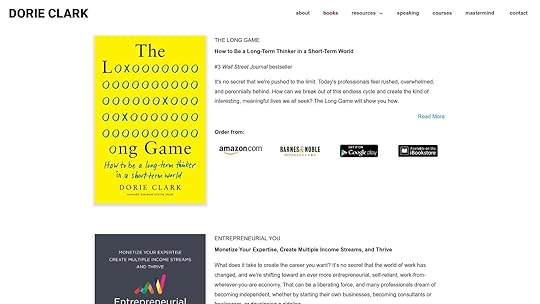
For leaders in the tech and startup world, building thought leadership is essential. This attracts talent, investors, and customers. Dorie Clark's "Stand Out: How to Find Your Breakthrough Idea and Build a Following Around It" offers a practical guide to achieving this. This book provides a clear framework for developing your personal brand and gaining recognition.
This book goes beyond surface-level advice. It digs into the specifics of identifying your area of expertise. It also guides you on creating compelling content and sharing it strategically. Clark combines thorough research, interviews with successful thought leaders, and practical exercises to help you along the way.
Key Features and BenefitsStructured Idea Development: The book provides a step-by-step process for identifying your unique strengths. You'll learn to use these strengths to create resonant ideas. This is particularly helpful for startup founders disrupting existing markets.
Brand Building Strategies: The book offers a variety of tools for building a loyal following. These range from online platforms like social media and blogging to offline tactics like speaking engagements and networking.
Real-World Examples: Learn from case studies of successful thought leaders. These examples offer inspiration and show the book’s principles in action.
Practical Application: The book includes actionable exercises. This helps you apply the concepts to your own circumstances, ensuring you see tangible results.
Content Repurposing: Learn how to extend the reach of your content. The book covers repurposing across multiple platforms, a valuable strategy for busy entrepreneurs.
Pros and ConsHere's a quick overview of the book's strengths and weaknesses:
ProsConsActionable advice and real-world examplesSome strategies require significant time commitmentApplicable methodology across industriesCan be challenging for introverted personalitiesIncludes both online and offline strategiesSome case studies might feel datedWritten in an accessible and engaging stylePutting It Into PracticeHere are a few tips for implementing the book's strategies:
Self-Assessment: Start by identifying your strengths and passions. This is the foundation of a strong personal brand.
Focused Approach: Don't try to do everything at once. Begin with one or two key strategies that suit your strengths and available resources.
Consistency is Key: Building a following takes time and consistent effort. A content calendar can help you stay on track.
Track and Adjust: Monitor your results and adapt your strategy based on what's working and what's not.
Visit Dorie Clark's Website for more information about her books.
The book's price varies by retailer and format. However, it's a valuable investment for leaders who want to increase their influence. The book has no technical requirements. "Stand Out" offers a unique, actionable framework and focuses on developing fresh ideas. This makes it an excellent resource for those seeking to create a lasting impact.
2. Purple Cow: Transform Your Business By Being Remarkable
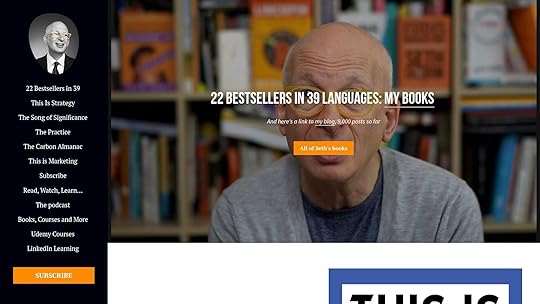
For CTOs, CEOs, startup founders, and entrepreneurs looking to make a real impact, Seth Godin's Purple Cow: Transform Your Business by Being Remarkable is essential reading. This book advocates for a fundamental shift in how we think about marketing: ditch the ordinary and become remarkable. In a world overflowing with options, playing it safe is actually the biggest risk.
Purple Cow challenges traditional mass marketing strategies. It champions the creation of inherently remarkable products and services that generate their own buzz.
Why "Purple Cow" MattersIn a market saturated with similar products, traditional marketing often fails. Purple Cow argues that cutting through the noise requires being inherently remarkable – something worth talking about. This resonates particularly with startups and innovative companies looking to disrupt existing markets.
The focus shifts from large marketing budgets to creating products and services so unique and compelling that they essentially market themselves.
Key Features and BenefitsFramework for Remarkable Products: Godin provides a framework for identifying and developing products that truly stand out. He encourages readers to think differently about product development, pushing beyond incremental improvements towards genuinely innovative solutions.
Case Studies: The book is packed with real-world examples of companies that have successfully embraced the "purple cow" philosophy, demonstrating the power of remarkability across various industries.
Practical Advice for Differentiation: While focusing on the conceptual shift, the book also offers practical tips on differentiating your offerings and finding your unique "purple cow."
Word-of-Mouth Marketing: Godin highlights the importance of word-of-mouth marketing, especially in the age of social media, and provides strategies for leveraging this powerful tool.
Modern Marketing Tactics: Recognizing the declining effectiveness of traditional advertising, Purple Cow explores alternative strategies better suited for today's consumer.
Pros and Cons of "Purple Cow"Let's look at the strengths and weaknesses of Godin's approach:
FeatureDescriptionPros:Core ConceptConcise and memorable, making the book's message stick.Real ExamplesNumerous case studies illustrate the concept and inspire readers.Fresh ThinkingChallenges conventional marketing wisdom with a thought-provoking perspective.Quick ReadHigh-impact message delivered concisely.Cons:Outdated ExamplesSome cited examples may not resonate with the current market.ImplementationLight on concrete implementation guidance.OversimplificationCan sometimes oversimplify complex market dynamics.Implementation TipsBrainstorming: Use the "purple cow" concept to brainstorm with your team. Challenge yourselves to find ways to make your product or service truly remarkable.
Customer Feedback: Gather feedback from your target audience to understand what they find unique and valuable.
Iteration: Don't be afraid to experiment and iterate on your offerings. Finding your "purple cow" is an ongoing process.
Purple Cow Website
While Purple Cow might not offer a step-by-step guide to marketing success, it offers a powerful and essential shift in thinking for anyone looking to create truly remarkable products and services. Its value lies in challenging conventional thinking and inspiring innovative marketing approaches. This is a valuable resource for anyone looking to differentiate themselves in a competitive market.
Made To Stick: Communicating Effectively
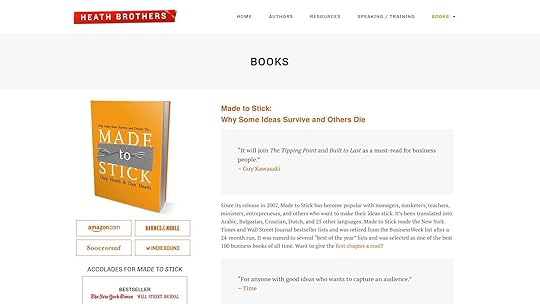
Clear communication is essential for leaders, especially CTOs, CEOs, startup founders, and entrepreneurs. Whether you're pitching investors, motivating your team, or engaging customers, your message must be impactful. Chip and Dan Heath's book, Made to Stick: Why Some Ideas Survive and Others Die, provides a valuable framework for achieving this.
This book stands out due to its practical, research-based approach to crafting communications that truly resonate. It provides a simple yet powerful framework – SUCCESS – for building memorable and persuasive messages.
The SUCCESS FrameworkThe SUCCESS framework provides six key principles for making your ideas stick:
Simple: Get to the core of your message. For example, a startup founder might simplify a complex technology into a clear value proposition.
Unexpected: Capture attention by surprising your audience. A CTO explaining a new system could use an analogy to make it relatable.
Concrete: Use specific language and imagery. Instead of discussing abstract "efficiency," a CEO might quantify impact with real-world data.
Credible: Support claims with evidence. Entrepreneurs can strengthen pitches with data, testimonials, or pilot program results.
Emotional: Connect with your audience on a personal level. A founder sharing their story can resonate with potential investors.
Stories: Frame your message within a narrative. A compelling customer story is often more persuasive than a list of features.
Beyond the Framework"Made to Stick" goes beyond just the SUCCESS framework, exploring the psychology behind memorable ideas. It uses diverse case studies to illustrate these principles and offers practical techniques for applying them. There are even templates for crafting sticky messages.
Pros and Cons of "Made To Stick"Here's a breakdown of the book's strengths and weaknesses:
ProsConsResearch-backed strategiesSome concepts overlap with other marketing textsApplicable across various fieldsCan feel formulaic if applied too rigidlyEngaging storytellingRequires creativity for effective implementationClear, actionable framework (SUCCESS)Accessibility and ValueThe book's insights are valuable for any leader aiming to communicate effectively. Regardless of format (physical book, ebook, or audiobook), "Made to Stick" offers valuable lessons. No technical expertise is required to benefit from this book, making it accessible to anyone wanting to improve their communication. By understanding and applying these principles, you can transform your ideas from forgettable to memorable, gaining a significant edge.
Steal Like An Artist: A Creative Boost For Business Leaders
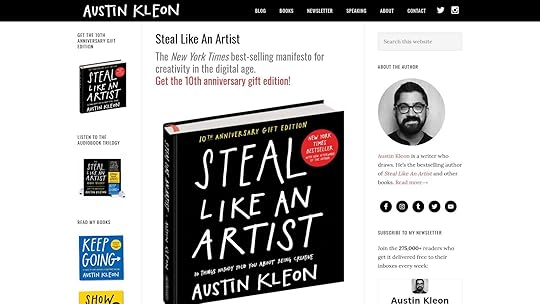
Austin Kleon's Steal Like an Artist isn't just a book; it's a fresh perspective on creativity. It's a helpful resource for anyone struggling with creative blocks, especially busy leaders like CTOs, CEOs, startup founders, and entrepreneurs. The book offers a practical approach to fostering creativity, a crucial skill for those constantly seeking innovative solutions. Kleon's core message is that creativity thrives on embracing influence, connecting ideas, and remixing inspiration to create something new.
Practical Applications For Business LeadersIdea Generation & Innovation: Kleon's "steal like an artist" philosophy encourages looking beyond conventional thinking. By inspiring teams to draw from diverse sources and blend seemingly unrelated concepts, businesses can cultivate innovation. This leads to the development of unique products, services, and marketing strategies.
Building A Strong Brand Identity: Finding your unique voice and sharing your work authentically are key to establishing a strong brand. This is particularly important for startups trying to stand out in a competitive market. Steal Like an Artist offers practical guidance on achieving this.
Improving Team Collaboration And Communication: The principles of sharing, remixing, and giving credit where it's due can significantly improve team dynamics. Openly sharing ideas and acknowledging individual contributions fosters a more collaborative and productive environment.
Content Creation And Marketing: Kleon's advice on effectively sharing work in the digital age offers valuable insights for content marketing. Building a genuine online presence and connecting with your audience is crucial in today's social media landscape.
Features And BenefitsTen Principles For Unlocking Creativity: The book provides a clear framework for navigating the creative process, from finding inspiration to sharing your finished work.
Techniques For Finding Inspiration: Kleon offers practical exercises for cultivating curiosity and drawing inspiration from everyday life and various fields.
Methods For Developing Creative Habits: Steal Like an Artist emphasizes the importance of regular creative practice. It provides strategies for establishing sustainable habits.
Strategies For Sharing Work Effectively: The book offers actionable advice on building an online presence, engaging your audience, and sharing your work ethically while building your brand.
Visually Engaging Presentation: The illustrated format makes it an enjoyable and accessible read, perfect for busy individuals.
Pros & ConsPros: Concise and easy to understand, inspirational and practical, visually appealing, applicable to various creative fields.
Cons: May be too basic for experienced creatives, some advice might seem obvious to seasoned professionals, the short length limits deeper exploration of certain topics.
Pricing And AvailabilityAvailable in various formats (physical, ebook, audiobook) from major online retailers like Amazon. Prices vary.Similar ResourcesShow Your Work! by Austin Kleon (focuses on sharing your creative process) Keep Going by Austin Kleon (emphasizes maintaining momentum and overcoming creative blocks) The War of Art by Steven Pressfield (addresses resistance to creative work)Implementation TipGift Steal Like an Artist to your team and facilitate a discussion around its key principles. This can spark valuable conversations about creativity and innovation within your organization.
Websitehttps://austinkleon.com/steal/
This book is a valuable tool for anyone wanting to cultivate a more creative mindset and develop effective strategies for sharing their work. Its concise and practical approach makes it a worthwhile read for busy leaders seeking to bring more innovation and creativity into their work.
Positioning Your Product: Winning the Minds of Your CustomersIn a crowded marketplace, getting your message heard by the right people is a significant challenge. "Positioning: The Battle for Your Mind" by Al Ries and Jack Trout offers a proven framework for achieving just that. This marketing essential introduces the idea of positioning – influencing how potential customers perceive your product. It’s about crafting a clear, concise, and persuasive message that resonates with your audience and solidifies your brand in their memory. This book remains invaluable because its core principles hold true even in today’s dynamic market.
Why Positioning Matters for Business LeadersWhether you're launching a new product, entering a new market, or simply seeking a competitive advantage, understanding positioning is paramount. For CTOs, this means developing products that align with the intended market position. CEOs can use positioning to steer overall business strategy. Startup founders can define their niche and attract early adopters. And entrepreneurs can build strong, recognizable brands.
Key Features and Benefits of "Positioning"A Practical Framework for Positioning: The book provides a step-by-step guide to analyzing your market, understanding your competitors, and developing a unique position that connects with your target audience.Strategies for Achieving Market Leadership: Discover how to position your product as the leader in its category, even if you're not the first to market.Effective Competitive Analysis: Learn how to analyze your competitors' positioning and uncover opportunities to set yourself apart.Managing Brand Perception: Take control of the narrative surrounding your brand and influence how customers perceive your products or services.Real-World Examples of Successful Positioning: Gain insights from case studies of companies that have effectively leveraged positioning to achieve market dominance.Pros of Reading "Positioning"Enduring Principles: The core concepts of positioning remain highly relevant in today’s marketplace, despite the book’s original publication in 1981.Clear and Concise Writing: The book is easily digestible, even for those without a background in marketing.A Groundbreaking Approach to Marketing: This work has fundamentally altered how companies approach marketing and brand building.Universally Applicable: Whether you’re a small startup or a large corporation, the principles of positioning can contribute to achieving your marketing objectives.Cons to ConsiderDated Examples: Some of the specific examples may feel a little outdated.Limited Digital Context in Older Editions: Opt for a more recent edition to gain updated perspectives on the digital landscape.Potential Oversimplification: Market dynamics can be complex. While positioning is a powerful tool, it’s essential to acknowledge this complexity.Tips for Implementing Positioning StrategiesBegin with Comprehensive Competitive Analysis: Before defining your position, thoroughly analyze your competitors' strengths, weaknesses, and market perception.Embrace Simplicity: A clear and concise message is crucial for cutting through the noise.Maintain Consistency: Once you’ve defined your position, ensure your marketing efforts consistently reinforce that message.Pricing and Availability"Positioning" is available online and in bookstores. Pricing varies depending on the format (print, ebook, audiobook). Positioning: The Battle for Your Mind
Comparison with Other Marketing BooksWhile many marketing books address branding and differentiation, "Positioning" focuses specifically on establishing your product in the customer’s mind, providing a uniquely impactful framework.
This book is more than just a good read; it’s a crucial investment in creating a lasting brand. By understanding and implementing the principles of positioning, you can differentiate yourself from competitors, connect with your target audience, and win the battle for their attention.
Finding Your Difference: A Review of Bernadette Jiwa's Marketing Guide
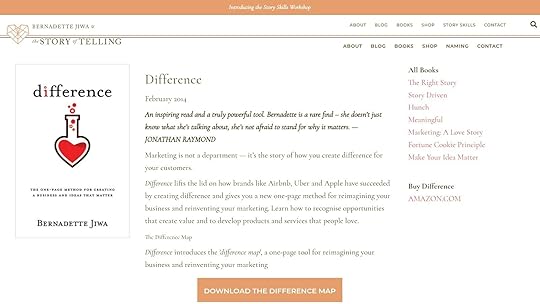
Bernadette Jiwa’s Difference: The One-Page Method for Reimagining Your Business and Reinventing Your Marketing offers a refreshing approach for those looking to make a real impact. Aimed at CTOs, CEOs, startup founders, and entrepreneurs, this book provides a practical framework for navigating the challenges of a competitive market. Central to this framework is the “Difference Map,” a one-page tool designed to help businesses pinpoint and articulate their unique value.
This isn't your typical marketing guide. Instead of focusing on surface-level features and benefits, Jiwa emphasizes understanding the emotional drivers behind customer decisions. This customer-centric approach helps businesses connect with their target audience on a much deeper, more meaningful level. The book guides readers through a process of discovering what truly resonates with their customers and translating those insights into compelling brand stories.
Key Features and BenefitsOne-Page Difference Map Methodology: This straightforward yet powerful tool offers a structured way to define your unique value proposition. It helps you articulate how your product or service addresses specific customer needs, particularly focusing on the emotional aspects.
Focus on Emotional Value Creation: The book underscores the importance of understanding your target market's emotional landscape. By identifying the feelings your product or service evokes, you can craft marketing messages that truly resonate.
Customer-Centered Innovation Framework: Difference encourages a shift towards customer-centricity, promoting innovation driven by a deep understanding of customer needs and aspirations.
Brand Storytelling Techniques: Jiwa offers practical guidance on creating compelling narratives that connect with your target audience and communicate the emotional value you offer.
Implementation Exercises and Questions: The book includes practical exercises and insightful questions to help you implement the Difference Map and develop a truly differentiated brand.
Pros and Cons of DifferencePros:
Practical and Applicable Methodology: The Difference Map provides a tangible framework easily applied to various business situations.Emphasis on Customer Empathy: The book champions a customer-centric approach, encouraging businesses to prioritize understanding their target audience's emotional needs.Concise and Actionable Format: Difference is straightforward and easy to read, allowing for quick implementation of key concepts.Suitable for Businesses of All Sizes: Whether you’re a startup or a large organization, the principles presented in Difference can be adapted to your specific requirements.Cons:
Potential Oversimplification for Complex Organizations: Larger organizations with intricate structures might need additional tools and strategies to fully implement the framework.Requires Thorough Customer Research: The Difference Map's effectiveness depends on a deep understanding of your customer base, necessitating dedicated research and analysis.Limited Technical Marketing Tactics: The book focuses primarily on strategic differentiation rather than specific technical marketing execution.Tips for Implementing the Difference MapInvest Time in Customer Research: Don’t rush the process. Thorough research is crucial to uncover your customers' true needs and motivations.Encourage Team Collaboration: Engage your team in the Difference Map exercise to ensure buy-in and gather diverse perspectives.Regularly Review and Refine: Customer understanding evolves over time. Revisit and refine your Difference Map as needed.Where to Find DifferenceYou can learn more about the book on Bernadette Jiwa’s website: https://thestoryoftelling.com/difference/. While pricing isn't listed on the site, Difference is widely available from major online retailers. The methodologies don't require any specific technical setup. Compared to tools like the Value Proposition Canvas or Business Model Canvas, Difference emphasizes the emotional drivers of customer decisions, making it a valuable resource for any entrepreneur.
7. Blue Ocean Strategy: Charting a Course to Uncontested Market Space
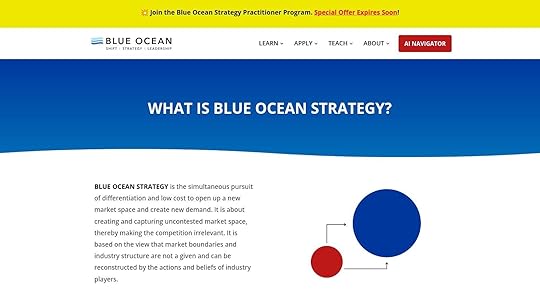
For leaders looking to disrupt their industries – CTOs, CEOs, startup founders, and entrepreneurs alike – Blue Ocean Strategy by W. Chan Kim and Renée Mauborgne presents a compelling framework. This book earns its place on our list by offering a practical methodology for creating "blue oceans." These are uncontested market spaces brimming with opportunity, a stark contrast to the overcrowded and competitive "red oceans" many businesses find themselves battling in.
Instead of simply striving to outperform the competition, Blue Ocean Strategy emphasizes value innovation. This involves creating a significant leap in value for both buyers and the company itself, unlocking new and uncharted market territory.
Key Tools and FrameworksBlue Ocean Strategy provides several tools and frameworks to guide this process:
The Blue Ocean Strategy Canvas: This valuable visual tool helps map the existing market landscape. It allows you to analyze your offering against competitors' across key factors, visually identifying opportunities to differentiate and create new value.
The Four Actions Framework: This framework helps reshape your value curve by asking four crucial questions: Which factors should be eliminated? Which should be reduced? Which should be raised? And finally, which factors should be created that the industry has never offered?
The Value Innovation Framework: This framework emphasizes aligning innovation with utility, price, and cost. It challenges the traditional trade-off between differentiation and low cost, encouraging a pursuit of both.
Practical Applications and Use CasesStartups: Blue Ocean Strategy offers a roadmap for new ventures. It helps define a unique value proposition and avoid direct competition with established players.
Established Companies: This framework can revitalize existing products or services. It helps identify new growth avenues and break free from incremental innovation in saturated markets. Consider Apple's introduction of the iPod and iTunes, a classic blue ocean move that revolutionized how we consume music.
Non-profit Organizations: The principles of Blue Ocean Strategy can be applied to achieve social impact. They encourage addressing unmet needs and developing innovative solutions to complex societal challenges.
Implementation TipsDedicate Resources: Implementing Blue Ocean Strategy requires a committed team and strong organizational support. It represents a significant strategic shift, not a quick fix.
Start Small: Begin by applying the framework to a specific product line or market segment. Gain practical experience and internal momentum before expanding across the organization.
Embrace Experimentation: Creating new markets involves inherent uncertainty. Be prepared to adapt, iterate, and learn from setbacks.
Pros and ConsPros:
Comprehensive and research-backed strategic frameworkPractical tools for implementationOffers a new perspective on competitionCons:
Challenging to implement, especially in established organizationsRequires significant buy-in across the organizationPast successes may not be easily replicatedLearn more about Blue Ocean Strategy
While Blue Ocean Strategy doesn't offer a guaranteed path to success, it provides a powerful and structured approach to identifying and capitalizing on untapped market opportunities. By challenging conventional strategic thinking and fostering a culture of innovation, organizations can create their own blue oceans and achieve sustainable growth. The book focuses on methodology and framework, not specific software or tools with associated pricing or technical requirements. The official website offers further resources and workshops.
8. Contagious: Why Things Catch On
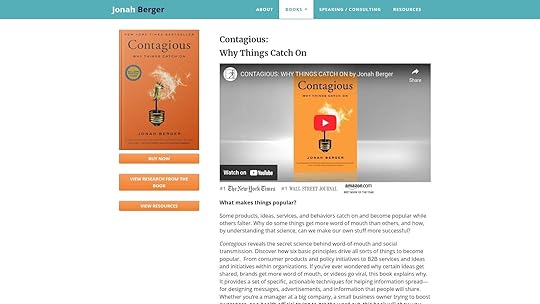
For CTOs, CEOs, Startup Founders, and Entrepreneurs, understanding why some products and ideas take off is essential for making a real impact. Jonah Berger's "Contagious: Why Things Catch On" provides a practical, research-backed framework for building virality. This makes it an invaluable resource for anyone developing a product, service, or brand. This book earns a place on our list by offering actionable insights into how things spread through social networks, empowering you to create compelling content that resonates with your audience.
What sets this book apart? It introduces the STEPPS framework: Social Currency, Triggers, Emotion, Public, Practical Value, and Stories. This framework deconstructs the core elements that drive viral spread. Berger doesn't simply present theories; he supports his points with engaging case studies and tangible examples of how to apply each principle.
Features and BenefitsSTEPPS Framework: This model gives you a structured approach to analyzing and building virality into your product and marketing efforts.
Research-Based Principles: The book's principles are rooted in scientific research, providing a reliable basis for understanding how things catch on.
Actionable Techniques: "Contagious" offers practical advice and methods for applying each principle within the STEPPS framework, allowing you to easily put these learnings into practice.
Real-World Examples: The book shares case studies of both viral successes and failures, giving you valuable takeaways and lessons.
Practical Applications and Use CasesProduct Development: Use the STEPPS framework to create products with built-in viral potential. Think about how to weave Social Currency or Practical Value into your product's core functions.
Marketing Campaigns: Build marketing messages that trigger emotions, leverage social cues, and offer practical value. This will encourage sharing and generate buzz.
Content Creation: Craft content that tells captivating stories and provides Social Currency, increasing the likelihood of it being shared and discussed among your target audience.
Internal Communication: Apply the principles of contagiousness to enhance internal communications and build a more cohesive company culture.
ProsGrounded in scientific research, giving credibility to the strategies.Offers practical and actionable advice for immediate implementation.Uses an engaging storytelling style that makes complex ideas accessible.Applicable to a broad range of products, services, and ideas.ConsThe social media environment has shifted since the book's release, so some tactics may need adjusting.
The effectiveness of some principles depends on the particular situation.
While the book offers a valuable framework, achieving true virality is still a complex undertaking.
Comparison with Similar ToolsWhile other books and resources explore marketing and virality, "Contagious" distinguishes itself through its research-driven approach and practical STEPPS framework. It offers a more structured and scientific method than general marketing guides.
Implementation/Setup TipsBegin by fully grasping the STEPPS framework.
Analyze effective viral campaigns and determine which STEPPS principles were used.
Test various tactics and monitor their results.
Tailor the principles to your specific situation and audience.
Where to Find ItWebsite: https://jonahberger.com/books/contagious/
While pricing isn't listed here, the book is widely available online and in bookstores. There are no particular technical needs to benefit from its insights. "Contagious" is a worthwhile investment for any leader aiming to broaden their reach and achieve substantial impact.
This Is Marketing: Seeing Through Your Customer's Eyes
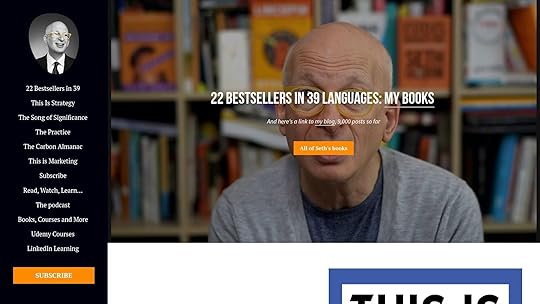
Seth Godin's This Is Marketing: You Can't Be Seen Until You Learn to See offers a valuable perspective for business leaders. Whether you're a CTO, CEO, startup founder, or entrepreneur, this book provides a refreshing take on marketing. It moves beyond simple tactics and delves into the psychology of connecting with your audience.
This isn't about manipulation. Instead, Godin focuses on truly serving your audience. This means understanding their needs, desires, and the cultural context surrounding your product or service. It's about building genuine connections that lead to sustainable growth.
Practical Applications and Real-World ExamplesFinding Your Niche: The concept of the smallest viable audience allows you to concentrate your marketing efforts. This targeted approach maximizes impact, especially valuable for startups with limited resources. CTOs can then use this focused audience information to prioritize development efforts.
Cultivating Loyalty: Building a loyal customer base is essential for long-term success. By focusing on value and trust, CEOs can create a community of advocates around their brand. Godin’s emphasis on ethical marketing further strengthens this positive brand image.
Strategic Product Placement: For entrepreneurs, navigating a crowded marketplace can be challenging. This Is Marketing offers frameworks for effectively positioning new products or services. This clarity helps attract investors and secure those crucial early adopters.
Crafting Your Marketing Message: Understanding status and affiliation dynamics is key to effective marketing. This book helps founders craft messages that resonate with their target audience's aspirations and values, leading to stronger engagement.
Key Features and AdvantagesPermission Marketing: Build relationships by earning attention, not demanding it.Smallest Viable Audience Identification: Concentrate resources on a dedicated core group.Status and Affiliation Dynamics: Tap into the psychology of belonging to create compelling messaging.Brand Positioning Strategies: Define a unique space for your brand within the market.Ethical Marketing Principles: Prioritize customer well-being to build a sustainable business.Pros and Cons: A Balanced ViewPros:
Human-Centered Approach: Emphasizes genuine connection and value creation.Ethical and Sustainable: Promotes responsible marketing practices.Universally Applicable: Offers insights for businesses of all sizes.Concise and Impactful: Distills decades of marketing wisdom into an accessible format.Cons:
Less Tactical: Focuses on strategy over specific tactics.Requires Reflection: Some sections may require deeper thought and application.Long-Term Strategy: Building genuine connections requires time and effort.Website
While the price varies depending on the format, the investment in this book is small compared to the potential returns. There are no technical requirements to access the content. Unlike tactical guides, This Is Marketing presents a holistic philosophy. It encourages a shift from interruption to connection. For the greatest benefit, dedicate time to reflect on the concepts and apply them to your specific business context. This book isn't about quick wins, but about building a sustainable, value-driven marketing approach.
Building a Community-Led Business With Corey Haines' Broke ThroughIn the competitive business world, a great product alone isn’t always enough. Building a thriving community can be the key to sustainable growth and true brand loyalty. Corey Haines' Broke Through: The Actionable Guide to Building a Community-Led Business provides a practical roadmap for achieving this. This book stands out by offering a modern, actionable framework for using community as a core business driver, particularly for digital products and SaaS businesses.
This book isn't theoretical. It’s based on Haines' experience with successful brands like Baremetrics and SavvyCal. He breaks down building a community-led business into manageable steps. These cover everything from identifying your target audience and fostering engagement to monetizing your community and assessing its overall health.
Key Features and BenefitsCommunity-Building Frameworks: Discover proven models for structuring and expanding your community.Audience Development Strategies: Pinpoint your ideal community member and attract the right individuals.Engagement and Retention Tactics: Learn how to keep your community active and invested.Community Monetization Models: Explore diverse ways to generate revenue from your community, beyond typical product sales.Analytics and Measurement Approaches: Track key performance indicators (KPIs) to understand community health and pinpoint areas for improvement.Actionable Templates and Worksheets: Put the concepts into practice with the resources provided.Practical Applications and Use CasesSaaS Startups: Boost customer retention and gain new users through community advocacy.Digital Product Creators: Validate product ideas, gather valuable feedback, and generate pre-launch excitement.Established Businesses: Strengthen customer relationships and cultivate a loyal brand following.ProsUp-to-Date Strategies: Addresses the particular challenges and opportunities of today’s digital businesses.Practitioner Insights: Benefits from Haines' practical experience and valuable knowledge.Actionable Resources: Provides tools to instantly implement the strategies discussed.Combined Approach: Emphasizes the synergy between product development and community building.ConsDigital/SaaS Focus: While the principles can be adapted, the main focus is on digital businesses.Limited Long-Term Case Studies: As a newer publication, long-term impacts haven't been extensively documented.Time Investment: Building a thriving community requires consistent, dedicated effort.Implementation TipsDefine your target audience and their needs.Focus on building genuine relationships and providing value.Be patient and consistent. Community building takes time.Pricing and Technical RequirementsThe book is available in both physical and digital formats. See the website for pricing. No specific technical requirements are needed to implement the strategies.
Website: https://www.coreyhaines.co/brokethrough
Broke Through is a valuable resource for CTOs, CEOs, startup founders, and entrepreneurs wanting to leverage community to build stronger, more sustainable businesses. By implementing these strategies, businesses can move beyond transactional interactions and create a loyal following of dedicated advocates.
Stand Out Books: Key ComparisonsTitleFramework ★Audience 👥Unique Selling Points ✨Value Proposition 💰Stand Out: How to Find Your Breakthrough Idea and Build a Following Around ItStep-by-step framework, case studiesEmerging thought leadersActionable & research-backedComprehensive guide for brandingPurple Cow: Transform Your Business by Being RemarkableRemarkable product creation, differentiationInnovative marketers & entrepreneursMemorable concept with real examplesChallenges conventional marketingMade to Stick: Why Some Ideas Survive and Others DieSUCCESS framework for sticky messagesMarketers & communicatorsScience-backed, engaging storytellingPractical sticky idea techniquesSteal Like an Artist: 10 Things Nobody Told You About Being Creative10 creativity principles, habit buildingCreative professionalsVisual, easily digestible insightsInspirational creative guidePositioning: The Battle for Your MindFoundational positioning strategyBusiness leaders & marketersTimeless principles, clear focusImpactful market positioningDifference: The One-Page Method for Reimagining Your Business and Reinventing Your MarketingOne-page Difference Map, emotional focusBrand strategists & innovatorsCustomer empathy-driven insightsConcise differentiation methodBlue Ocean Strategy: How to Create Uncontested Market Space and Make the Competition IrrelevantValue innovation & market creation frameworkStrategic leaders & innovatorsParadigm-shifting, research-rich approachSystematic strategy for new demandContagious: Why Things Catch OnSTEPPS framework for viralityMarketers & entrepreneursScience of social transmissionActionable viral marketing tacticsThis Is Marketing: You Can't Be Seen Until You Learn to SeePermission marketing & audience targetingEthical marketers & business ownersEmpathetic, humanistic approachDeep, sustainable marketing wisdomBroke Through: The Actionable Guide to Building a Community-Led BusinessCommunity-building & engagement tacticsDigital/SaaS businessesPractical templates with community focusUp-to-date strategies for digital growthElevate Your Marketing GameThese 10 essential marketing books offer a wealth of knowledge for revitalizing your strategies. They provide valuable insights into everything from crafting compelling stories to cultivating a loyal audience. However, selecting the right strategies and executing them effectively can be a challenge. Budget limitations, resource availability, and the expertise of your team all play a crucial role in successful implementation. Integrating these new concepts with your existing systems and workflows also requires careful planning.
When deciding which strategies from these books are right for you, consider your specific business objectives, your target audience, and the resources at your disposal. Start with small, manageable steps, experiment with different approaches, and closely monitor your results. Some strategies may require a larger investment than others, in terms of both time and money.
For example, developing a truly unique product, a so-called "Purple Cow" as described by Seth Godin, necessitates significant innovation and may involve research and development or product development costs. Seth Godin emphasizes the importance of remarkable products. On the other hand, implementing the "Made to Stick" principles outlined by Chip and Dan Heath can be achieved with focused messaging and adjustments to your content strategy. Chip and Dan Heath offer practical advice on making ideas memorable.
Compatibility with your existing brand is also key. Ensure that any new marketing approaches align with your current brand identity and overarching business strategy. Adopting a "Blue Ocean Strategy," which involves creating uncontested market space, might require a substantial shift in company direction. W. Chan Kim & Renée Mauborgne are the authors of the influential book on this topic. In contrast, integrating Seth Godin's principles from "This Is Marketing" could be incorporated more seamlessly into current operations.
Key TakeawaysFocus on Your Unique Value Proposition: Determine what sets you apart from the competition and center your marketing efforts around it.
Craft Compelling Narratives: Share stories that resonate with your target audience and create a lasting impression for your brand.
Build a Community: Actively engage with your customers and foster a loyal following.
Be Adaptable: The marketing world is constantly evolving, so be prepared to adjust your strategies as needed.
Ready to take your marketing to the next level and position yourself as a thought leader in your industry? Don't just read about success—create it. Bhavik Sarkhedi & Co. empowers founders, CEOs, and entrepreneurs to break through the clutter and capture attention. We develop personalized branding and content strategies that deliver tangible results. Let us help you tell your story, build influence, and achieve enduring success. Visit us today to discover how we can enhance your brand and propel your growth.
The post 10 Stand Out Books to Transform Your Marketing in 2025 appeared first on Bhavik Sarkhedi.
7 Reinventing Yourself Book Picks to Transform Your Life
As a CTO, CEO, startup founder, or entrepreneur, you understand the need to adapt. Markets change, new technologies appear, and we all grow as individuals. This requires us to regularly reassess our direction and rewrite our own narratives. Understanding the core principles of reinvention—how we identify opportunities, capitalize on strengths, and accept change—is essential for success. These concepts, rooted in ancient philosophies of self-discovery and honed by modern psychology and business strategy, provide a powerful framework for managing transitions and reaching ambitious goals.
The pursuit of self-improvement and reinvention has a long history, from the Stoics’ focus on resilience to current leadership theories on adaptability. An effective approach offers actionable insights, encourages self-awareness, and empowers individuals to make positive changes. Successful reinvention isn't about erasing your past; it’s about building upon your experiences, recognizing your potential, and consciously shaping your future.
Impactful Books for Reinventing YourselfIn this curated list, we’ll explore the most impactful books on reinvention. These books offer practical guidance and inspiration for leaders. Get ready to discover the tools and strategies that will empower you on your transformation journey, whether you're guiding your company through disruption, changing your career, or simply seeking greater purpose and fulfillment.
Reinventing Your Leadership: A Review of Steve Chandler's BookSteve Chandler's Reinventing Yourself offers practical guidance for those feeling stagnant and yearning for control over their life and career. This isn't your typical self-help book filled with empty promises. It delivers actionable strategies designed to shift your mindset from feeling like a "victim" to becoming an "owner." This is especially valuable for CTOs, CEOs, startup founders, and entrepreneurs constantly facing challenges and needing a proactive, solution-focused perspective.
Why does it deserve a spot on this list? In the demanding realm of leadership and innovation, maintaining a positive, proactive mindset is essential. Reinventing Yourself introduces a tangible structure—the "owner vs. victim" mentality—helping leaders recognize and dismantle limiting beliefs hindering their progress. This framework directly applies to navigating market uncertainty, managing teams, and making crucial decisions.
Key Features and BenefitsOwner vs. Victim Mindset: This core concept helps readers grasp how their perspective shapes their reality, empowering them to take charge of their outcomes. For a CEO, this could mean shifting from reacting to market forces to proactively shaping them. For CTOs, it might involve owning technical hurdles instead of blaming external factors.
Actionable Strategies: The book presents 17 specific strategies, including thought experiments and practical exercises, to help cultivate the "owner" mindset. These exercises can be readily incorporated into daily routines to manage stress, enhance decision-making, and foster a more proactive problem-solving approach.
Accessible Language: Chandler's conversational style, sprinkled with anecdotes and humor, makes these concepts easy to understand and apply, even for busy executives.
Pros and Cons: A Balanced ViewPros:
Direct and Actionable: The book's straightforward approach cuts through excuses and offers clear steps for immediate implementation.Engaging Writing Style: Humorous and relatable anecdotes create an enjoyable and memorable reading experience.Empowering: It emphasizes personal responsibility without being preachy, motivating readers to become active agents of change.Cons:
Oversimplification: Some readers, particularly those familiar with self-help books, might find some concepts a bit too simplified.Dated References: Some anecdotes and cultural references in older editions may feel dated, although the 20th Anniversary Edition offers updated material.Tips for Effective ImplementationActive Reading: Don't just passively read. Engage with the exercises and thought experiments. Consider journaling reflections and insights.
Consistent Application: The principles require consistent practice for lasting results. Integrate the strategies into your daily routine.
Focus on One Strategy at a Time: Don't try to implement all 17 strategies simultaneously. Select one or two that resonate and master them before moving on.
Comparing Reinventing Yourself to Other ResourcesWhile numerous self-help books address personal transformation, Reinventing Yourself stands out with its specific focus on the "owner vs. victim" mindset and its practical, action-oriented approach.
Availability and AccessThe book is available in various formats (physical, ebook, audiobook), with pricing varying by retailer. There are no technical requirements.
Website: https://stevechandler.com/books/reinventing-yourself/
Reinventing Your Leadership: A Look at Brian Tracy's Guide
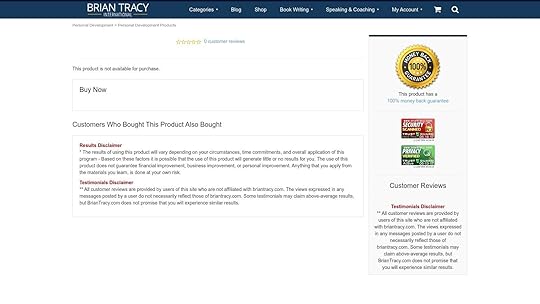
Brian Tracy's Reinvention offers a practical guide for leaders looking to transform their personal and professional lives. It’s particularly relevant for CEOs, CTOs, startup founders, and entrepreneurs facing industry shifts or seeking new directions. While many books delve into self-discovery, Reinvention provides a structured framework for turning reflection into action.
Tracy's seven-step reinvention process acts as a roadmap for navigating major life changes. From self-assessment and goal setting to action planning and implementation, the book equips readers with tools to manage change effectively. The career assessment tools are especially helpful for leaders evaluating their skills and exploring new opportunities. The strategic planning frameworks help analyze market trends and identify potential niches for career growth or new ventures.
Key Features and Benefits for LeadersStructured Approach: The seven-step process offers a clear path for reinvention, preventing overwhelm. This is especially helpful for busy executives.
Career and Business Focus: The book offers specific guidance for career transitions and entrepreneurial pursuits, including market analysis and identifying competitive advantages.
Practical Tools: Action-oriented templates and worksheets make planning and execution easier. This hands-on approach translates goals into concrete steps.
Financial Planning: The book addresses the financial aspects of career changes, a key consideration for entrepreneurs and those leaving established positions.
Emotional Support: Tracy recognizes the emotional challenges of significant life changes, providing strategies for managing these aspects of transformation.
Pros and Cons of ReinventionHere's a quick overview of the book's strengths and weaknesses:
FeatureDescriptionProsStructured approach, clear action stepsStrong guidance for career and business reinventionCombines motivational content with practical planning toolsAddresses the emotional aspects of major life changesConsAdvice may be less applicable to the nuances of the digital economyAssumes a certain level of resource availabilityFocus on conventional success metrics may not resonate with allTips for Implementing Tracy's StrategiesDedicated Time: Set aside focused time to work through the exercises and worksheets. Treat it as a project.
Customization: Adapt the frameworks and tools to your specific industry and career goals.
Mentorship: Consider working with a coach or mentor for accountability and support.
Visit Brian Tracy's Website for more information on Reinvention. Pricing is available on the website and from various booksellers. No technical requirements are needed to use the book. Reinvention is a valuable resource for leaders seeking a structured path to personal and professional transformation. While some adaptation may be necessary for today's dynamic markets, the core principles and practical tools can empower individuals to shape their future and achieve meaningful change.
Designing Your Life: A Practical Guide For LeadersAs a CTO, CEO, startup founder, or entrepreneur, you’re probably already familiar with design thinking in business. But have you ever thought about applying it to your personal life? "Designing Your Life" by Bill Burnett and Dave Evans presents a practical framework for doing just that. This book stands out by offering a structured, iterative approach to personal growth, similar to the agile methodologies you might use in product development.
Instead of promising quick fixes, "Designing Your Life" empowers you to experiment with different paths and make decisions based on real-world experience. It’s not about throwing everything away and starting over. It’s about making small changes and working towards a more fulfilling life, one step at a time.
Key Features and BenefitsDesign Thinking for Life: Apply familiar design thinking principles like ideation, prototyping, and testing to explore potential career changes, personal projects, or lifestyle adjustments. Think of it as A/B testing for your life!
Actionable Exercises: The book is packed with practical exercises, including Odyssey Plans for envisioning multiple possible futures and Mind Mapping for exploring different areas of your life. The Good Time Journal helps you identify activities that truly energize you, providing valuable data for a more fulfilling daily routine.
Overcoming Decision Paralysis: For leaders used to making big decisions, the book provides frameworks for dealing with uncertainty and overcoming decision paralysis. The concept of failure immunity encourages experimentation and reframes setbacks as learning experiences.
Real-World Examples: Learn from others who have successfully used these techniques through case studies from the authors' popular Stanford course.
Practical Applications for LeadersStrategic Life Planning: Use the Odyssey Plan exercise to explore different career paths, balancing ambition with personal well-being. This is especially useful for evaluating long-term goals and ensuring they align with both your professional and personal aspirations.
Team Building & Culture: Introduce the principles of "Designing Your Life" to your team to build a culture of growth and experimentation. This can empower team members to take charge of their professional development and contribute to a more innovative and adaptable work environment.
Work-Life Integration: The Good Time Journal can help you find activities that contribute to a healthy work-life balance. By understanding your energy levels and engagement patterns, you can optimize your schedule and prioritize activities that promote both productivity and well-being.
Pros and ConsPros:
Fresh, design-based approachFocuses on testing and prototyping for improvementBacked by research and proven resultsStructured exercises with clear guidanceCons:
Some exercises require time and reflectionDesign terminology might take some getting used toLess focus on spiritual aspects of personal growthWebsite
"Designing Your Life" provides a concrete, actionable method for personal and professional growth, making it a valuable resource for any leader looking to create a more fulfilling life. Start by setting aside time for the exercises and embrace the process of iteration. You might be surprised by the insights and opportunities you discover.
Who Moved My Cheese? A Guide for Adaptable LeadersFor busy leaders in the fast-paced world of business, adapting to change is essential. Spencer Johnson's Who Moved My Cheese? offers a simple yet powerful parable to help CTOs, CEOs, startup founders, and entrepreneurs not just survive change, but thrive in it. This book's strength lies in its ability to present complex ideas in a digestible and memorable format, perfect for time-constrained individuals.
The Story and Its ApplicationsThe book uses an allegory of mice and "Littlepeople" searching for cheese in a maze to represent the pursuit of goals and happiness. When the cheese disappears, their reactions highlight the importance of mindset and adaptability. This metaphor applies to several business scenarios:
Pivoting Business Strategy: Like characters clinging to the old cheese location, companies can stagnate by resisting market shifts. Who Moved My Cheese? encourages proactively anticipating and adapting to change.Embracing Technological Advancements: The disappearing cheese can symbolize outdated technology. The book prompts leaders to "smell the cheese often"—monitor the tech landscape and adopt new tools.Navigating Market Disruptions: Unexpected competition or economic downturns can feel like the cheese vanishing. The book empowers leaders to adapt and seek new opportunities, rather than succumbing to fear.Managing Team Morale During Transitions: Change can unsettle teams. This book provides a shared language and framework for discussing change, promoting resilience and a proactive mindset.Features and BenefitsConcise and Accessible: The allegorical format makes it a quick read (under 100 pages), ideal for busy schedules. Its simple language makes it accessible to everyone, facilitating company-wide engagement.
Memorable Principles: Concepts like "Move with the Cheese" and "Smell the Cheese Often" are easily remembered and applied long after reading.
Discussion Catalyst: The book includes discussion guides, making it a valuable tool for team meetings and workshops, fostering shared understanding and proactive adaptation. Anniversary editions often include reader success stories and implementation guides.
Pros and ConsProsConsExceptionally accessibleMessage may be oversimplified for someMemorable story formatFewer concrete action stepsQuick read with lasting impactParable format may not appeal to allPricing and AvailabilityWho Moved My Cheese? is widely available in paperback, hardcover, audiobook, and ebook formats. Prices vary depending on the format and edition.
Comparing Who Moved My Cheese?While other books offer more detailed guidance on navigating change, Who Moved My Cheese? excels in providing a foundational understanding of the psychology of change and the importance of adaptability. It's an excellent starting point before exploring more complex change management methods.
Implementing the PrinciplesFacilitate a team discussion around the book's key principles. Encourage team members to share examples of how they've "moved with the cheese" and brainstorm how to apply these principles to current challenges.
Who Moved My Cheese? Website
Atomic Habits: A Framework for Continuous Improvement
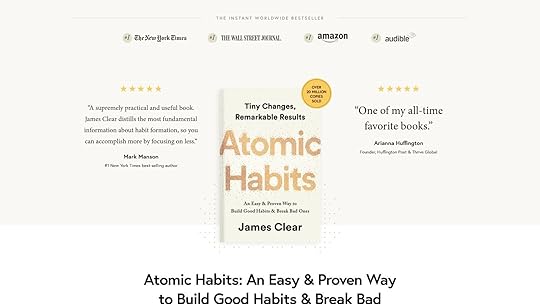
For leaders like CTOs, CEOs, and startup founders, adapting to change is critical. Atomic Habits by James Clear provides a practical framework for personal and professional growth through small, consistent changes. It emphasizes systems over goals, a crucial concept for navigating today’s business challenges.
This book stands out because of its research-backed approach to building habits. Clear’s Four Laws of Behavior Change—Make It Obvious, Make It Attractive, Make It Easy, and Make It Satisfying—offer actionable steps for creating positive habits and breaking bad ones. This system can help busy leaders become more productive and make better decisions.
Practical Applications for Business LeadersImproving Focus and Productivity: Use the Two-Minute Rule to overcome procrastination. This means making a new habit so easy that you can't say no. Examples include starting a daily coding practice or dedicating two minutes to reviewing important metrics.
Enhancing Team Performance: Habit stacking, or linking a new habit to an existing one, can improve team communication. For example, combine a daily stand-up meeting with a quick check-in on individual progress towards objectives.
Building a Culture of Continuous Improvement: The 1% better principle encourages incremental growth. Small, consistent improvements accumulate over time, leading to substantial gains in areas like product development and customer service.
Developing Leadership Skills: Focus on identity-based habits. Concentrate on who you want to become, rather than what you want to achieve. This creates a strong foundation for lasting change.
Features and BenefitsFour Laws of Behavior Change Framework: A practical system for creating and changing habits.1% Improvements: Highlights the power of small, consistent actions.Identity-Based Habits: Emphasizes internalizing desired behaviors for long-term change.Habit Stacking and Environment Design: Provides strategies for structuring your surroundings to support positive habits.Habit Tracking: While not in the book itself, the website offers resources and guidance on tracking your habits.Pros and ConsPros: Actionable strategies, systems-focused approach, and wide applicability across different areas of life.
Cons: Incremental approach (may not suit those seeking rapid change) and primarily behavior-focused (less emphasis on emotional aspects).
Final ThoughtsThe price of Atomic Habits varies depending on the format and retailer. However, the concepts within are highly valuable for leaders looking to improve themselves and their organizations. The book's power lies in its simplicity and accessibility. It offers a straightforward framework for continuous improvement and long-term positive change. Learn more about Atomic Habits
The Art of Possibility: A Fresh Perspective for LeadersFor CTOs, CEOs, Startup Founders, and Entrepreneurs, leading a team and making high-stakes decisions are daily occurrences. The Art of Possibility offers a unique approach to not just personal reinvention, but also the transformation of entire organizational cultures. Co-written by family therapist Rosamund Stone Zander and acclaimed conductor Benjamin Zander, this book transcends typical self-help, introducing twelve practices designed to unlock potential and cultivate a mindset of possibility.
Instead of concentrating on problem-solving, The Art of Possibility encourages possibility thinking. This is especially relevant for leaders tasked with fostering innovation and navigating uncertain situations. One practice, "Giving an A," involves preemptively empowering others through unconditional support. This can significantly improve team dynamics and build a culture of trust and high performance.
Another key practice, "Being a Contribution," encourages individuals to recognize their inherent value, regardless of external validation. This promotes intrinsic motivation and resilience. “Leading from Any Chair” is particularly valuable in fast-paced startup environments, empowering everyone to take ownership and initiative.
Blending Artistic Wisdom and Practical ApplicationThe book uniquely combines psychological insights with artistic wisdom, using metaphors and anecdotes from Zander’s conducting career. These illustrate the power of possibility. While the musical context adds a distinct flavor, the core principles apply universally. Newer editions even include QR codes linking to musical demonstrations, offering a deeper understanding of these concepts.
Features and Benefits of The Art of PossibilityTwelve Transformative Practices: Provides actionable frameworks for shifting perspectives and tackling challenges with renewed possibility.Arts-Based and Psychological Approaches: Offers a well-rounded perspective on personal and professional transformation.Real-World Applications: Practices are relevant for individual growth, team leadership, and shaping organizational culture."Giving an A" Framework: A potent tool for building trust and empowering teams.Focus on Possibility Thinking: Enables leaders to overcome limitations and imagine new horizons.Pros and ConsPros:
Refreshingly Different Approach: Offers a departure from traditional self-help, providing a unique perspective.Emphasis on Possibility Thinking: Fosters a proactive and innovative mindset.Compelling Storytelling: Engages readers with warmth, wisdom, and relatable examples.Applicable to Both Personal and Professional Life: Provides frameworks for reinvention in various contexts.Cons:
Mindset Shifts Can Be Challenging: Requires a willingness to embrace new perspectives and challenge existing beliefs.Less Structured: May not suit those seeking a step-by-step guide.Musical Metaphors: May not resonate with everyone.A Different Approach to Self-ImprovementUnlike prescriptive self-help books, The Art of Possibility emphasizes fostering a mindset shift rather than offering specific solutions. This aligns more closely with leadership philosophies focused on empowerment and vision.
Tips for ImplementationActive Engagement: Don’t just read passively; experiment with the practices in your daily life and work.Reflect on the Metaphors: Even without a musical background, the underlying principles offer valuable insights.Team Discussions: Consider integrating the principles into team meetings and discussions.The Art of Possibility earns its place on this list for its powerful and unique approach to reinvention. It cultivates a mindset of possibility essential for leaders in today’s dynamic world, empowering individuals to not only reinvent themselves but also inspire and transform their teams and organizations. While specific pricing isn’t readily available on the author’s site, the book is available from various online and physical retailers. There are no technical requirements to apply the principles presented.
Mindset: The Foundation For Reinvention

For leaders in the tech world, from CTOs and CEOs to startup founders and entrepreneurs, reinvention is essential. Adapting to market changes, integrating new technologies, and adjusting business strategies all demand a shift in how we think. Carol S. Dweck's Mindset: The New Psychology of Success provides the foundation for this transformation by exploring the contrast between fixed mindsets and growth mindsets. This book's value lies in its explanation of the psychological basis upon which successful reinvention is built.
Dweck argues that people with a fixed mindset believe their abilities are static. This can lead to a fear of failure and a hesitation to embrace challenges. On the other hand, individuals with a growth mindset believe their abilities can be developed through hard work and dedication. They view challenges as opportunities for growth and demonstrate greater resilience when facing setbacks. This mindset is key to navigating the complexities of the business world.
Practical Applications For Business LeadersHow does this translate to practical advice for business leaders? Let's look at some key areas:
Fostering Innovation: A growth mindset promotes experimentation and risk-taking. Leaders with this mindset create a culture where failure is a learning opportunity, allowing teams to explore new ideas and develop innovative solutions.
Adapting to Change: Markets are constantly evolving. A growth mindset enables leaders to see these changes as opportunities for learning and adaptation, allowing them to adjust strategies and stay ahead of the competition.
Building Resilient Teams: Promoting a growth mindset within teams creates a more adaptable and resilient workforce. Employees are empowered to take ownership of their development, embrace challenges, and persevere through difficulties.
Improving Leadership Effectiveness: A growth mindset can significantly enhance leadership effectiveness. By focusing on continuous improvement, leaders can inspire their teams to achieve greater levels of performance.
Features and Benefits of MindsetResearch-Backed Framework: The book's foundation is decades of research, providing a robust framework for understanding mindset.Self-Assessment Resources: The accompanying website (https://mindsetonline.com/whatisit/themindsets/index.html) offers tools to help you identify your current mindset.Practical Techniques: The book presents actionable strategies for developing a growth mindset, including language patterns and self-talk techniques.Evaluating the Book's Strengths and WeaknessesPros:
Scientifically rigorous approach.Applicable across various career stages.Offers value for both personal and leadership development.Cons:
May require additional resources for advanced business applications.Focuses more on the underlying mindset rather than concrete reinvention strategies.Implementing a Growth MindsetBegin with an honest self-assessment of your own mindset. How do you react to challenges and failures? Do you see them as opportunities or limitations? Consciously adopting growth mindset language and encouraging it within your team can initiate a culture of improvement. While the core concept is simple, true integration requires ongoing effort and self-reflection. Consider using the book in leadership programs or team workshops for greater impact.
7-Point Reinvention Book ComparisonTitleCore Features ★Strategic Approach 💰Audience 👥Unique Insights ✨Reinventing Yourself by Steve ChandlerOwner vs. Victim mindset; 17 actionable strategies & exercisesDirect, updated, action-focusedFounders, leaders, self-help seekersEmpowering anecdotes & accessible styleReinvention: How to Make the Rest of Your Life the Best of Your Life by Brian Tracy7-step process; career tools & templatesStructured, methodical & results-drivenMidlife changers, career transitionersClear action planning with emotional and financial focusDesigning Your Life by Bill Burnett & Dave EvansDesign thinking approach; life design exercises & prototypesIterative, creative frameworksInnovators, professionals, academicsEvidence-based methods with a fresh design perspectiveWho Moved My Cheese? by Spencer JohnsonAllegorical narrative; simple change principlesQuick, memorable, and accessibleAnyone facing changeIconic metaphor with enduring simplicityAtomic Habits by James Clear4 Laws of Behavior Change; habit stacking & tracking toolsSystematic, incremental improvementsHabit builders, high-performersScientific insights & identity-based habitsThe Art of Possibility by Rosamund Stone Zander & Benjamin Zander12 transformative practices; blend of arts & psychologyCreativity-focused, holistic approachCreative leaders, thinkersUnique "Giving an A" framework & warm storytellingMindset by Carol S. DweckFixed vs. Growth Mindset; research-backed toolsScientific, foundational mindset shiftLeaders, educators, self-developersDecades of research with universal applicationsChoosing the Right Book for Your ReinventionReinvention is a personal journey. Finding the right resources can make all the difference. Several excellent books offer guidance and practical advice on self-reinvention, each with a unique focus.
For cultivating a growth mindset, consider "Mindset" by Carol S. Dweck or "The Art of Possibility" by Rosamund Stone Zander and Benjamin Zander. If you're drawn to actionable strategies and building better habits, "Atomic Habits" by James Clear and "Designing Your Life" by Bill Burnett and Dave Evans are excellent choices.
For navigating change and uncertainty, the classic "Who Moved My Cheese?" by Spencer Johnson offers valuable insights. If you're seeking a comprehensive guide to reinvention, Brian Tracy's "Reinvention" provides a solid foundation. Finally, Steve Chandler's "Reinventing Yourself" offers a powerful approach to personal transformation by challenging conventional thinking.
Getting Started With Your Reinvention JourneyBeginning your reinvention journey is straightforward. Select a book that resonates with your current needs and interests. Dedicate specific time for reading and reflection. Actively apply the concepts and exercises presented in the book to your own life.
Keeping a journal can be invaluable. Use it to track your progress, record insights, and reflect on any challenges you encounter. Some books include specific exercises or activities, so be sure to allocate sufficient time and resources for these.
The Investment in ReinventionThese books are a relatively inexpensive investment in your personal and professional growth. Consider supplementing your reading with online resources, workshops, or coaching programs, depending on your budget and the level of support you desire.
Integrating Reinvention Into Your LifeIntegrating the concepts you learn into your daily life is essential for long-term transformation. Think about how the principles can be applied to your work, relationships, and personal goals. These books offer universal principles applicable to individuals from diverse backgrounds and industries.
Key Takeaways for Reinventing YourselfReinvention is a personal journey, and choosing the right resources can provide valuable guidance and support.Select books that align with your specific needs and learning style.Active implementation and consistent effort are key to successful reinvention.Consider supplementing your chosen book with other resources based on your budget and goals.Elevate Your Personal BrandReinventing yourself can be a catalyst for personal and professional growth. Developing a compelling personal brand and narrative requires strategic thinking. Bhavik Sarkhedi & Co. empowers founders, CEOs, and entrepreneurs to become thought leaders through strategic personal branding and content strategies. Transform your personal brand into a powerful asset and elevate your influence. Visit Bhavik Sarkhedi & Co. today to discover how they can help you articulate your unique value proposition and achieve lasting success.
The post 7 Reinventing Yourself Book Picks to Transform Your Life appeared first on Bhavik Sarkhedi.
March 2, 2025
Top 7 Reinventing Yourself Book Picks

Reinventing yourself books offer a potent mix of insightful advice and relatable personal stories. These stories often resonate deeply with readers navigating career changes, personal setbacks, or major life transitions. Engaging with these books can be more than just reading; it can spark meaningful personal change.
Many readers find comfort and inspiration in the experiences of others who have successfully overcome similar challenges. This feeling of connection can cultivate hope and empowerment, both crucial for self-discovery and transformation. Furthermore, these books often explore the psychology of change, giving readers a deeper understanding of their own internal processes.
The Science of Personal TransformationThese books often go beyond anecdotes, incorporating principles from psychology and personal development research. This helps readers understand the science behind building new habits and making lasting changes. By exploring concepts like neuroplasticity and cognitive restructuring, they provide readers with the tools to reshape their thinking and actions.
Practical Advice for Lasting ChangeReinventing yourself books often offer actionable strategies and practical exercises for immediate implementation. This emphasis on tangible steps distinguishes them from books offering only general inspiration. They aim to build a foundation for long-term growth, rather than providing fleeting motivation.
One example is James Altucher's Reinvent Yourself. This book offers practical strategies and includes stories of figures like Pope Francis and Eminem. Altucher, an entrepreneur and podcaster who has founded 20 companies, shares insights on overcoming failures and achieving success. Discover more insights about reinventing yourself. This structured approach empowers readers to put their new knowledge into action.
The Impact of Personal StoriesAuthors of these books often share their own personal transformations, adding authenticity and emotional depth to their work. They offer not just advice, but also a sense of companionship on the journey. This vulnerability helps readers feel understood and less alone in their struggles.
By sharing stories of resilience, authors demonstrate that change is possible, even amidst adversity. This encourages readers to view challenges not as obstacles, but as opportunities for growth and self-discovery. Ultimately, reinventing yourself books offer a powerful combination of knowledge, inspiration, and practical tools, making them valuable resources for positive change.
Essential Elements Of A Powerful Reinventing Yourself Book

A truly impactful book about reinventing yourself digs deeper than surface-level inspiration. It provides a solid framework to guide readers through real, lasting personal transformation. This blend of personal stories and actionable advice equips readers with the tools they need for change. Let's explore the core components that make these books so effective.
The Power Of Personal StorytellingMany compelling books on reinvention begin with authentic personal stories. These stories act like anchors, forging a connection between the author and the reader. They show, through real-life examples, that overcoming challenges and changing your life is possible. This resonates deeply with readers facing their own struggles, fostering a sense of hope and shared experience. This shared experience can be essential for building motivation.
Actionable Frameworks and StrategiesWhile personal stories inspire, actionable advice empowers. The best books on reinvention offer concrete strategies and practical frameworks. These tools translate abstract concepts into steps you can actually take, offering a roadmap for navigating your own reinvention. For example, a book might include exercises for identifying core values, setting attainable goals, or building resilience.
Balancing Internal and External ChangeEffective reinvention books acknowledge the equal importance of internal mindset shifts and external action steps. They address the psychological aspects of change, like developing self-awareness and overcoming limiting beliefs. They also guide readers in taking concrete actions to create tangible changes in their lives. This balanced approach addresses both the mind and the actions required for lasting personal growth.
Vulnerability, Resilience, and Realistic GoalsThese three elements—vulnerability, resilience, and realistic goals—are the foundation of any successful reinvention. A good book encourages readers to embrace vulnerability by honestly assessing their current situation. It helps build resilience by providing coping mechanisms for setbacks. And finally, it emphasizes the importance of setting realistic goals that create a sense of progress and prevent discouragement.
To understand these key components better, let's look at the following table:
Key Components Of Effective Reinvention Books
This table breaks down the essential elements found in the most impactful reinventing yourself books, helping readers quickly identify quality resources that offer both emotional support and actionable advice.
ComponentPurposeReader ImpactPersonal StorytellingConnects author and reader; demonstrates the possibility of changeInspires hope and motivationActionable Frameworks & StrategiesProvides concrete tools and techniquesEmpowers readers to take practical stepsBalancing Internal & External ChangeAddresses both mindset and actionFosters lasting transformationVulnerability, Resilience, & Realistic GoalsEncourages self-awareness, coping mechanisms, and achievable aimsCreates a strong foundation for lasting changeAs you can see, the best books combine inspiration and practical advice. This combination empowers readers to navigate their own reinvention journey effectively.
The concept of reinvention often involves learning from failures. Author Jim Carroll emphasizes that each setback is a step toward successful reinvention. His book, Now What? Reinvention and the Role of Optimism in Finding Your New Future, highlights this idea. He demonstrates how personal stories, even those not widely known, can inspire. Learn more about reinvention and optimism. This emphasizes the practical, actionable side of transformation.
Top Reinventing Yourself Books Reviewed

Looking to make a change? This section dives into powerful books designed to help you reinvent yourself. Each book offers unique perspectives and practical advice for personal transformation. We'll explore their strengths and help you find the perfect guide for your journey.
Finding The Right Book For Your JourneyA good self-help book can be like a trusted friend, offering guidance and inspiration when you need it most. But with so many titles available, choosing the right one can feel overwhelming. This review simplifies the process, offering insights into seven standout books on reinvention.
We'll explore the core message of each book, making it easier to identify which one resonates with your specific needs. This focused approach will ensure you choose a book that aligns with your personal goals.
Seven Books That Spark TransformationThis curated list explores a variety of approaches to reinvention, from career changes to personal growth. While we await the final titles and authors to populate the list, we will focus on the core subject matter for now, to give you a feel for the range of topics covered:
Book 1: (Insert Title and Author) – This book helps you navigate career transitions. It's ideal for mid-career professionals seeking new directions.Book 2: (Insert Title and Author) – This selection emphasizes building resilience. Its strength lies in its practical exercises and inspiring stories, making it perfect for those facing challenges.Book 3: (Insert Title and Author) – This book provides a step-by-step process for self-discovery. It's a valuable resource for anyone searching for meaning and purpose.Book 4: (Insert Title and Author) – This book focuses on improving relationships. It offers valuable insights for individuals looking to enhance their connections with others.Book 5: (Insert Title and Author) – This book offers practical advice on achieving financial independence, making it a great choice for aspiring entrepreneurs.Book 6: (Insert Title and Author) – This pick focuses on the importance of self-care and personal development. It's an excellent resource for those prioritizing their well-being.Book 7: (Insert Title and Author) – This book offers a unique perspective on unlocking creative potential. It's perfect for artists and anyone seeking to express themselves creatively.Beyond specific titles, real-life stories of transformation can be incredibly motivating. Reinvent Yourself: Stories of Transformation, available on Amazon, offers eight compelling narratives of resilience. These stories showcase the power of perseverance and remind us that reinvention is about thriving, not just surviving.
To help you make the best choice, we've created a comparison table summarizing the key features of each book:
Comparison Of Top Reinventing Yourself Books
This table compares the key features and benefits of the seven reviewed books, giving you a clear, side-by-side look at the unique strengths each title offers to help you make an informed choice.
This table highlights the diverse range of topics and target audiences, making it easier to choose the book that best suits your individual needs.
From Inspiration To ActionA truly effective self-help book doesn't just inspire; it empowers you to take action. Many books offer practical exercises for self-reflection, goal setting, and habit formation. This hands-on approach helps readers actively participate in their own transformation.
Choosing Your Reinvention CompanionThis review has provided a starting point for your reinvention journey. Now, consider your personal aspirations and challenges. Which book's message speaks to you the most? By carefully reflecting on your needs and the strengths of each book, you can select the perfect companion for your personal growth. This mindful selection will maximize the book's impact and support your journey toward a better you.

The power of a "reinventing yourself" book isn't just found within its pages. It's in the potential to inspire real change. This section explores how these books have helped people achieve personal and professional breakthroughs. Through compelling stories, we'll see the real-world impact of putting these books' advice into action.
From Stuck to Successful: Reinvention StoriesThese aren't just stories; they're examples of how change is possible. They show how people facing different challenges used the wisdom from these books to reshape their lives. Each story offers a unique look into the reinvention process, highlighting the struggles and successes along the way.
The Career Shift: Imagine a marketing executive feeling unfulfilled. After reading a book about identifying core values, she discovered her passion for sustainable living. She retrained and started a thriving eco-friendly business. This shows how aligning actions with values can bring career satisfaction.
Repairing Relationships: Think about a couple struggling with communication. Inspired by a book on relationship improvement, they started using active listening. This led to better communication and a renewed connection. Their story highlights the impact of practical advice on relationships.
The Growth Mindset: Picture someone struggling with self-doubt. Through a book on self-compassion, they learned to accept imperfections and focus on personal development. This story emphasizes the role of a positive mindset in creating change.
These examples, while fictional, reflect the real changes happening every day. They show that reinvention isn't one-size-fits-all. It's a personal journey shaped by individual needs and goals.
Unexpected InspirationReinvention isn't just personal. It impacts industries and communities. The comeback of independent bookstores is a great example. Between 2009 and 2018, the number of independent bookstores in the US grew by a remarkable 49%, from 1,651 to 2,470 stores. This growth, driven by community involvement and personalized experiences, demonstrates reinvention in retail. Find more statistics here. It shows how adapting to change can lead to surprising success.
The Power of TransformationThese real-life examples highlight the impact of "reinventing yourself" books. They're more than theory; they provide actionable steps towards meaningful change. By learning from others, readers gain confidence and motivation to start their own journeys. This creates a ripple effect, empowering individuals to redefine their lives and find purpose and fulfillment. Ultimately, these stories prove the potential we all have for positive change, waiting to be unlocked with the right guidance.
How To Apply Reinvention Principles EffectivelyReading a book about reinventing yourself can be truly inspiring. However, putting those ideas into action requires a structured approach. This section offers a practical guide for applying the principles you’ve learned and making real, lasting changes in your life. It's all about transitioning from theory to practice and creating a sustainable plan for personal growth.
Creating Your Personalized Action PlanA great first step is to distill the key takeaways from the book. Identify the core messages that truly resonate with you and your current situation. This focused approach helps you concentrate your energy and prevents you from feeling overwhelmed by too much information.
Next, translate these insights into a personalized action plan. This plan should incorporate SMART goals – goals that are Specific, Measurable, Achievable, Relevant, and Time-bound. For example, instead of a vague goal like "be more confident," set a SMART goal like "speak up in at least one meeting this week."
Identify Key Insights: Highlight the most important concepts from the book.Set SMART Goals: Create specific, measurable goals and set deadlines.Break Down Goals: Divide larger goals into smaller, manageable steps.This structured approach makes your reinvention journey feel less overwhelming and more manageable.
Maintaining Momentum and AccountabilityConsistency is crucial for successful reinvention. Create a system for tracking your progress and staying accountable. This could involve journaling, using a habit tracker app, working with an accountability partner, or a combination of methods. Regularly reviewing your progress helps maintain momentum and allows you to make adjustments as needed.
It's also important to address potential roadblocks. Reinventing yourself is rarely a smooth, linear path. Anticipate potential challenges and develop strategies for overcoming them. This proactive approach builds resilience and keeps you moving forward, even when facing setbacks.
Overcoming Common ChallengesMany people experience information overload when reading self-help books. It’s easy to get lost in the theory but struggle to put it into practice. Focus on implementing one or two key concepts at a time. This targeted approach prevents you from feeling overwhelmed and allows for deeper integration of new habits.
Another common hurdle is analysis paralysis. Overthinking can lead to inaction. Combat this by focusing on small, consistent actions. Remember, imperfect action is better than no action. Each small step contributes to your overall progress.
By following these practical steps, you can effectively apply the principles from a self-improvement book and create positive change. Transforming inspiration into action is the key to unlocking your potential. This practical, hands-on approach makes the reinvention journey both achievable and sustainable.
Reinventing Yourself: Exploring Beyond the BestsellersWhile popular self-help books offer valuable insights, a world of lesser-known titles provides unique perspectives and specialized advice. This section explores these hidden gems – emerging authors, niche memoirs, and guides for specific challenges – and how they complement popular bestsellers.
Discovering Hidden Literary TreasuresMainstream books often focus on broad self-improvement principles. However, personal growth is a unique journey. Lesser-known books can address specific challenges, such as career transitions in a particular industry or navigating specific life circumstances. This targeted advice offers a depth that broader titles may lack.
For example, a book focused on career reinvention after military service might resonate more deeply with veterans than a general career-change guide. These niche books often contain valuable, firsthand insights from individuals with specialized experience. This personalized approach can be incredibly valuable.
Embracing Diverse Voices and PerspectivesEmerging authors and niche memoirs offer fresh perspectives often overlooked in mainstream publications. They provide relatable stories and alternative approaches to personal transformation, enriching your understanding of the process. It's like exploring different trails on a mountain – each path reveals a unique vista.
These diverse voices contribute to a more inclusive conversation about reinvention. They reflect a wider range of experiences and challenges, empowering readers who may not see themselves represented in popular narratives.
Finding the Right Resources: Expert GuidanceWith countless books available, discovering truly valuable resources can feel overwhelming. Guidance from librarians, book coaches, and psychologists can be invaluable. They offer criteria for evaluating self-help books and can suggest titles tailored to your specific needs and aspirations.
This expert advice can save you time and ensure you invest in resources that truly resonate with your personal journey.
Crafting a Personalized Reinvention PlanBy exploring beyond the obvious choices, you can uncover innovative strategies and fresh approaches. These hidden gems add depth and breadth to your understanding of personal transformation, complementing the wisdom found in bestsellers.
Ready to share your unique story and elevate your personal brand? Visit Bhavik Sarkhedi & Co. to learn how we can help you craft a compelling narrative and achieve lasting visibility.
The post Top 7 Reinventing Yourself Book Picks appeared first on Bhavik Sarkhedi.
February 28, 2025
Strategic Planning Process: Fuel Business Growth

The word "strategy" often brings to mind military leaders planning their next move. This connection isn't accidental. Modern strategic planning has deep roots in military history. Think of ancient battles where leaders analyzed terrain, resources, and enemy strengths. This focus on foresight and calculated action forms the basis of today's more structured approaches.
These early forms of strategic thinking began to formalize in the 19th century. Large-scale conflicts, like the Franco-Prussian War and the U.S. Civil War, required more complex coordination. This led to the development of more defined strategic planning practices.
From Military Tactics to Business StrategiesThese new practices included detailed logistical planning, resource allocation, and contingency plans. These elements became critical for success in large military operations. This era marked a major shift from reactive tactics to proactive strategic thinking. With the closing of the U.S. frontier in 1890, businesses began adopting these techniques. The shift from owner-managed businesses to professionally managed ones further accelerated the development of strategic planning in the 20th century. By the 1950s and 1960s, influential figures like Robert S. McNamara, with his experience at Ford and in the Department of Defense, helped bring multi-year planning to the corporate world. The evolution of strategic planning is a fascinating topic, with origins tracing back to military history. Explore this topic further
The move from battlefield to boardroom wasn’t instant. However, the core tenets of strategic planning—assessing the situation, defining objectives, and developing action plans—translated surprisingly well to the business world. A prime example is the SWOT analysis, originally a military tool, which became a cornerstone of corporate strategy.
Adapting to the Modern Business LandscapeToday’s strategic planning is far more dynamic and complex than its military origins. The modern business world requires agility and responsiveness. Rapid changes in technology, consumer behavior, and global markets mean strategic planning must be a continuous process, not a static document.
The Value of Understanding the EvolutionUnderstanding this evolution provides valuable perspective for today’s leaders. It highlights the enduring importance of key principles: foresight, adaptability, and a clear understanding of the competitive landscape. Recognizing these elements helps businesses develop robust and effective strategic initiatives, leading to long-term success in today’s dynamic marketplace.
Building Your Strategic Foundation: Key ComponentsA well-defined strategic plan is essential for any organization aiming for success. It acts as a roadmap, guiding businesses through challenges and towards long-term objectives. But what are the essential building blocks of such a plan? Let's explore the key components that differentiate effective strategies from those that fail to launch.
Defining Your Guiding Principles: Vision and MissionStrategic planning starts with a clear vision and mission. Your vision statement describes the desired future state of your organization. It's the "why" that motivates your team. Your mission statement explains your organization's purpose and how you'll achieve your vision. It details the "what" and "how" of your operations.
These two statements provide the foundation upon which your entire strategic plan rests.
Charting the Path Forward: Objectives and GoalsWith your vision and mission defined, the next step is setting SMART objectives. These objectives are specific, measurable, achievable, relevant, and time-bound. They translate your grand vision into manageable steps. For instance, instead of a vague objective like "boost profits," a SMART objective would be "increase net profits by 10% in the next quarter through improved operational efficiency." This provides a concrete target and a clear path to follow.
Assessing Your Capabilities: Strengths and WeaknessesHonest self-assessment is crucial. A SWOT analysis—identifying your strengths, weaknesses, opportunities, and threats—is an invaluable tool. Understanding internal strengths and weaknesses allows you to capitalize on advantages and address areas for improvement. Recognizing external opportunities and threats lets you adapt to market conditions and mitigate potential risks. This realistic evaluation ensures your strategic plans are aligned with your organizational capacity. External influences, like customer trends and the economic climate, play a vital role, and strategic planning helps you navigate these factors. Learn more about strategic planning essentials here.
Understanding Your Stakeholders: Key PlayersEffective strategies consider all stakeholders. Stakeholder mapping identifies and prioritizes individuals or groups affected by your organization's actions, both internal (employees, board members) and external (customers, suppliers, community). Understanding their needs and expectations lets you build strong relationships and achieve mutually beneficial results.
Resource Allocation: Strategic InvestmentResource allocation is critical. After defining your objectives, allocate resources—financial, human, and technological—effectively. Prioritization is key. Invest resources in activities with the biggest impact on your strategic goals. This ensures efficient resource use and maximizes your return on investment.
Implementing Your Strategy: Action PlanFinally, create a clear implementation roadmap. This outlines specific actions, assigned responsibilities, and timelines. Establish accountability and regularly monitor progress to ensure your plan translates from concept to reality and keeps you on track to achieve your desired results.
To further clarify the core elements of strategic planning, the following table provides a detailed breakdown:
Understanding the Core Elements of Strategic Planning: A Detailed Look
The table below, "Core Elements of Strategic Planning," outlines the essential components involved in the strategic planning process, along with their purpose, implementation steps, and how success is measured. This breakdown offers a clear guide to understanding the key building blocks of a successful strategic plan.
Core Elements of Strategic Planning
ComponentPurposeImplementation StepsSuccess MetricsVision & MissionDefine the organization's purpose and aspirationsDevelop clear and concise statements that resonate with stakeholdersEmployee engagement, brand recognitionObjectives & GoalsSet specific, measurable, achievable, relevant, and time-bound targetsBreak down the vision into smaller, manageable stepsKey Performance Indicators (KPIs) related to objectivesCapability Assessment (SWOT)Identify internal strengths and weaknesses and external opportunities and threatsConduct a thorough analysis of the internal and external environmentsImproved operational efficiency, market share growthStakeholder MappingIdentify and prioritize key stakeholdersAnalyze stakeholder needs and expectationsStakeholder satisfaction, positive relationshipsResource AllocationDistribute resources effectively to achieve strategic goalsPrioritize activities with the highest impactReturn on Investment (ROI), efficient resource utilizationImplementation RoadmapOutline specific actions, responsibilities, and timelinesDevelop a detailed plan and monitor progress regularlyProject completion rates, achievement of milestonesKey Insights from the Core Elements Table
The table highlights the interconnectedness of each element. A strong vision and mission inform the objectives, which in turn guide resource allocation and implementation. Regular monitoring and evaluation, tied to specific metrics, are crucial for ensuring success.
Mastering Analysis: Tools That Reveal Hidden Opportunities

A robust strategic planning process relies heavily on insightful analysis. This means digging deeper than simply collecting data. It requires actively searching for hidden opportunities that can give your business a competitive advantage. This exploration delves into powerful analytical frameworks that help achieve precisely that.
Strategic Analysis Frameworks: A Deep DiveSeveral proven frameworks can unlock key insights during the strategic planning process. These tools offer structured approaches to dissect complex business situations and reveal potential avenues to success.
SWOT Analysis: This classic framework examines internal strengths and weaknesses alongside external opportunities and threats. A strong brand reputation, for instance, could be a significant strength. Outdated technology might represent a weakness. SWOT helps create a comprehensive picture of the internal and external business environment.
PESTEL Analysis: PESTEL considers the wider macro-environmental influences: political, economic, social, technological, environmental, and legal factors. Changes in government policy, for example, could significantly affect a company's operations. PESTEL is particularly helpful for understanding the long-term impacts of these external forces.
Porter's Five Forces: This model analyzes the competitive landscape of an industry. It examines five key forces: the threat of new entrants, the bargaining power of suppliers, the bargaining power of buyers, the threat of substitute products or services, and the rivalry among existing competitors. Understanding these forces is crucial for developing effective competitive strategies.
From Analysis to Action: Avoiding ParalysisWhile these frameworks offer valuable data, it's vital to avoid analysis paralysis. This occurs when teams get bogged down in the details and fail to convert their findings into actionable steps. Effective strategic planners use these tools to inform their decision-making, not to hinder it.
To help visualize the key characteristics of each framework, review the comparison table below:
Strategic Analysis Frameworks Comparison: Comparing different analytical techniques used in the strategic planning process.
FrameworkFocus AreaBest Used ForLimitationsSWOT AnalysisInternal and external factors impacting the organizationIdentifying strengths, weaknesses, opportunities, and threatsCan be subjective and requires honest self-assessmentPESTEL AnalysisMacro-environmental factorsUnderstanding long-term external influences on the organizationCan be overwhelming if not focused on relevant factorsPorter's Five ForcesCompetitive dynamics of an industryAnalyzing industry attractiveness and competitive intensityPrimarily focused on industry-level analysis, not specific company circumstancesThis table highlights the core focus and purpose of each framework, along with potential limitations. Selecting the right tool depends on your specific situation.
Practical Application: Real-World ExamplesLeading companies regularly use these analytical tools to discover competitive advantages. For example, a business might use a SWOT analysis to identify an untapped niche market opportunity. Alternatively, a PESTEL analysis could help anticipate shifts in consumer behavior. By actively applying these frameworks, businesses can adapt proactively to evolving market dynamics.
Selecting the Right Tools for the JobChoosing the most effective framework depends on the particular challenges and context of your strategic planning process. Sometimes, a combination of approaches provides the most holistic view. The key is to select the tools that will yield the most actionable insights.
By understanding these analytical tools and avoiding potential pitfalls, you can transform the strategic planning process. This means identifying hidden opportunities, making data-driven decisions, and ultimately achieving sustained success in the marketplace. Learn more about strategic analysis frameworks and how they are used. This knowledge can be especially valuable for startup founders and CEOs seeking to solidify their position in the industry.
Strategy Pioneers: Lessons From Thought Leaders Who Transformed the Field

Strategic planning is a constantly evolving discipline, shaped by the contributions of influential thought leaders. These individuals challenged conventional wisdom and introduced innovative concepts that redefined how organizations approach strategy.
Michael Porter: Rethinking Competitive StrategyMichael Porter's work, especially his Five Forces model and the concept of competitive advantage, significantly impacted strategic thinking. He highlighted the crucial role of analyzing industry structure to identify a unique strategic position. This shifted strategic planning away from simple predictions and toward a deeper understanding of competitive dynamics.
Blue Ocean Strategy: Charting New Market TerritoryW. Chan Kim and Renée Mauborgne introduced the Blue Ocean Strategy, a framework for creating uncontested market space. This approach encourages businesses to look beyond existing industry boundaries. They suggest finding innovative ways to create value and avoid direct competition in crowded markets.
The Business Model Canvas: A Visual Approach to StrategyAlexander Osterwalder and Yves Pigneur’s Business Model Canvas offered a simple but effective tool for visualizing and managing a business model. This framework made strategic planning more accessible and practical. It promotes collaboration and experimentation within organizations.
Building on Foundational ConceptsThese frameworks have been implemented successfully by numerous companies. Learn more about strategic planning history. For example, Michael Porter's 1985 work on competition highlighted the importance of competitive strategy. Later, in 2005, W. Chan Kim and Renée Mauborgne introduced the idea of creating "Blue Oceans". Alexander Osterwalder and Yves Pigneur developed methodologies for analyzing and creating business models in their 2010 publication. These contributions have significantly influenced the practice of strategic planning, emphasizing operational efficiency and employee capacity.
Adapting to Contemporary ChallengesSuccessful businesses use these concepts to meet their specific needs. They create a dynamic and adaptable system, not just a static plan, for achieving their objectives. This practical application of theoretical frameworks ensures organizations can navigate the complexities of their specific markets.
The Evolving Landscape of Strategic ThinkingStrategic planning is constantly evolving. New methodologies emerge, influenced by factors like technological advancements and globalization. Staying current with these developments is essential for maintaining a competitive edge. This ongoing learning and adaptation are crucial for sustainable growth and success in a rapidly changing environment.
Strategic Planning Across Different Industries

The fundamental principles of strategic planning remain consistent across various sectors. However, applying these principles requires careful consideration of each organization's unique circumstances. This includes factors like organizational structure, industry dynamics, and resource availability.
Tailoring Strategic Planning for Startups and CorporationsStartups, often navigating dynamic environments, need a nimble and adaptable strategic planning process. Their plans should be flexible, allowing for quick adjustments based on market feedback. For instance, a startup might focus on short-term goals like acquiring initial customers and securing funding. This flexibility is essential for quick pivots when necessary.
Established corporations, on the other hand, often benefit from a more structured, long-term strategic planning approach. Their plans typically concentrate on maintaining market share, optimizing operations, and identifying new growth avenues. This reflects the different needs and priorities of each stage of an organization's development.
Unique Strategic Planning Needs for Nonprofits and HealthcareNonprofits encounter specific challenges in strategic planning. Their primary focus is mission fulfillment, not profit maximization. This necessitates aligning resources with strategic priorities that advance their social impact goals. Furthermore, securing funding and demonstrating tangible impact are vital components of their strategic planning efforts.
Similarly, healthcare systems operate within a complex regulatory environment with diverse stakeholders. Strategic plans in healthcare must consider patient needs, regulatory compliance, technological advancements, and the evolving healthcare landscape. These factors add layers of complexity to their strategic planning.
Strategic Planning With Limited ResourcesEven with limited resources, organizations can implement effective strategic planning. Prioritization becomes paramount in these situations. Concentrating on a few key objectives and using readily available tools and templates can be a cost-effective approach. For example, a small business might utilize free online SWOT analysis templates to evaluate its internal and external environment.
Strategic planning isn't exclusive to large corporations. It's a vital tool for all organizations, including public and educational institutions. Montana State University Billings, for example, launched a strategic plan called "FutureU" in 2012. This initiative involved a diverse leadership team and resulted in a comprehensive plan spanning 2013-2018. Learn more about their strategic plan.
Adapting to the Competitive LandscapeRegardless of the sector, successful strategic planning requires adapting to the competitive landscape. This means continually monitoring market trends, analyzing competitor activities, and adjusting the plan as necessary. Staying informed and responsive to external forces is essential for sustained success. This proactive approach enables organizations to anticipate challenges and capitalize on emerging opportunities.
From Strategic Plan to Strategic Reality: Practical ImplementationA well-crafted strategic plan is essential, but it's only the starting point. Many organizations pour significant resources into developing impressive strategies, only to stumble during implementation. This section explores practical ways to bridge the gap between strategic vision and operational reality, ensuring your planning process delivers tangible results.
Establishing Accountability: Assigning Ownership and Tracking ProgressOne crucial aspect of successful implementation is establishing clear accountability. This means assigning ownership of specific objectives and tasks to individuals or teams. Each action item needs a designated owner responsible for its completion. This fosters a sense of ownership and drives progress. Regular reporting mechanisms are also vital, ensuring progress is tracked and roadblocks are addressed promptly.
Measuring What Matters: Using Key Performance Indicators (KPIs)Developing relevant Key Performance Indicators (KPIs) is essential for measuring the effectiveness of your strategic plan. These KPIs should be directly linked to your strategic objectives, providing quantifiable metrics for evaluating progress. For example, if your objective is to increase market share, a corresponding KPI might be the percentage growth in customer acquisitions. This data-driven approach keeps you focused on the metrics that contribute to your overall strategic goals.
Creating Feedback Mechanisms: Adapting and Refining Your StrategyStrategic planning is not a one-time event; it requires continuous monitoring and adaptation. Implementing feedback mechanisms allows for adjustments along the way. This might involve regular progress reviews, stakeholder surveys, or market analysis. These feedback loops provide valuable insights, enabling you to refine your strategy as needed without losing sight of your overall vision.
Overcoming Common Implementation Obstacles: Proactive Strategies for SuccessObstacles are inevitable, even with the best plans. Common challenges include resistance to change, lack of resources, and communication breakdowns. Successful organizations anticipate these challenges and develop proactive strategies to address them. Involving employees in the planning process can mitigate resistance to change. Prioritizing objectives and strategic resource allocation addresses resource constraints. Open communication and regular updates ensure everyone stays aligned.
Maintaining Strategic Alignment: Keeping the Big Picture in FocusAs your organization evolves, it's easy for individual teams to lose sight of the overall strategy. Maintaining strategic alignment throughout implementation is critical. Regular communication and reinforcement of overarching strategic goals are key. This ensures all activities and decisions remain aligned with the overall strategy. Company-wide updates highlighting progress towards key objectives can reinforce the importance of the strategic plan.
Implementing a successful strategic plan requires more than just a document; it demands a commitment to action, accountability, and continuous improvement. A well-executed strategy significantly impacts an organization's success, driving growth and achieving long-term objectives. This methodical approach to implementation, combined with robust feedback mechanisms, transforms strategic plans from theoretical exercises into powerful tools for achieving real-world results. Research shows that 86 percent of respondents in a study believed their strategic plan positively impacted revenue generation. Discover more insights about strategic planning here: Nonprofit Strategic Planning.
Ready to transform your strategic vision into tangible results? Bhavik Sarkhedi & Co. empowers founders, CEOs, and entrepreneurs to achieve ambitious goals through expert strategic planning and implementation. Visit Bhavik Sarkhedi & Co. to learn how we can help you create and implement a winning strategy.
The post Strategic Planning Process: Fuel Business Growth appeared first on Bhavik Sarkhedi.
February 27, 2025
Business Model Innovation: Proven Strategies

In today's fast-paced market, sticking with outdated business models is a recipe for disaster. Market forces, fueled by technological advancements and shifting consumer demands, require a fresh perspective. Business model innovation is no longer optional; it's essential for survival.
The Decreasing Lifespan of Traditional Business ModelsCompanies once enjoyed decades of success with a single business model. This stability is now a thing of the past. The business world has become incredibly volatile, requiring companies to adapt faster than ever before. Think about the music industry's transformation with the arrival of digital streaming services like Spotify. This shift forced traditional record labels to completely rethink their approach.
This rapid disruption affects almost every industry. The evidence is clear: established companies struggle to remain relevant, while newcomers quickly gain market share. This emphasizes the importance of proactive business model innovation.
The reality is stark. The average lifespan of a business model has plummeted over the last 50 years. Once averaging 15 years, business models now last less than five. This drastic change highlights the urgent need for companies to continuously review and adjust their core strategies. Learn more about this decreasing lifespan here.
The Forces Driving ChangeSeveral factors contribute to this disruptive environment. Technologies like Artificial Intelligence and automation are rapidly reshaping industries. Customer expectations have also changed dramatically. Consumers now expect personalized experiences, instant results, and seamless interactions across various platforms.
Increased global competition introduces new market players and innovative business models. This puts pressure on businesses to become more agile and inventive to stay competitive. All of these elements contribute to the urgent need for business model innovation.
Succeeding in a Disruptive MarketDespite these challenges, some companies are flourishing. These companies understand that business model innovation isn't about minor adjustments; it requires a fundamental shift in how they create and deliver value. They actively embrace change, experiment with new methods, and build adaptable organizations.
These companies demonstrate the importance of proactively responding to market changes and reimagining their core operations. They serve as both inspiration and proof of the potential of business model innovation in today's dynamic market. This ability to adapt and innovate is essential for long-term success.
The Anatomy of Business Model Innovation

What truly separates groundbreaking business model innovation from simple tweaks and adjustments? This exploration dives deep into the core components of transformative business models and how they reshape industries. We'll examine how successful innovators overhaul their value propositions and operating models to establish a lasting competitive edge.
Deconstructing Successful TransformationsInnovative business models go beyond minor changes to existing practices. They completely reinvent how value is created, delivered, and captured. Consider Netflix. They revolutionized the entertainment industry by transitioning from physical DVD rentals to a streaming subscription service.
This shift wasn't simply about distribution. It redefined how consumers access and experience entertainment, impacting the entire value chain, from content creation to customer relationships. This fundamental change is what distinguishes true innovation from incremental improvements. It requires challenging assumptions and embracing new approaches.
Identifying True Business Model InnovationMany companies claim to be innovative, but true business model innovation is rare. A significant portion of companies have attempted business model innovation in recent years. A 2014 Boston Consulting Group survey found 94% of senior executives reported their companies engaged in some form of business model innovation. Learn more about this research from the MIT Sloan Review. Yet, many of these initiatives focus on superficial changes rather than substantial reinvention.
This distinction is key. Incremental improvements are valuable, but they lack the disruptive impact of fundamental shifts. True innovators create something entirely new, requiring a deep understanding of market dynamics, customer needs, and emerging technologies.
Core Elements of Business Model InnovationTo understand how these models function, it's essential to break down their key components. The following table, "Core Elements of Business Model Innovation," identifies and explains the crucial building blocks of a comprehensive business model innovation.
ComponentDescriptionImpact on Business PerformanceValue PropositionHow the company creates value for its customers.Drives customer acquisition and retention. Impacts pricing power and market share.Revenue ModelHow the company generates revenue from its offerings.Directly influences profitability and revenue growth. Defines the financial sustainability of the business model.Operating ModelHow the company organizes its resources and activities to deliver its value proposition.Impacts efficiency, scalability, and cost structure. Determines the company's ability to execute its business model effectively.Customer SegmentsThe specific groups of customers the company serves.Focuses marketing and product development efforts. Enables tailored value propositions for specific customer needs.ChannelsHow the company reaches and interacts with its customers.Affects customer reach and engagement. Influences brand awareness and customer acquisition costs.Key PartnershipsThe external relationships that support the business model.Extends capabilities and resources. Enables access to new markets and technologies.Cost StructureThe key costs involved in operating the business model.Directly influences profitability. Impacts pricing decisions and competitiveness.These interconnected elements must work together for successful business model innovation. By understanding and leveraging these components, companies can build transformative business models that drive sustainable growth and create a true competitive advantage.

The automotive industry provides a fascinating case study in how business model innovation is transforming a classic industry. The business model was simple for decades: design, build, and sell cars. Now, major automakers are moving beyond manufacturing and exploring new approaches to mobility.
Rethinking Transportation: Beyond Car OwnershipTraditional car sales are under pressure as consumer preferences evolve. This presents an opportunity for new revenue streams and customer engagement. Subscription services, for example, offer access to a fleet of vehicles for a recurring fee, attracting customers who prioritize flexibility and convenience.
Mobility platforms are also emerging. These platforms integrate different transportation options, connecting users with cars, ride-sharing services like Uber, and public transportation for a more comprehensive travel experience.
This reflects a growing emphasis on the "usage" economy. Much like software companies transitioned to subscription-based Software-as-a-Service (SaaS) models, automakers are exploring transportation as a service. This shifts the core value proposition from simply selling a car to providing mobility solutions.
Embracing Direct-to-Consumer StrategiesBusiness model innovation is also changing how cars are sold. Direct-to-consumer (D2C) approaches are gaining popularity, simplifying the buying process and creating closer customer relationships.
By circumventing traditional dealerships, automakers have more control over branding, pricing, and customer interaction. This allows for personalized offers, better digital experiences, and direct customer feedback. This direct connection allows manufacturers to tailor their offerings and build brand loyalty.
These changes highlight the importance of adaptability. The auto industry is actively embracing business model innovation, with 33% of executives in the sector prioritizing it. This focus is driven by the need to adapt to new technologies like electric vehicles and autonomous driving. Find more statistics here.
Creating New Categories of ValueThis automotive transformation extends beyond traditional industry boundaries. Automakers are exploring new services, creating interconnected ecosystems that offer more than just transportation.
They are investing in connected car technology, data analytics, and fleet management, generating new revenue and strengthening customer relationships. This expansion beyond the core business represents a significant shift towards offering broader solutions.
These innovative strategies demonstrate the power of challenging established norms and embracing change. The auto industry offers valuable lessons for companies facing disruption. By looking beyond existing models and exploring new ways to create value, businesses can not only survive, but also thrive.
Breaking Through Innovation Roadblocks

Business model innovation is essential for sustained success. However, many companies struggle to implement new models effectively. This often stems not from a lack of creativity, but from internal obstacles. This section examines common roadblocks to business model innovation and how successful organizations overcome them.
Overcoming Executive SkepticismExecutive skepticism is a major hurdle. Executives naturally prioritize short-term profits and proven strategies. This can create resistance to unproven business models. Innovation leaders must clearly communicate the long-term vision and potential ROI of the proposed business model innovation.
Data-driven projections and demonstrating the risks of not innovating can persuade hesitant executives. Framing the innovation in terms of market opportunities and competitive advantage can also be beneficial.
Navigating Middle Management ResistanceMiddle management often presents another challenge. They are tasked with implementation but may resist changes that disrupt existing workflows or seem to threaten their authority.
Open communication and involving middle management in the innovation process are crucial. This builds buy-in and makes them feel valued. Clearly defined roles and responsibilities within the new model can also alleviate concerns.
Managing the Risks of TransformationBusiness model innovation inherently involves risk. Fear of failure can stifle innovation. Successful companies cultivate a culture that embraces calculated risks and sees failures as learning experiences.
Pilot programs and phased rollouts allow for testing and refinement before full implementation, minimizing perceived risk. This iterative process promotes learning and adaptation.
Maintaining Operational Excellence During ChangeMaintaining operational excellence amidst significant change is another key challenge. Business model innovation can disrupt existing processes and create temporary inefficiencies.
Companies should prioritize clear communication and robust change management strategies. This ensures that employees understand the rationale for the changes and receive the necessary support. Focusing on core operations during the transition helps maintain stability.
Balancing Today's Success With Tomorrow's GrowthSuccessful business model innovation requires balancing current success with future growth. This involves strategic resource allocation, fostering a culture of innovation, and continuously adapting to market changes. By addressing these roadblocks proactively, companies can unlock the full potential of business model innovation and position themselves for long-term success. This forward-thinking approach paves the way for sustained growth and market leadership.
Your Business Model Innovation PlaybookThis section moves beyond theory to provide a practical framework for business model innovation. We'll outline a proven process, from identifying opportunities to scaling successful new models, drawing upon design thinking principles and lean methodologies.
Identifying Opportunities and Managing RiskThis process helps organizations develop and validate new business models efficiently while minimizing risk. It starts with understanding your current business model and its limitations. This involves analyzing market trends, customer needs, and competitive pressures.
For example, imagine a traditional bookstore facing declining sales due to the rise of Amazon Kindle. This realization prompts the exploration of new avenues.
The bookstore could consider online book clubs, author events, or curated subscription boxes. These explorations focus on creating new value for customers and addressing unmet needs, setting the stage for a new business model.
Customer Discovery and Rapid PrototypingNext comes customer discovery. This critical step involves engaging with potential customers to understand their needs and preferences. Our bookstore example might conduct surveys, interviews, and focus groups to understand what readers value.
This feedback informs the rapid prototyping phase. Prototyping involves creating a basic version of the new model. Perhaps the bookstore launches a small-scale online book club or tests a subscription box service with a limited group. These experiments validate key assumptions and identify potential issues before large-scale implementation.
Effective Experimentation and ImplementationEffective experimentation is crucial for successful business model innovation. This involves testing variations of the prototype and measuring results. The bookstore might experiment with different book club themes or subscription box contents.
This iterative approach refines the business model and optimizes its potential. Once validated, it's time for implementation. This requires planning, resource allocation, and change management.
A practical roadmap could involve phased rollouts, clear communication, and performance monitoring.
Business Model Innovation Implementation RoadmapThe following table provides a phased guide for implementing business model innovation, detailing key activities, expected outcomes, timelines, and resources.
PhaseKey ActivitiesExpected OutcomesTimelineResource RequirementsIdeationBrainstorming, market research, competitive analysisIdentify potential opportunities for innovation2-4 weeksCross-functional team, market research toolsPrototypingDevelop a minimum viable product (MVP), test key assumptionsValidate the core value proposition4-8 weeksDevelopment team, testing platformPilot TestingLaunch small-scale experiments with target customersGather customer feedback, refine the business model8-12 weeksMarketing budget, customer supportImplementationRoll out the new business model, monitor performanceAchieve desired business outcomes, measure ROI12-24 weeksProject management team, operational resourcesScalingExpand the business model to new markets or customer segmentsIncrease market share, achieve sustainable growthOngoingSales and marketing resources, capitalThis structured approach helps businesses navigate the complexities of business model innovation and increases the likelihood of success.
By following this playbook, companies can transform their operations, adapt to market changes, and unlock new growth. This methodical approach reduces risks while building future resilience and adaptability.
Measuring Business Model Innovation SuccessHow do you know if your business model innovation is working? Traditional metrics like revenue and profit are essential, but they don't provide a complete picture, particularly in the initial stages. This section explores key metrics offering a more comprehensive view of your progress, looking beyond standard financial indicators.
Beyond Traditional MetricsProfitability is the ultimate goal. However, focusing solely on short-term financial gains can be misleading when assessing business model innovation. A new subscription service, for example, might initially generate less revenue than traditional one-time sales.
But the recurring revenue and higher customer lifetime value could ultimately yield greater long-term profitability.
This highlights the need for a wider range of metrics to accurately evaluate business model innovation initiatives. These metrics should capture the new model’s overall impact on the business and its surrounding ecosystem.
Holistic Evaluation ApproachesLeading companies use holistic approaches that consider factors beyond financial performance.
Customer Adoption Rates: How quickly are customers embracing the new model? Strong adoption suggests the value proposition resonates with the target market.Organizational Learning Velocity: How rapidly is the organization adapting and refining the new model? This reflects the company's agility and capacity for learning from experiments.Long-Term Sustainability Factors: Does the model benefit the long-term health of the business and its stakeholders? This includes environmental impact, social responsibility, and employee satisfaction.These metrics offer a more balanced perspective on the true value of your business model innovation.
Building a Balanced ScorecardA balanced scorecard specifically for business model innovation is vital. This scorecard should align with your strategic objectives and reflect your company’s innovation maturity. It should capture both immediate successes and long-term value creation.
This approach helps secure ongoing support from stakeholders. Demonstrating short-term progress and long-term potential builds confidence and maintains momentum throughout your transformation. This transparent, data-driven approach strengthens internal buy-in and fosters commitment.
Aligning Metrics with Strategic ObjectivesYour chosen metrics should directly reflect your strategic goals. If your primary objective is increased customer lifetime value, metrics like customer churn rate and recurring revenue become critical.
Furthermore, these metrics should be measurable and trackable, allowing for continuous monitoring and adjustments to your innovation strategy. This data-driven approach empowers informed decisions and optimization of the new business model over time.
By carefully selecting and tracking relevant metrics, you gain a deeper understanding of your business model innovation’s impact, ensuring it drives sustainable growth and creates lasting value. This ongoing monitoring and optimization are crucial for long-term success.
Are you ready to transform your business and achieve remarkable growth? Bhavik Sarkhedi & Co. can help you develop a winning content strategy and establish your brand as a thought leader. Contact us today to learn how we can help you achieve your business goals.
The post Business Model Innovation: Proven Strategies appeared first on Bhavik Sarkhedi.



